

The True Cost of Living on a Sailboat: Our Monthly Expenses

As an Amazon Associate, we earn from qualifying purchases. We also earn from other affiliate websites. See our full disclaimer .
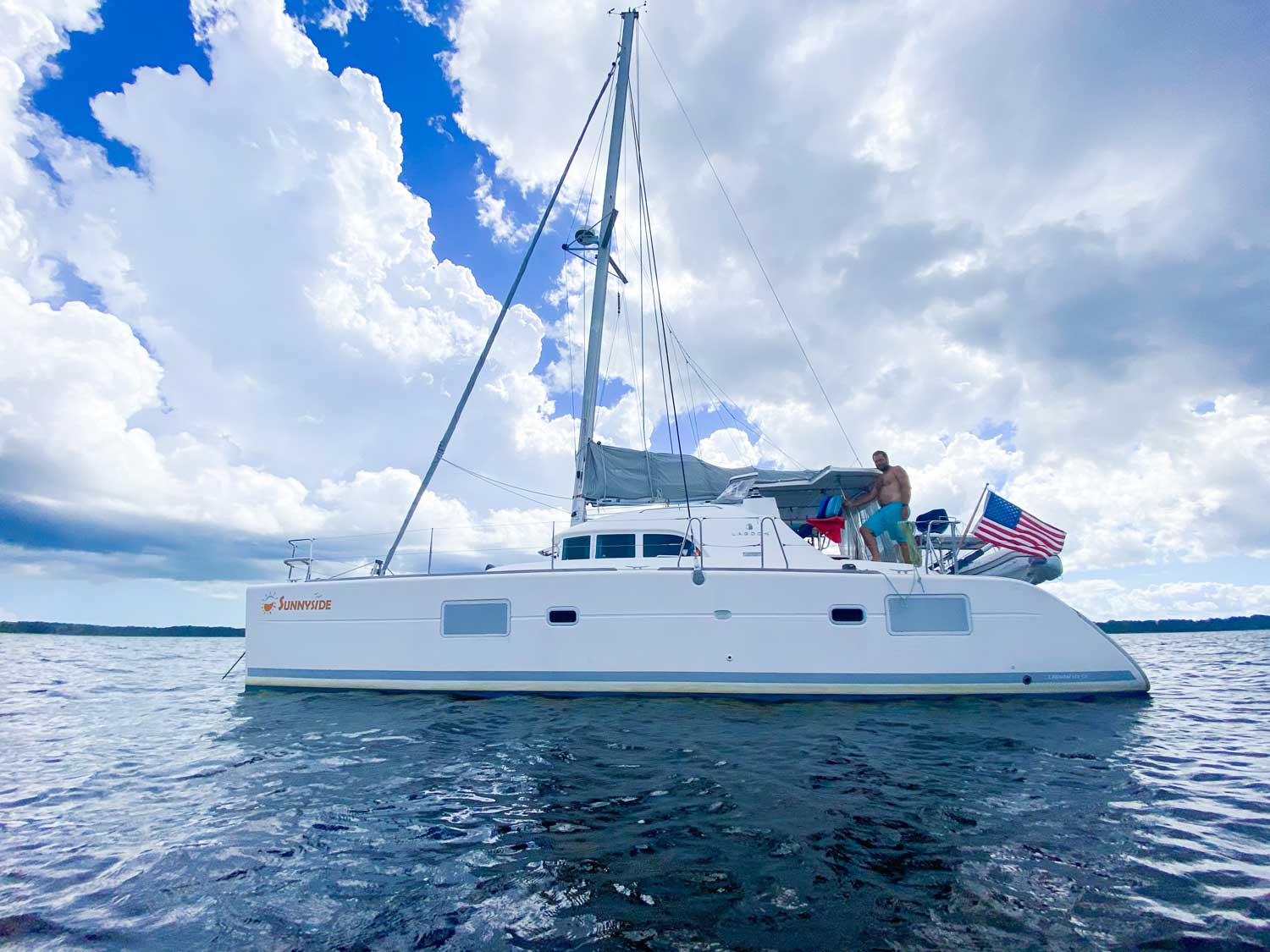
How much does it cost to live on a boat? This was my biggest question when we were planning and saving to cruise. I was clueless when it came to creating a budget for our future life aboard. I was looking for someone to tell me exactly how much it would cost ME to live on a sailboat full-time.
I quickly learned some people cruise for less than $1,000 a month and some for upwards of $10,000 a month. Most are somewhere between.
Not so dissimilar from living on land, different people cruise on all sorts of budgets.
For us, our cost of living on a sailboat isn’t so far from our land-based spending.
Part of this journey was learning to live with less, but we still maintain some creature comforts on the water.
Here is a breakdown of our cost of living on a boat full-time while cruising the US east coast.
Cost to Live on a Sailboat
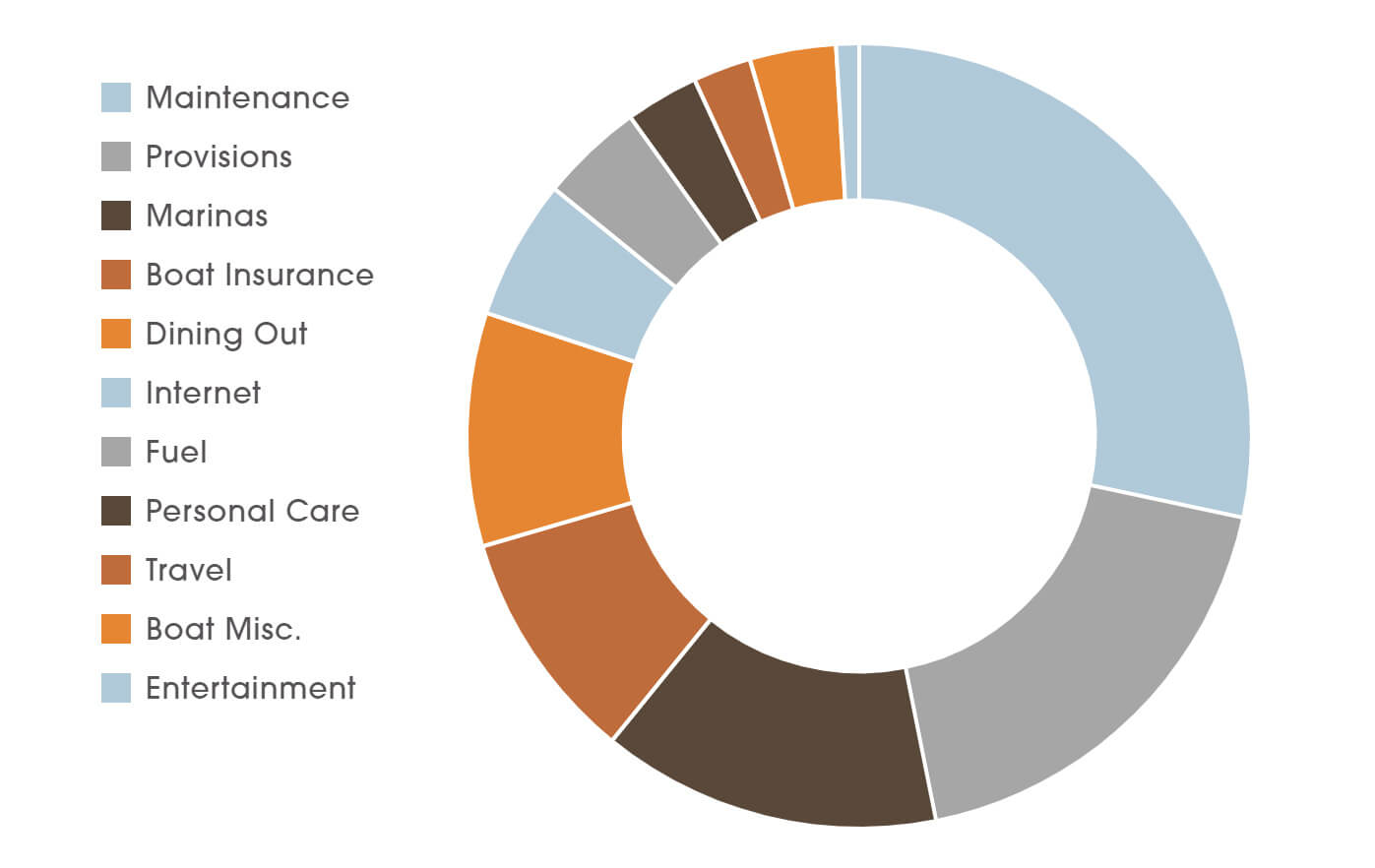
Average cost of $2,424 per month*
Sailboat Maintenance Expenses
Average cost $1,006.
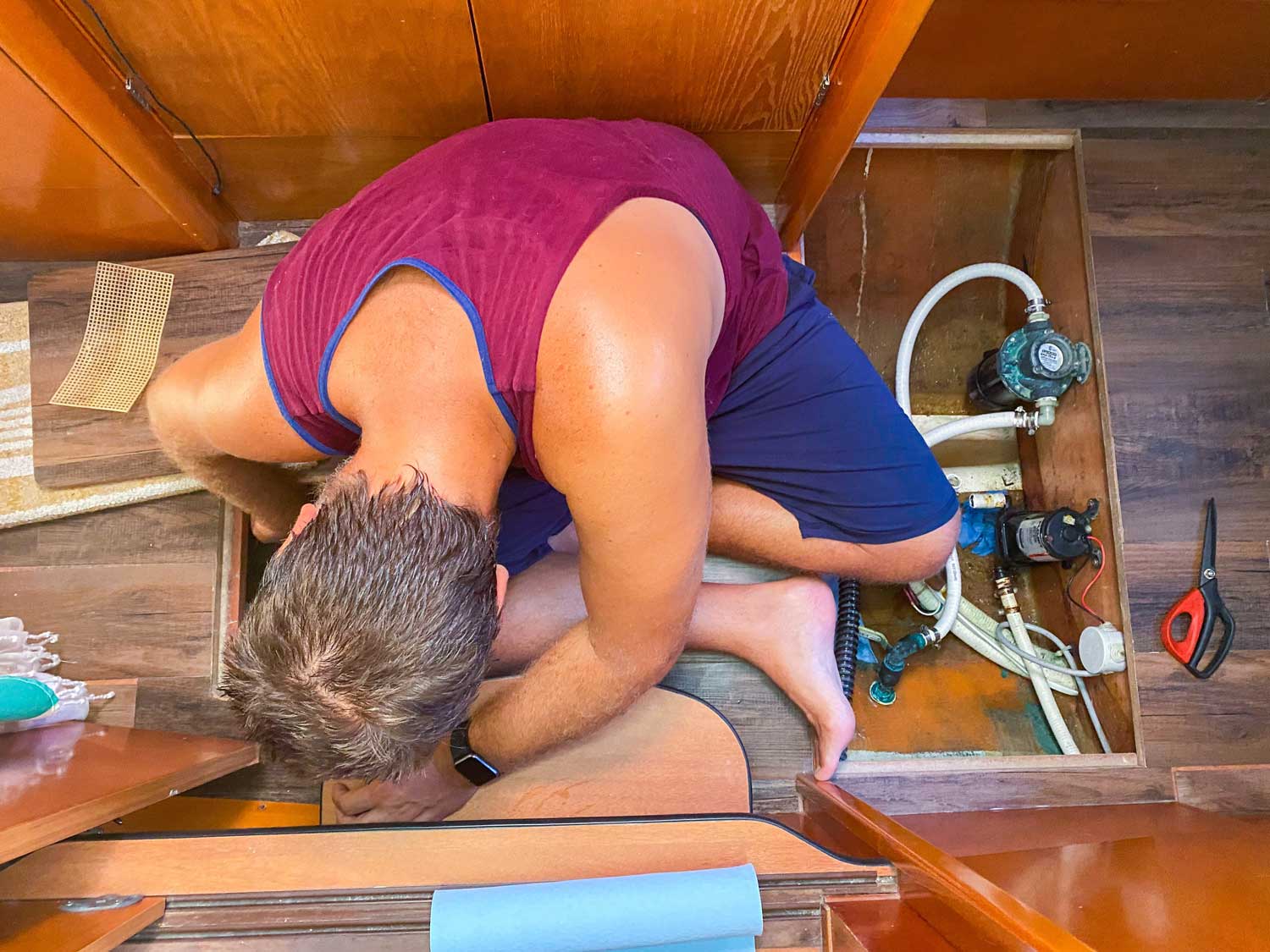
Maintenance, Parts & Tools ($687)
It’s no surprise boat maintenance is top of the list.
You will continuously be fixing broken things or maintaining things on a sailboat. You will also need different tools, spare parts, cleaners, etc., as you cruise.
There will be months when you won’t need much in the way of tools and parts (especially if you already have a lot of tools and spare parts onboard). Then in one month, you might spend 40% of the annual budget.
We make a strong effort to do most boat projects ourselves.
Shortly after we began cruising, our wallets learned the hard truth of paying people to work on your boat.
Since then, we’ve been our own plumber, mechanic, seamstress, and electrician.
You’ll always be learning. But if you can maintain and fix your vessel, you’ll save boatloads of cash (pun intended, I couldn’t resist).
READ NEXT: Check out our 9 Helpful Things You Need in Your Sailboat Tool Kit .
Insurance ($233).
If you are a newbie cruiser, your boat insurance options will most likely be limited. Insurance was a considerable expense in our first year. In our second year, the cost dropped from 2.8% of the boat’s value to 1.3%. (We now have restricted cruising grounds for July – November.)
Do your research and consider using a broker. Get quotes based on where you’ll be cruising and staying in hurricane season.
Miscellaneous ($86)
The miscellaneous category is everything else boat-related. This includes any small purchases we make for the boat (ex. rug for the salon), our USCG documentation, Amazon Prime membership, etc.
We also have a Boat US membership , which more than pays for itself. We get dockage and fuel discounts often. And, of course, the towing service is priceless when you run aground with only one engine. (What, just me?)
For a modest fee, this membership is a no-brainer for boat owners.
Marinas vs. Anchoring
Average cost $339.
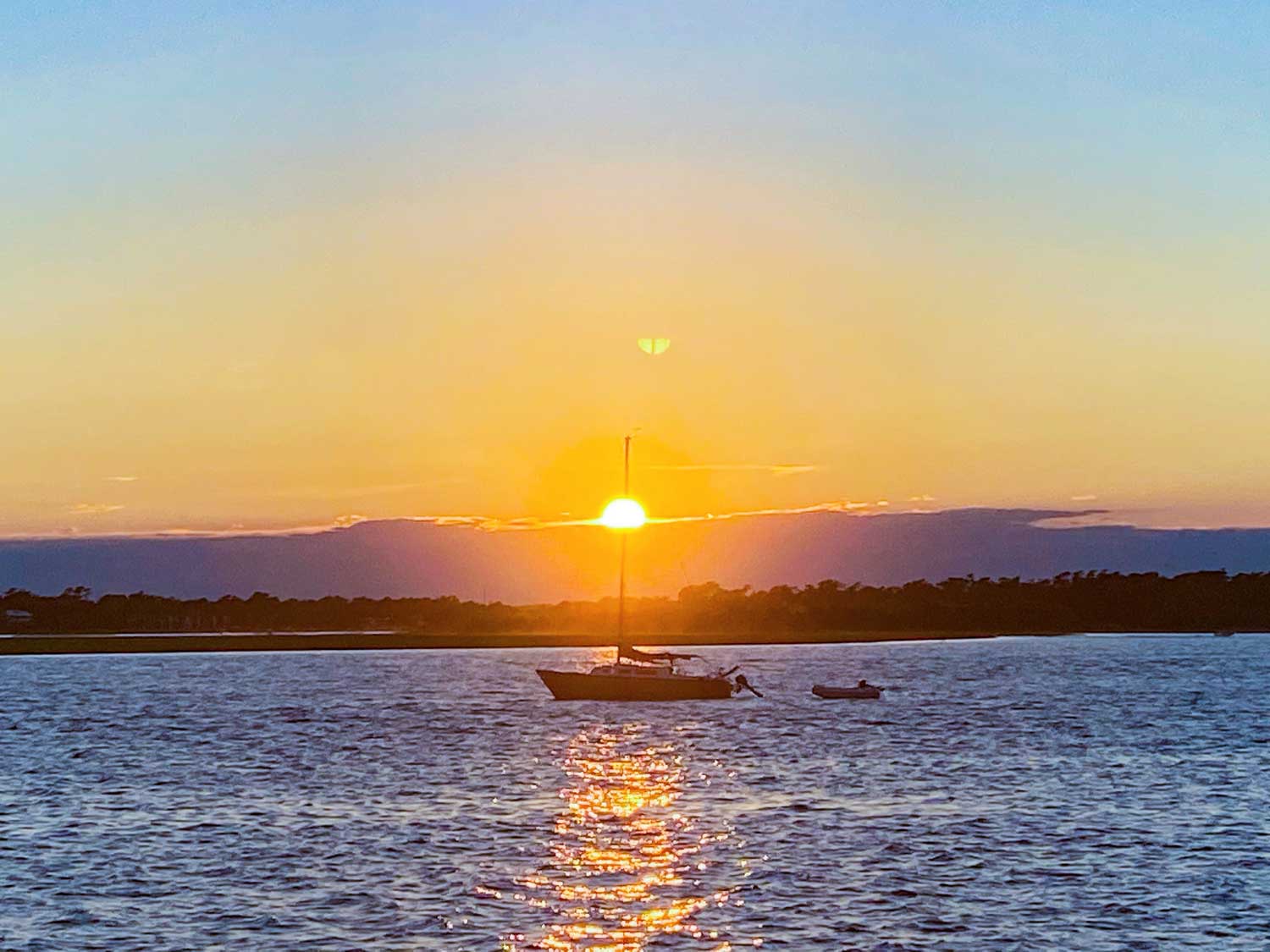
Marina Costs
If you’ve been researching the cost of living on a boat, you know it is more economical to anchor than to dock in a marina slip. We love anchoring out, but it does come with a set of variables that dictate comfort and safety while you’re on the hook. Not to mention, it requires a lot more planning.
Marinas can be expensive, especially in popular cruising areas. Dockage is usually charged per foot, so the bigger the boat, the higher the costs associated with docking fees. However, you can find liveaboard boat marinas with slip fees that are paid monthly.
Many cruisers prefer to dock at a liveaboard marina during hurricane season and save anchoring for cruising season. This allows you to keep your cost per night at marinas down, and your overall costs balance out throughout the year.
READ NEXT: Check out our post on Liveaboard Marinas: Finding the Best One for You .
Anchoring challenges.
Dreaming of our cruising days, I had the idea we would anchor out and rarely pay for marinas.
In reality, that’s not what worked for us out of the gate. Being beginner sailors and newbies to cruising and boats in general – there was an enormous learning curve.
Learning to live this lifestyle is not always easy. And yes, marinas make it easier. Especially when you REALLY need it to be easier.
Anchoring out requires the captain to always be “on”. You must be aware of the weather, wind direction, currents, and tides. You also have to be aware of the boats around you. None of this stops when you leave the boat or when you sleep.
The reality is you need to slowly become more comfortable living on the hook.
With experience, you can build more confidence.
You’ll become more comfortable with boat systems, weather, and making repairs while on the anchor. Conserving power and water becomes more natural, and you learn how to stay warm in the cold and cool off in hot weather. With some practice, you can spend less time (and money) at marinas.
For folks dreaming of this lifestyle, I’m not saying you won’t be able to start living on the anchor immediately. But the stress level accompanying living on the hook will lower with time and experience.
Average Cost $449
Provisions are consistently one of our most significant expenses on the boat.
Anticipating my new life on the water, I knew I wanted to learn more about cooking, baking, and making things from scratch. And since we planned to live on a smaller budget, I also wanted to be conscious of spending on food.
A game I often play with myself is to see how long we can go until the next big provisioning trip.

You might be thinking – that sounds miserable. But we eat pretty darn well most of the time.
We ration veggies and fruits, ensuring we leave the hardiest for last. We start with fresh salads and other raw veggie meals, such as cilantro hummus bowls. As the freshest veggies thin out, we work our way to curries and stir-fries. Then, when the fridge grows empty, we move on to rice and bean dishes, pineapple and jalapeño pizza, and bean tacos with pickled onions and cabbage.
One skillset you develop living on a boat is the ability to eat more sustainably.
Learning to make bread, yogurt, and vegetable broth from scraps is super satisfying.
Spend time learning to make flexible meals. Use a balance of fresh, canned, and dried ingredients. Do this, and you can stretch your provisioning budget without sacrificing flavor.
You can also save money by minimizing disposables, such as paper towels, sandwich bags, plastic wrap, and aluminum foil.
READ NEXT: Check out our ideas for Flexible Meals on a Boat and our Best Zero Waste Swaps for Small Spaces .
Having sundowners is a bit of a staple in the boating community. It’s a common way to meet and greet other boaters in a marina or in an anchorage. Given that, we always like to have a few extra beers onboard or the ingredients for a simple cocktail.
We love good wine, but we managed to find some enjoyable boxed wines. (Bonus, lose the boxes at the dock, and there’s very little trash to contend with.)
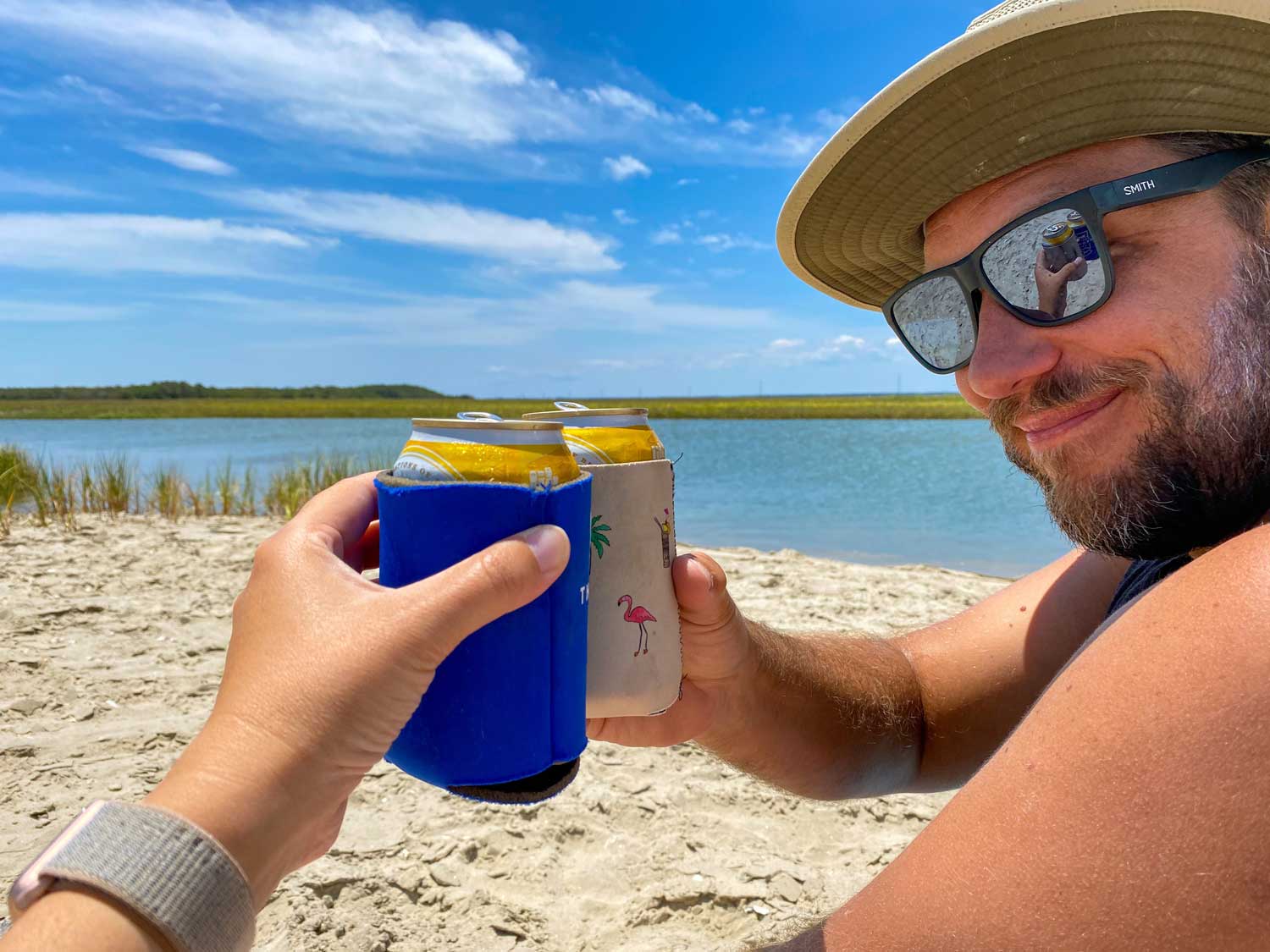
When we find a deal, we stock up on beer. Nothing hits the spot like a cold beer after the anchor drops. We even discovered a reasonably priced rum we enjoy. (No boat is complete without rum!)
Expenses here are based on personal taste. For us, it was possible to have more affordable beverages and still enjoy sundowner traditions!
Average Cost $233

As a couple who dined out regularly in our Colorado ski town, it was going to be tough to start cooking three meals a day living aboard.
I read a lot of advice that said, “if you like eating out, you probably won’t stop eating out because you move on a boat.”
There is truth to this. Whenever we are in a place where eating out is convenient, we tend to fall back into old habits.
However, when we dock in remote places or anchor away from shore access, there is less (or no) opportunity to eat out.
Instead, we experiment with different types of food to make meals onboard rewarding.
We still enjoy going out to experience the local cuisine, but it has become a treat instead of how we live.
A great way to cut costs is by dining out for a late lunch rather than dinner or skipping the alcohol. Opting for a refreshing drink on the trampoline while watching the sunset isn’t a bad way to close out a night.
Average Cost $103
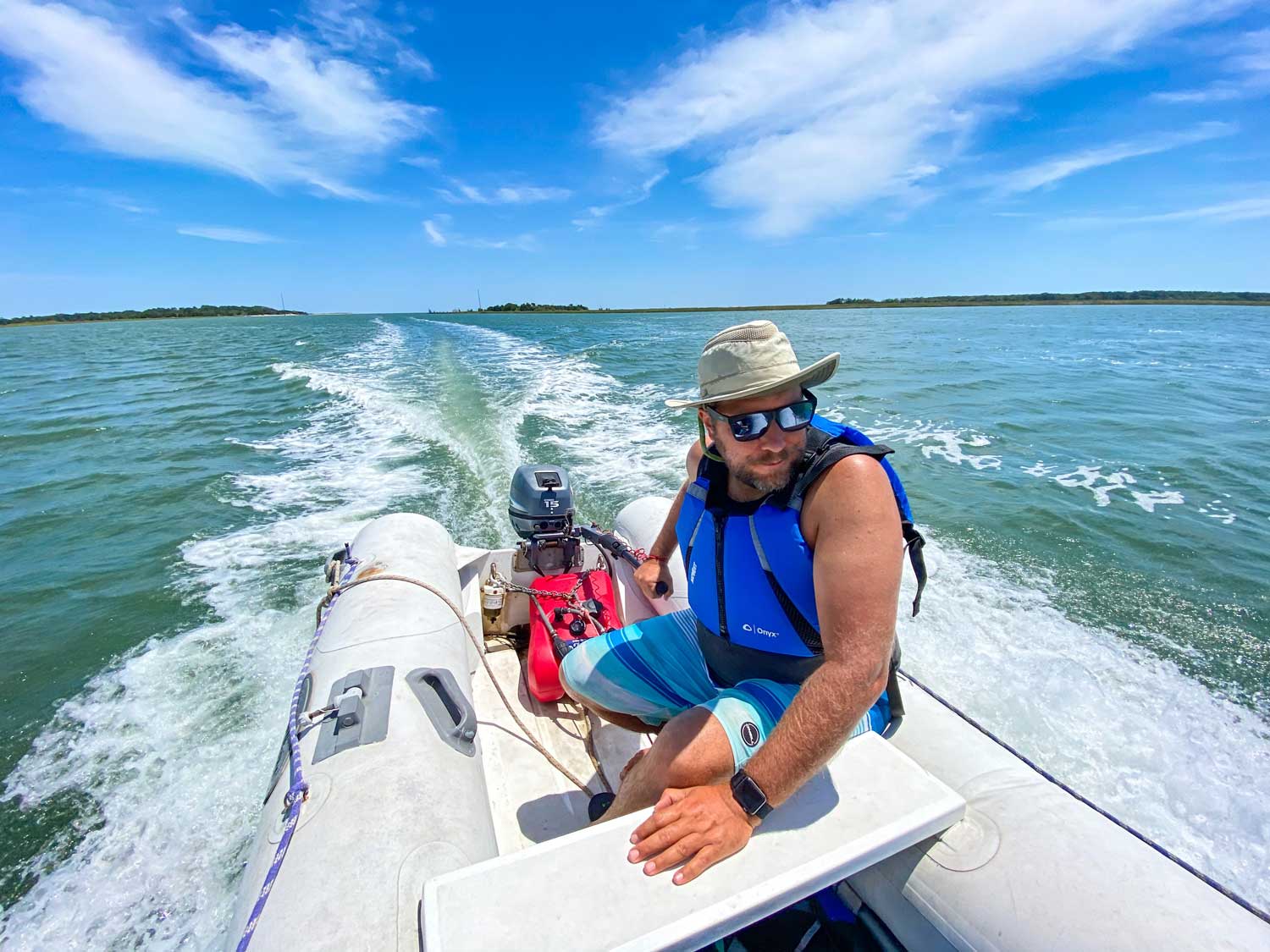
Diesel, gas, and propane are three resources you will continuously be aware of while living on a boat.
Here are a few adjustments we make to maximize our fuel efficiency.
- We use our sails. This isn’t easy as new sailors on a big boat. We have slowly become more confident, but it took us months of traveling on the water to start getting comfortable using the sails. We are still learning.
- We don’t put ourselves in a position where we are in a hurry or have a schedule. This almost always leads to running the engines more.
- We run on one engine. We can run one engine instead of two on our catamaran and only lose about 1 – 1.5 knots. On the ICW, we unfurl the jib to improve speed if the wind is right.
- We always make sure to travel at an optimal time for the current. Some areas of the Intercoastal Waterway can have a current that’s pushing 2-3 knots. Choosing a departure time around the current makes a big difference in travel time and fuel efficiency.
- Heating water with the electric kettle if the engines are running or we are on shore power.
- Using hot water from the engines (when we have it) to get water boiling.
- When cooking pasta, we use a minimal amount of water. We’ll often turn the propane off and let the noodles finish cooking in the hot water.
- Quality cookware makes a big difference. Once brought to a boil, some dishes can finish cooking with the lid on. This is helpful when coming into an anchorage. Often, I’ll kill the propane, and by the time we are anchored, dinner is ready.
- If we plan to make a few trips to shore, we’ll anchor closer to the dinghy dock. This doesn’t always work out, but being conscious of it has helped us stretch our gas budget.
- If it’s a short trip to the dock and we aren’t carrying supplies, we use the kayak. Paddling is free (and fun)!
Average Cost $140

When we were saving for the cruising kitty, we found ways to cut our mobile bill by using data on our home and work WiFi. When we moved aboard, our phone plan became the primary internet source. We quickly realized we would need to rethink our data plan.
There are a lot of options for unlimited data in the US, as well as hotspot data. I recommend having at least unlimited mobile data for research and logistics involved when cruising. If you need to work from the boat, you may also want to invest in an additional mobile service as backup or satellite internet. Starlink is starting to become popular in the boating community.
Our Mobile Plan
While cruising the east coast, we use T-Mobile. With this carrier, we get unlimited data and 40GB of hotspot data each month (20GB per phone). This is on the pricier end, and we have been looking into other options, but we enjoy having the hotspot data. Even after the 40GB, we still have hotspot data at 2G. When we cruise the Bahamas, we are planning to use My Island WiFi service .
Entertainment
Average cost $23.

This category is for consumable entertainment since most other entertainment on the water is free.
Music, movies, and books are popular forms of entertainment onboard. Even when we cut down on spending, we kept a few options that provided these services. Instead of ditching all the monthly streaming apps, we looked hard at our memberships and cut back or found free services to supplement.
- Spotify membership for music (we can download or stream) $11
- Movie library on an external hard drive created before we ditched our DVDs Free
- Hulu (included with Spotify) Free
- Disney Plus (prepaid for three years during a special offer) $4
- Nexflix (included with T-Mobile plan) Free
- Tubi (a free streaming app) Free
Spotify and Audible are great for downloading books and playlists for when you are out of service or on passage. You can also download movies and shows through many streaming apps for playback when you don’t have a signal or are running on a budgeted amount of mobile data. An external hard drive of your favorite movies is also a great source of video entertainment that will never let you down.
Personal Care & Clothing
Average cost $73.

Hair & Skin Care
Go more natural with skin and hair care. Most boats won’t have spare power for hairdryers and straighteners. On top of that, the sun and humidity will destroy makeup.
Start now researching ways to simplify your personal care regimens. It will make the transition abroad much easier.
Tips for Hair & Skin Care
- Get a tinted moisturizer with SPF for your face (I like Raw Elements ), a flexible eye shadow, and waterproof mascara. Opt for reusable makeup remover cloths to cut down on waste.
- Work on a natural look for your hair, and see if you can find a style you can cut yourself. Shampoo and conditioner bars are a great way to save space and are typically made with clean ingredients that won’t harm sea life.
- Opt for a simple personal care routine. The fewer products you use, the more space, time, and money you’ll save.
- We love to use UPF clothing in combination with sunscreen. The more you can cover up, the less sunscreen you’ll need.
For us, this area is where expenses remain similar to land life. There are no unique expenses with health or dental care, although finding healthcare coverage for multiple states can be challenging.
For the lady sailors, I recommend researching ways to have a zero-waste period. A menstrual cup is something I wish I had transitioned to before cruising. It will make your life easier, plus save you money and storage space.
If you can minimize laundry and wash some stuff on board, you can limit the need to find a washing machine.
Tips for Laundry on a Boat
- Wear clothes that are easy to wash and dry and can be worn several times between washes.
- In the summer months, wear UPF synthetics and bathing suits that can be washed by hand. This will also extend their life.
- In the winter months, wear merino wool and dress in layers to get the most wears out of your clothes before washing.
- Save sheets, towels, and bulkier clothing for when you have access to a washing machine. We aim to do machine washing about once a month.
Having a solid system in place for handwashing clothes helps limit our laundry budget. We average $8 per month spent on machines.
We try to buy high-quality clothing that is durable for boat life. Once you’ve created a boat wardrobe that works, you’ll find there is little you will need.
In six months, the only clothing I have purchased is a UPF shawl, a sun hat (to replace one I lost overboard), and a tank top. I previously spent a lot of money on clothes. Now I enjoy dialing in a functional, minimalist wardrobe for living on a boat.
READ NEXT: For more on clothing for boat life, check out What to Wear Sailing and How to Downsize Your Wardrobe .
Average cost $58.

For us, our travel budget for many years has consisted of only credit card membership fees. These help us earn points that pay for our travel.
Booking a flight or rental car without worrying about how it affects the budget is a nice perk in this lifestyle. There are times you need a car to get a project done or to book a last-minute flight to visit family.
We also get an annual travel credit with the Chase Sapphire Reserve credit card. We use a lot of the credit toward Ubers and Lyfts – great for when grocery stores aren’t within walking distance or you need to make a larger provisioning run.
Getting Started With a Cruising Budget

Here are some final thoughts when creating your future sailboat cruising budget.
- The above expenses are based on actively cruising on our 38-foot catamaran. For us, extended time at the dock is just a redistribution of funds. Maintenance and fuel go down, and marina expenses go up.
- Our maintenance costs are at about 4% of the hull value. Aside from the trampoline, we have not replaced any big-ticket items, so we expect this percentage may increase over the next couple of years.
- If you hope to stretch your cruising kitty, give yourself time to overcome the learning curve. Learning to maintain, operate, cook, and just be on a boat will take time. As you get more experience, your spending habits will improve. Be patient and keep moving forward.
- I highly recommend you continue researching and reading as much as possible about the cost of living on a sailboat. Get perspectives from different cruisers. This will help you create a cruising budget that will be unique to you.
Other Resources
- Gone with the Wynns created a very detailed article and video that breakdowns their cost of living on a boat.
- Sailing Kittiwake also has a great video on the cost of living on a sailboat on a budget .
*Costs not included in this overview are health insurance, taxes, business expenses, and gifts or donations. These expenses are particular to each individual’s situation and so are excluded from this article.
Want more tips on how to get started cruising on a boat?
For more information on the reality of boat life and tips for living on the water, view our complete guide.
Like this post? Save it on Pinterest for later.
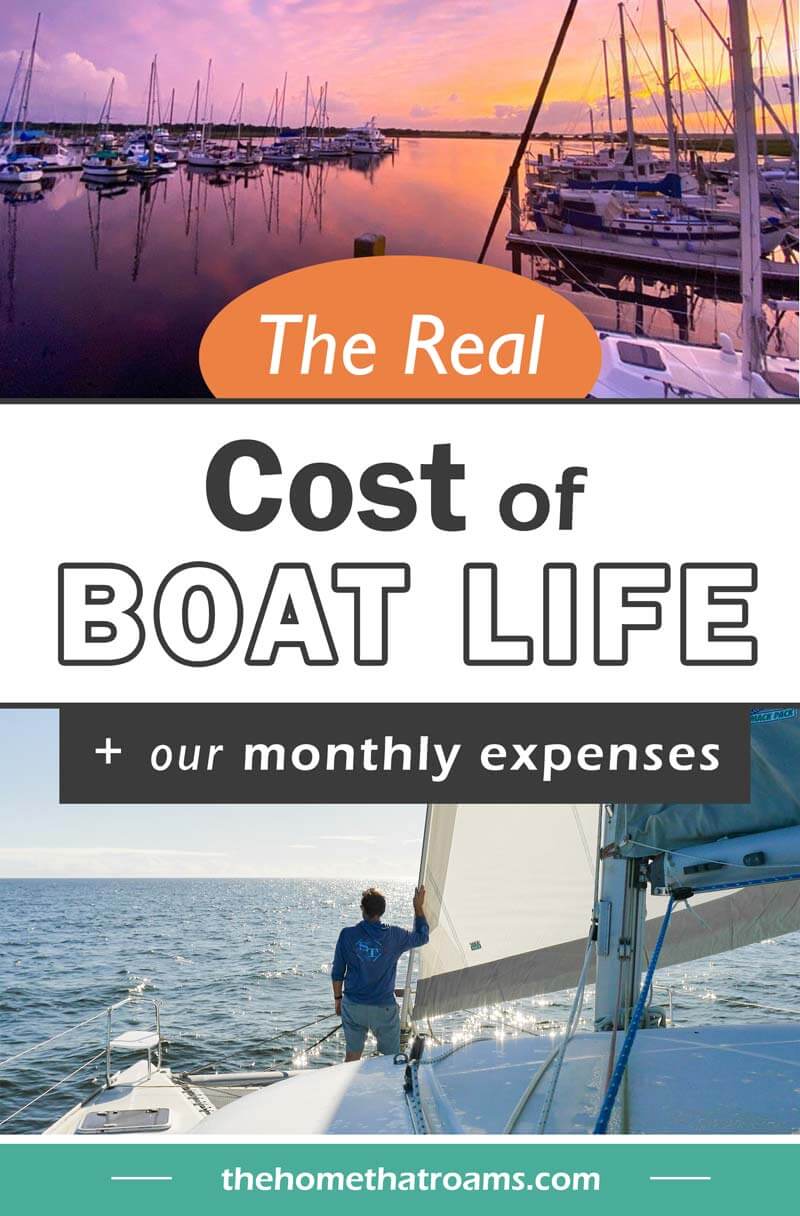
Or view our web stories.
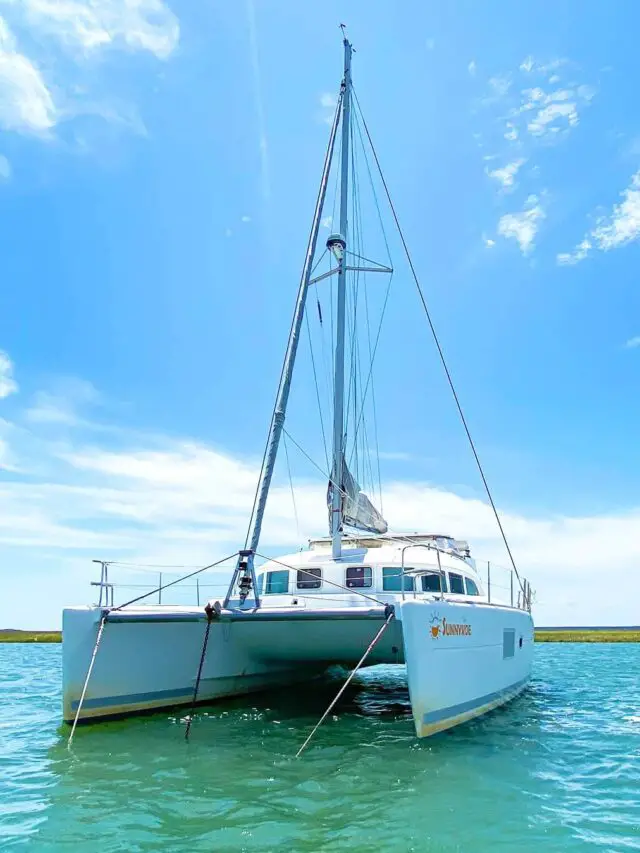
Morgan, the founder of The Home That Roams, has been living nomadically for over five years. She began her journey traveling across the U.S. in a motorhome and cruising on a liveaboard sailing catamaran. Currently, she lives full-time in a travel trailer, sharing resources on RV living and boat life to help others downsize their lives and thrive in an alternative lifestyle.
Excellent article. Thank you!
I started getting the urge to return to the sea not long after I got out of the Navy in 1974…. Started out on a 15′ Phantom…. Up to 21′ Keels, up to a 26′ Bristol and finally a 28′ Newport…. You learn alot of tricks of the trade at a working marina… Barter system, I used to go up the mast or anything Aloft in return for favors with anything that I had a problem with …. Had to give up the sailboat when I couldn’t sail it by myself anymore … Looking for a 35′-38′ trawler to live in the Tampa Bay area for the rest of my day…. From the Sea I came, back to sea I will return … Anchor’s Aweigh….
Hi George, it sounds like you have lived and breathed boats for a while! One of my favorite things about a good liveaboard marina is how everyone trades boat maintenance favors and helps each other out. I sure hope you find a good trawler to liveaboard in Tampa – sounds lovely!
Do you use a specific budgeting software or anything to track your transactions? Please share if so
Leave a Reply Cancel reply
Your email address will not be published. Required fields are marked *
Sign Me Up!
Learn how to live on a boat.
Get weekly tips on how to start traveling full-time on a boat.
View our privacy policy .
Privacy Overview
| Cookie | Duration | Description |
|---|---|---|
| cookielawinfo-checkbox-analytics | 11 months | This cookie is set by GDPR Cookie Consent plugin. The cookie is used to store the user consent for the cookies in the category "Analytics". |
| cookielawinfo-checkbox-functional | 11 months | The cookie is set by GDPR cookie consent to record the user consent for the cookies in the category "Functional". |
| cookielawinfo-checkbox-necessary | 11 months | This cookie is set by GDPR Cookie Consent plugin. The cookies is used to store the user consent for the cookies in the category "Necessary". |
| cookielawinfo-checkbox-others | 11 months | This cookie is set by GDPR Cookie Consent plugin. The cookie is used to store the user consent for the cookies in the category "Other. |
| cookielawinfo-checkbox-performance | 11 months | This cookie is set by GDPR Cookie Consent plugin. The cookie is used to store the user consent for the cookies in the category "Performance". |
| viewed_cookie_policy | 11 months | The cookie is set by the GDPR Cookie Consent plugin and is used to store whether or not user has consented to the use of cookies. It does not store any personal data. |


Home » Blog » Live on a boat » Is living on a boat right for you?
Is living on a boat right for you?
By Author Fiona McGlynn
Posted on Last updated: August 16, 2023
Living on a boat sounds cool, but is it right for your lifestyle?
With real estate rocketing in cities like London, San Francisco, and Vancouver, a lot of people are ditching their pricey digs for a more adventurous and alternative lifestyle: living on a boat.
Living on a boat can afford you all kinds of benefits: cheap rent, amazing views, and may make you a more interesting person at dinner parties (results not guaranteed).
We lived on a boat for five years and it was a good choice for us, but it’s obviously not right for everyone. So, before you walk out on your sofa bed and five roommates, there are 10 things you should know.
You can save a lot of money on rent!
Is living on a boat cheaper? Yes! Living on a boat is cheap . We spent two years living on a sailboat in a marina in Vancouver with a full suite of amenities (power, parking, high-speed internet access, laundry, showers, workshop) and it only cost us $550 a month in liveaboard slip fees (our next best option would have been an apartment for $1100+).
If you choose to live on a mooring ball, it can cost you even less! In San Diego, we paid $150 a month for a mooring ball.
Usually, the cheapest place to live on a boat is at anchor, which is often free.
Of course, we had to buy a boat (that cost us around $10,000) but over two years, we more than got our money back. By avoiding high rent, we were able to save enough to set out on a three-year trip, sailing 13,000 nautical miles from Vancouver to Mexico to Australia.

Some sample liveaboard budgets:
How much money do you need to live on a boat? It depends on your location, boat, and how comfortable you want to be. We spent between $600- $2,000 a month while living aboard our boat.
- This young UK couple is living on a sailboat for £500 ($570) a month while cruising around the world.
- This young family from San Diego told Insider they pay $2,200 a month to live on a 40-foot boat.
- These San Franciscans are living on a sailboat and spend just a few hundred dollars a month on rent and utilities.
Cost of living on a boat
While living on a boat is very affordable, there are ongoing costs and living expenses to be aware of.
Liveaboard insurance
Liveaboard insurance rates are more expensive than recreational boat insurance. For our 35-foot sailboat we’ve paid:
- $800 a year for liveaboard insurance (sailing in local waters)
- $1,800 a year for liveaboard insurance while cruising (sailing internationally)
While some boat owners we met, didn’t carry insurance, most boatyards will REQUIRE you to have insurance (and will check your paperwork) before hauling your boat out of the water.
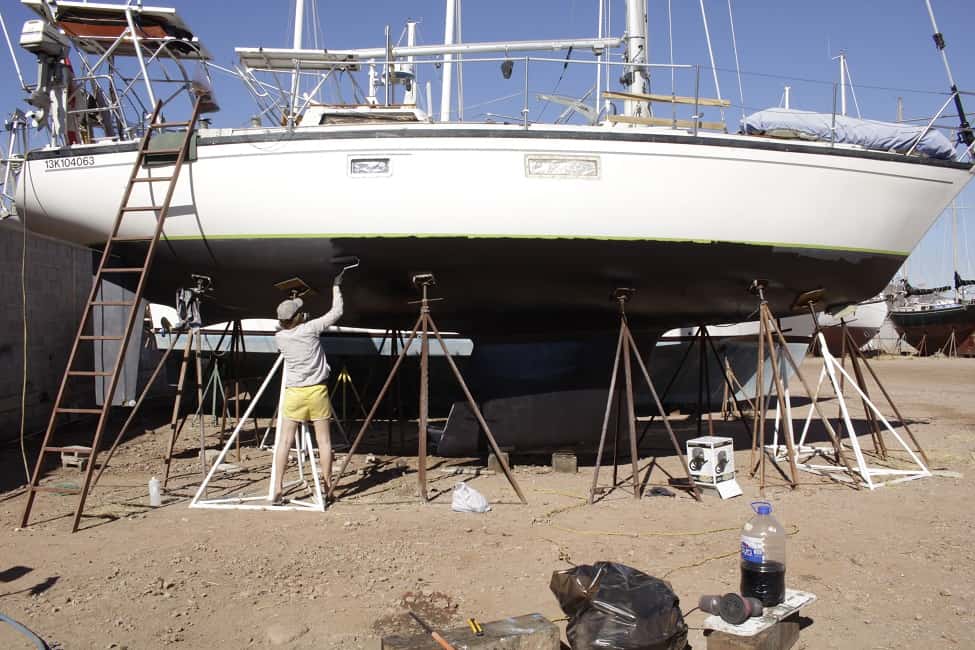
Liveaboard moorage
Liveaboard moorage generally costs more than recreational moorage. Between 2013-2018, we found it was typical to pay $550-750 a month.
Your electricity bill will be a fraction of what you’d pay living in a house. When you live in a very small space (like a boat) you’ll consume less electricity for heating and cooling, meaning you’ll have a lower bill at the end of the month.
You may need to run your engine to charge up your batteries or run high-draw appliances like a water maker or air conditioner. Be sure to factor fuel into your monthly budget.
Many boaters use solar panels or wind turbines which, while pricey upfront, allow you to disconnect from the grid altogether.
Most marine stoves run on propane or white gas, so you’ll want to budget for fuel if you plan on doing any cooking aboard.
Marinas sometimes charge for fresh water. Our boat was designed to hold 66 gallons (250 liters) and we refilled our water tanks once or twice a week. The average person in the US uses 80-100 gallons of water per day ! Refilling our tanks was a chore, so we got better at conserving water.
Another option is to buy a reverse osmosis watermaker which turns seawater into fresh water. We installed one when we were cruising but it cost us over $3,000. There are much cheaper alternatives to watermakers .
You will also have to think about pumping out your septic holding tanks. Many marinas have pump-out stations and charge for the service. In most harbors, it’s illegal to empty your holding tanks into the water.
Pumping out sewage is not only bad for the marine environment, but it also gives liveaboards a bad reputation. So, don’t do it!
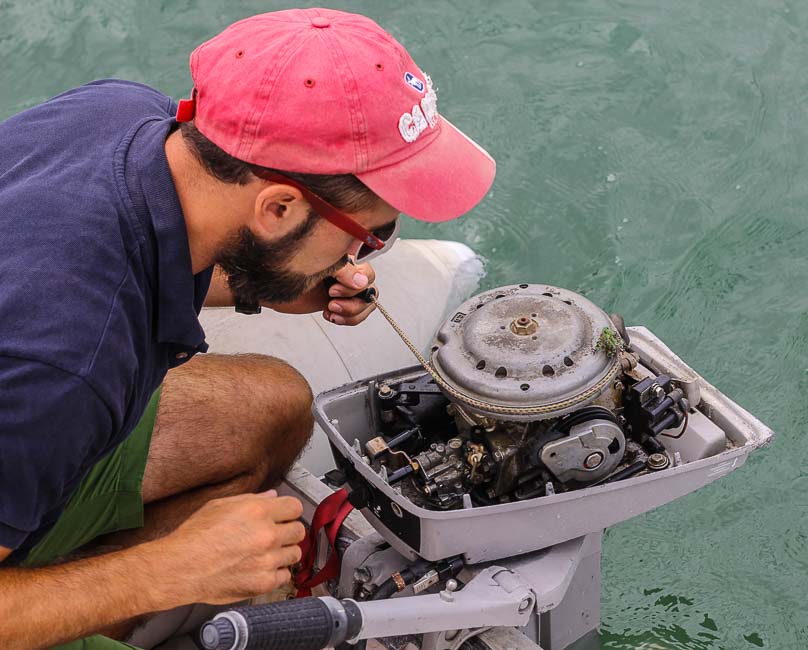
Maintenance costs
Boats are a lot of work, far more than a house. Stuff breaks all the time and you’ll need to be a good problem solver and ideally handy with tools. It’s hard work, but on the plus side, you’ll develop a whole bunch of new skills.
Your maintenance costs will depend on whether you’re doing the work yourself and the condition of the boat.
Generally, marine parts cost three to four times the price of household building supplies. A good rule of thumb is to budget 10% of the value of your boat in repairs, annually.
When boat shopping, remember that a cheap boat isn’t necessarily a good deal and may cost you a lot more in repairs over the long run.
You may get lucky and snag a cheap or free boat , but liveaboard boat prices can run into the six and even seven figures. If you finance your boat, you will have monthly mortgage payments.
Boat property taxes vary by location. E.g., Californians are assessed 1.1% of the vessel’s current value annually.
You can’t trick your partner into living on a boat.
For some people, living on a boat is a lifelong dream, for others, not so much. No matter how romantic you find the notion, do not attempt to live aboard if your partner is not game.
There are plenty of challenges: limited space, leaks, and potentially a lot of motion . Talk your partner into boat living and you may wake up one day to find they’ve jumped ship.
If your partner is on the fence, the best way to find out if moving aboard will work for you is to test-drive the liveaboard lifestyle before living on a boat full-time.

Buying a boat is easy, finding a place to put it—not so much.
It can be very challenging to find a place to moor your boat. The best places to live aboard a boat often involve waitlists and permitting.
Many big cities have liveaboard licensing requirements. As a result, liveaboard marinas often have multi-year waiting lists.
It’s a good idea to call your local marinas and find out if they have available liveaboard slips before searching for a boat.
You may find your anchoring options limited, too. In recent years, many jurisdictions have started cracking down on long-term anchoring, often introducing time limits and requiring anchoring permits.
Don’t buy a boat until you know where you’re going to keep it. Some marinas may turn a blind eye to “sneak-a-boards” but you’re really risking getting the boot at any time.
Some of the best liveaboard cities in Canada and the United States
- Alameda, CA
- The Chesapeake Bay Area
- Corpus Christi, TX
- Portland, OR
- San Diego, CA
- Sausalito, CA
- Seattle, WA
- Tampa Bay, FL
- Vancouver, BC
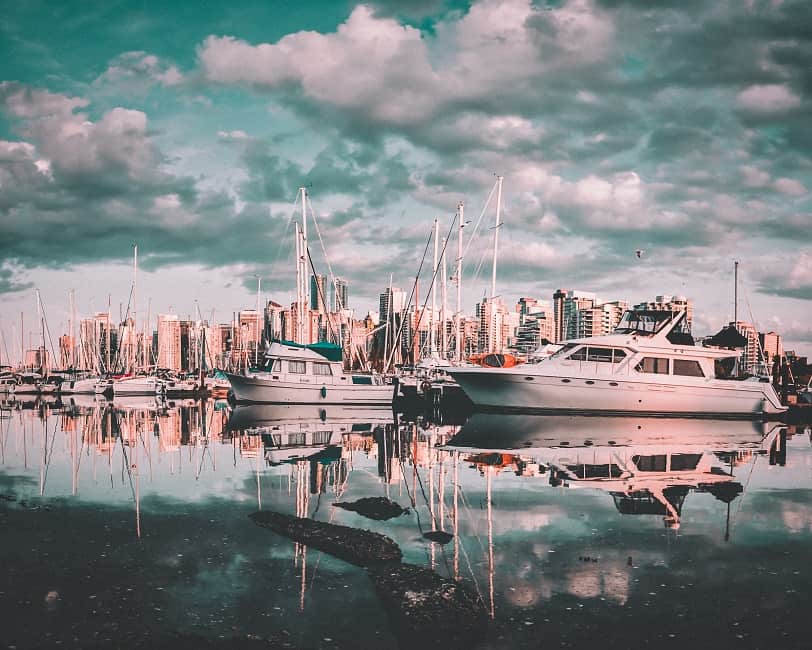
Marinas vs. mooring balls – location will affect your lifestyle
Living on a boat in a marina will be very different from living at anchor or on a permanent mooring buoy. Finding the best place to keep your boat will come down to a few factors.
Some important considerations are things like electricity and water (in a marina slip you will have 24/7 access to both, whereas on the hook you’ll be living off-grid). This can make a big difference, for instance, if you want to have a shower (especially a hot shower ) every day. Doable at a marina, difficult if not impossible on the hook.
Other benefits of dock life include being able to walk off the boat . Going back and forth in a dinghy every day can be a nuisance, especially if you’re transporting pets, bikes, and heavy gear.
If you plan on having a boat dog , easy access to the dock will be especially important.
Other perks of liveaboard marinas are comforts like internet, cable, and laundry.
Often marinas can offer better wave protection (e.g., with break walls), which becomes important in bad weather. In a boat slip, you don’t have to worry about your boat dragging anchor. Also, protection from high winds and wave action will make life aboard more comfortable (as compared with bouncing around in an anchorage).
There are so many factors to consider when deciding between a marina, mooring field, or anchorage (too much to cover here), so check out “Where to live aboard a boat?” for more info.

Personal space – who needs it?! Living on a sailboat versus a house
The number one question people ask us is, “How do you live on a sailboat and not kill your partner?” Unless you’re living on a luxury yacht, there is no personal space on a boat.
Imagine that every time you want to walk from the kitchen to the bedroom you have to ask your partner to move out of the way so you can pass, and that about sums it up.
Also, many boat heads are often less (ahem!) private. We had a CS 24 where the head was literally under the V-berth, which made it very awkward if you had to get up to pee in the night.
That being said, we quickly adapted to not having much space. We became more organized, tidier, and attuned to each other’s needs while living in close quarters.
If having less space is your number one concern, consider looking at trawlers instead of living on a sailboat as you get way more living space and light on a 35-ft. trawler, than you do on a 35-ft. sailboat.
Boats you can live on:
While in a technical sense, you could live on any boat with a cabin, the best boat to live on will offer house-like comforts including a galley (kitchen), head (toilet), and a comfortable berth (bed).
Ideally, it will also have liveaboard essentials like solar panels, a cabin heater, and a big battery bank. Though you can always add these later.
Obviously, the size of your boat is an important consideration. As a single person, you may be able to get away with living on a small boat (e.g., a 24-footer) whereas the best liveaboard for a family might be 40-foot plus.
6 types of boats you can live on
There are six different kinds of boats you can live on and they all vary in size, comfort, seaworthiness, and cost.
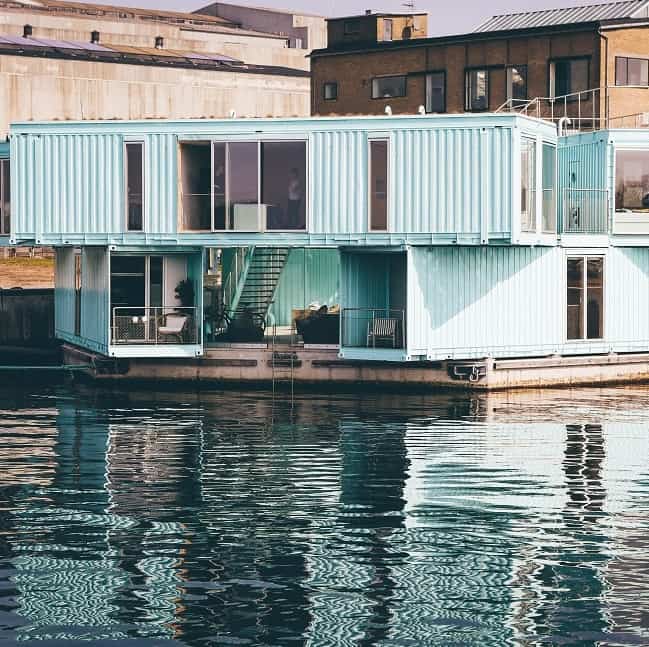
Floating homes
As the name would suggest, floating homes are a type of boat that will give you the most house-like living experience. However, they are generally permanently moored and not convenient to move or travel with. They can cost as much as land-based houses to purchase.
Houseboats or canal boats
Houseboats and canal boats offer space for comforts like a full-size fridge and kitchen. They’re great for travel in protected waters and in the case of houseboats, can even be beached on the land.
Tugboats and Trawlers
Tugboats and trawlers have decent headroom and can accommodate comforts like big-screen TVs, full-size kitchens, showers, and sometimes even bathtubs. As most living space is above the waterline, they also tend to have lots of natural light.
Sailboats are a bit like the basement apartment of liveaboards and often do not have fridges, showers, or hot water. However, they also generally cost a lot less to purchase than motor vessels and you can travel long distances without fuel costs.
Catamarans are double-hulled sailboats that allow you to sail around the world in comfort but come with a significant price tag. The bridge between the two hulls creates plenty of open airy living space up top with bunks down below in the hulls. However, not only are they expensive to purchase, but they also take up twice the space and require twice the rent and maintenance cost.

The big compromise: creature comforts
Most inexpensive liveaboard boats do not have hot showers and laundry . They also have tiny bathrooms, kitchens, and hardly any storage space.
If you can’t bear the thought of giving up bubble baths, then living on a boat full-time is not for you. If, however, the idea of a minimalist, multi-purpose, stacking dish set cranks your gears – then you’re probably on the right path.
Making the most of small spaces can be a lot of fun if you’re up for the challenge.
Bear in mind, that some boats will be better set up for living aboard than others (we have a list of the best boats for living aboard) .
You will have the coolest neighbors
Boat living tends to attract some interesting people: artists, musicians, and engineers. Nick Cave and Rod Stewart both lived aboard in the U.K., as did Alan Watts in Sausalito.
Boat life also fosters a very tight sense of community. You’re far more likely to get to know your neighbors (which we think is a good thing!) .
Bring your home on weekend getaways
Who needs a second home when you can take your first home with you? Perhaps it’s kind of obvious but it’s great to throw off the dock lines and go cruising on the weekends.
It should go without saying, but learn to sail (and be competent with your boat) before moving aboard. Not only will you need to be able to move your boat around for safety and practical reasons (e.g., going to and from the gas bar) but also it’s a wonderful activity.
While living on our boat we got to visit so many beautiful places in our local Pacific Northwest waters. As we gained sailing experience, we began to think about traveling farther afield.
Many of our liveaboard neighbors were experienced bluewater cruisers. They inspired us to embark on a sailing trip to Mexico and the South Pacific and gave us a lot of help along the way.
If you think you might like to buy a bluewater sailboat and go cruising or sailing around the world, living aboard is a great first step towards that dream.
Leaks and climate control will become your obsession
It’s a lot harder to live on a boat during the cold winter months.
Boats leak. If you live aboard in a wet city you’re guaranteed to wake up one morning with a soggy pillow or mystery puddle on the kitchen counter thanks to a leaky hatch or deck fitting.
Mold is another basic fact of life aboard and can become a major issue. Many full-time liveaboards opt to run dehumidifiers and heaters to keep humidity in check.
The good news is that both leaks and humidity are totally manageable if you stay on top of it.
If you live in a place with extremely cold winters (regular freezing temperatures) it gets even harder. For instance, on the lakes in Ontario, Canada, it’s sometimes necessary to run bubblers to prevent ice damage to the dock and boat.
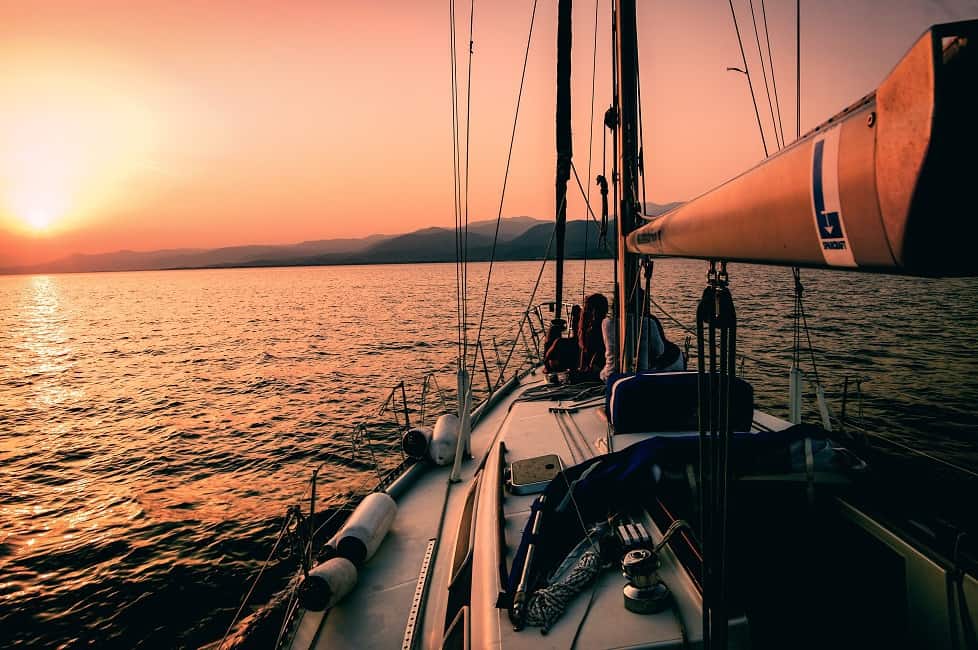
The best view in the city
If the idea of living on the waterfront has always appealed to you, living aboard is a way to get those breathtaking views on the cheap.
It’s cliché but the best thing about living aboard is settling into the cockpit at the end of the day with a cup of tea or glass of wine and watching the sunset.
We found life on the water infinitely more peaceful and a great escape from the bustle of city life. If you’re up for an adventure, living on a boat full-time can be a great way of life.
Fiona McGlynn is an award-winning boating writer who created Waterborne as a place to learn about living aboard and traveling the world by sailboat. She has written for boating magazines including BoatUS, SAIL, Cruising World, and Good Old Boat. She’s also a contributing editor at Good Old Boat and BoatUS Magazine. In 2017, Fiona and her husband completed a 3-year, 13,000-mile voyage from Vancouver to Mexico to Australia on their 35-foot sailboat.
Sarah Smith
Friday 2nd of April 2021
Thanks for explaining that catamaran sailboats are going to be comfortable and provide a lot of living space. My husband and I had thought that we could only live on houseboats, but with your information, I would like to start looking into the catamaran sailboats. We'll have to find a luxury boat hire so that we can live on the water for a bit and decide what we would like to buy.
Friday 29th of January 2021
That is so amazing that even including parking, internet, and showers, living on a sailboat only costs $550 a month. My husband and I would like to downsize and explore now that we have both graduated college. We'll start looking for a sailboat and open parking spaces.
What if someone wants to live on a motor yacht as a live aboard, just moored at the marina. Not sailing around due to fuel consumption, just living in it. Could that be an option. I was thinking of looking into the 75 to 100' range for motor yacht but for live aboard moored. is it possible? Thank you for this article it was very informative. I am a Canadian from Ontario, currently living in Vancouver now. Thanks again.
Hi Jordan. Most live aboard marinas (the exception being floating home communities) have rules that the vessel has to be able to move under its own power. So as long as your yacht had a working engine, you would be fine. Having lived aboard in Vancouver, I think you might have trouble finding a 75 to 100' slip to moor your boat in. Most slips fall in the under 50 foot range. Thanks for reading and good luck in your search!
Friday 9th of February 2018
Thanks for the insight! We're trying hard to get liveaboard status at our marina in Sausalito and having the toughest time. Hoping persistence wins!
Thursday 1st of March 2018
Keep up the hustle! It's can be tough to find a spot but so worth it when you do. I seem to remember there's a bylaw that requires all SF marinas open 10% of their spots to liveaboards. I could be wrong but might be worth looking into. Also, we loved Valejo Yacht Club - great community run yacht club and they had spots a couple of years ago. Keep us posted on how it goes. Lots of our readers are SF based. If you wanted to guest post on your experience finding a spot in SF, that would be a very interesting read.
Friday 4th of August 2017
No worries, I searched the image on google and found that a mutual friend posted it on his photography website. I was just curious.
Terms and Conditions - Privacy Policy
Cost of Living On A Sailboat (Monthly Breakdown)
The cost of living on a sailboat full-time is approximately $1,880 per month or $22,560 per year.
Please keep in mind that the cost of living on a sailboat can vary depending on your specific location, the condition of the vessel, the size of the boat and your boating experience.
The cost of living on a sailboat can be broken down into 9 monthly expenses including:
- Boat Marina Fees
- Boat Insurance Cost
- Boat Maintenance Fees
- Fuel Expenses
- Grocery Costs
- Boat Gear Costs
- Entertainment Costs
- Internet Costs
- Miscellaneous Costs
Below is a cost of living on a sailboat table summary.
| Expenses | Cost (Per Month) |
|---|---|
| Marine Insurance Cost | $55 |
| Maintenance Cost | $250 |
| Marina Fees | $10 to $20 per foot |
| Fuel Costs | $150 |
| Entertainment Costs | $200 |
| Internet Costs | $100 |
| Grocery Costs | $450 |
| Miscellaneous Costs | $125 |
| Boat Gear Costs | $100 |
1. Boat Marina Fees
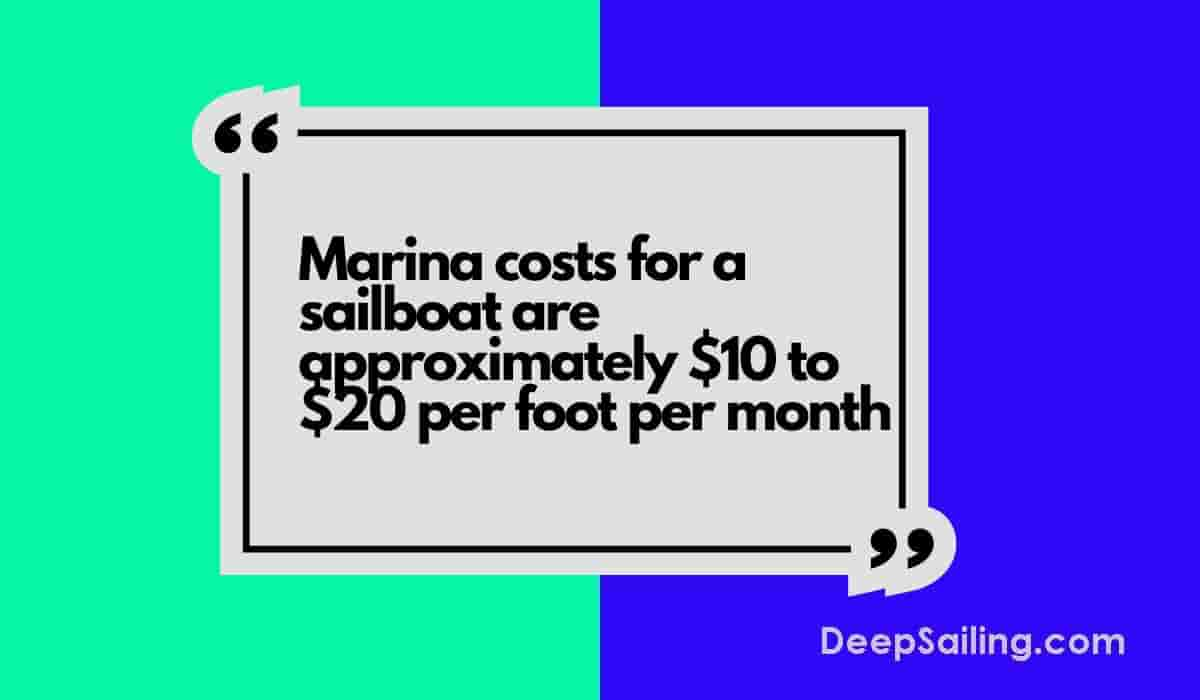
The first cost to consider when living on a sailboat is the marina fees/slip fees.
The marina costs for a sailboat are approximately $10 to $20 per foot per month.
For example, a sailboat owner with a boat size of 30 feet will typically pay between $300 and $600 per month in slip fees to stay at a marina.
A marina will charge a boat owner on a per-foot basis based on the length of the vessel.
The size of the boat and the location of the marina will have a large influence on the price charged to boat owners with marinas in Florida typically being the most expensive in America compared to other locations.
Paying marina fees gives boat owners access to boat cleaning services, electricity, internet access, pump-out services and facilities, waste removal services and a marine store.
Some boat owners prefer anchoring which is free of charge. Anchoring can be the best option during warmer months from April until November when marina facilities are needed less.
Boat marina costs can be reduced by mooring in cheaper marina locations, only using the marina when necessary or anchoring the boat off the coast away from the marina.
2. Boat Insurance Cost
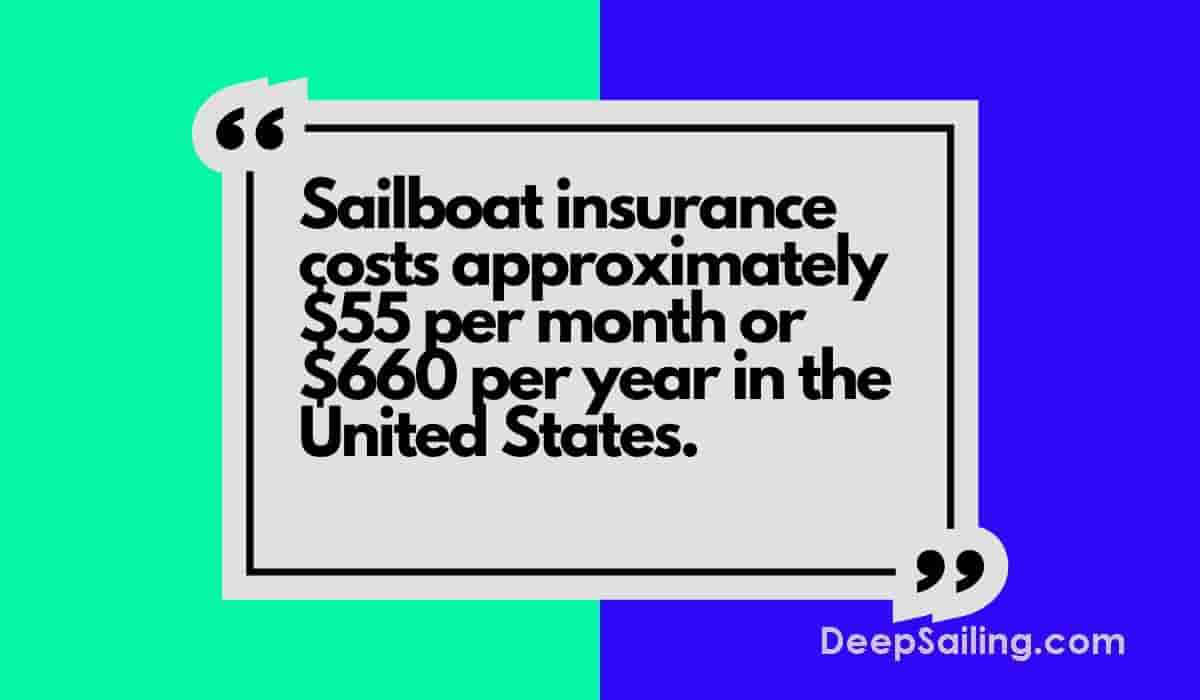
The second cost to consider when living on a sailboat is the boat insurance fee.
The cost of sailboat insurance is approximately $55 per month or $660 per year.
This is an approximate cost for the average sailboat owner living onboard their vessel in America.
According to Progressive , the annual Progressive boat insurance policy cost for the insurance policies they issued to boat owners in America ranged from $250 to $700 per year.
To get an accurate boat insurance cost for your specific sailboat, contact marine insurance providers for quotes.
The cost of boat insurance will vary based on the size, location and condition of the sailboat as well as a boat owner's experience and claims history.
Typically, the boat insurance cost will be 1% to 4% of the total retail value of your sailboat.
Boat insurance is the most expensive in locations that suffer from hurricanes like Florida and Texas.
Boat insurance costs can be reduced by browsing insurance providers, using cheaper sailboats, using the boat in lower-risk areas and increasing your boat experience.
3. Boat Maintenance Costs
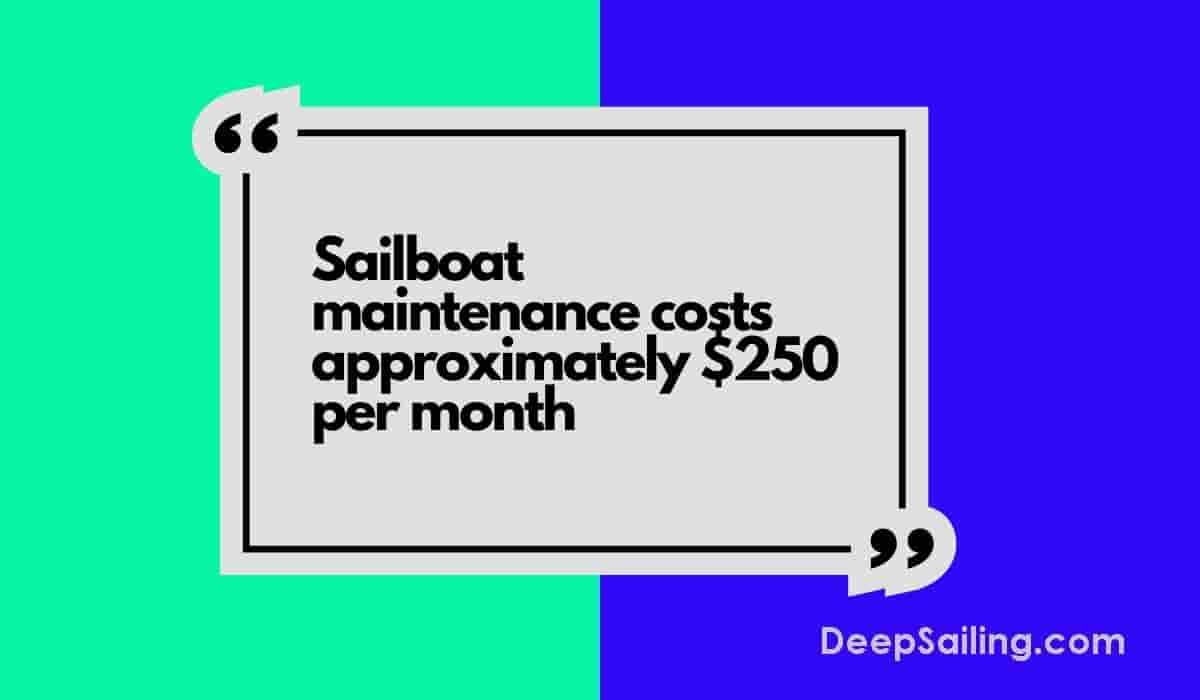
The third cost to consider when living on a sailboat is the maintenance cost.
The average cost of sailboat maintenance is $250 per month or $3,000 per year.
A sailboat's maintenance cost can vary based on the condition, size, age and location of the sailboat as well as the boat owner's experience with repairing and maintaining the boat.
Boat maintenance cost includes paying for spare parts, cleaning supplies, boat paint, engine services, repairing fridges, electronics, lines, cookers, windows, seats, toilets, deck materials etc.
Boat maintenance costs can be reduced by using second-hand parts, manually repairing the sailboat yourself and treating the boat with care.
4. Fuel Expenses
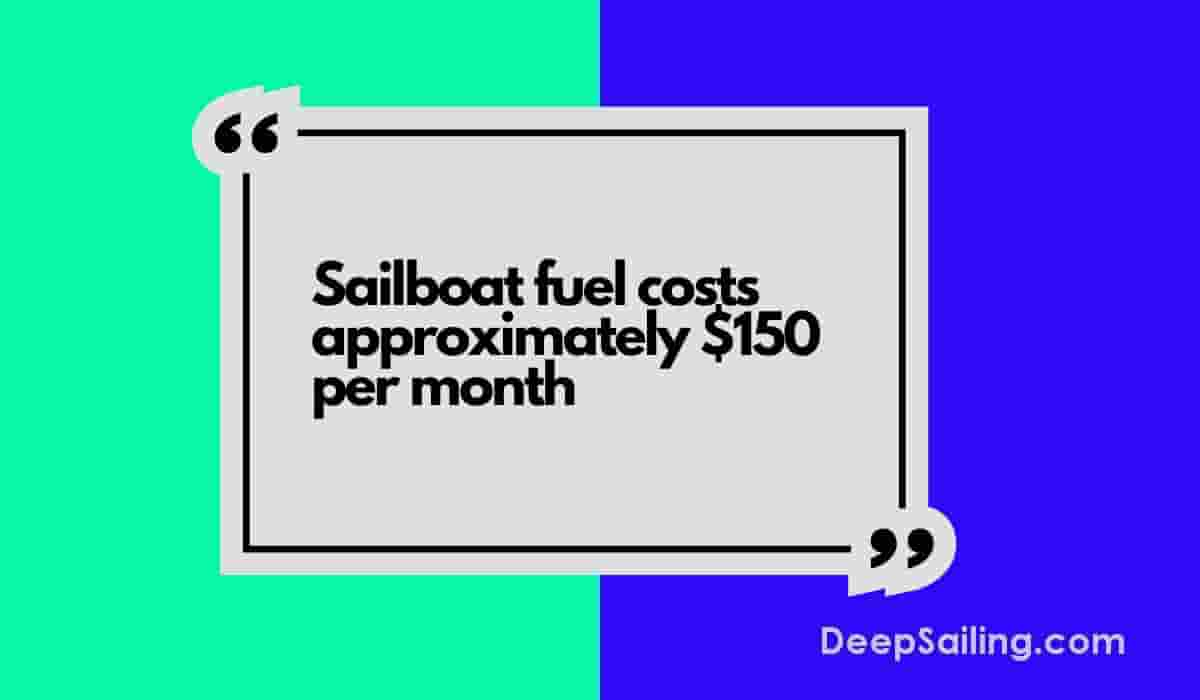
The fourth cost to consider when living on a sailboat is the fuel cost.
Sailboat fuel costs approximately $150 per month or $1,800 per year.
Sailboat fuel costs include paying for diesel or gas for the boat engine and buying propane fuel for sailboat heating and cooking while living onboard.
The factors that affect the sailboat fuel costs are the location, weather, size and condition of the boat as well as the frequency of use.
In the winter, sailboat fuel costs tend to rise whereas they are cheaper in the months from April until September.
To reduce the fuel costs of a sailboat, use the sails more often rather than the boat motor. Sailboat fuel costs can also be reduced by only traveling when it is the optimal time for the current which can make a large difference in fuel efficiency.
5. Grocery Costs
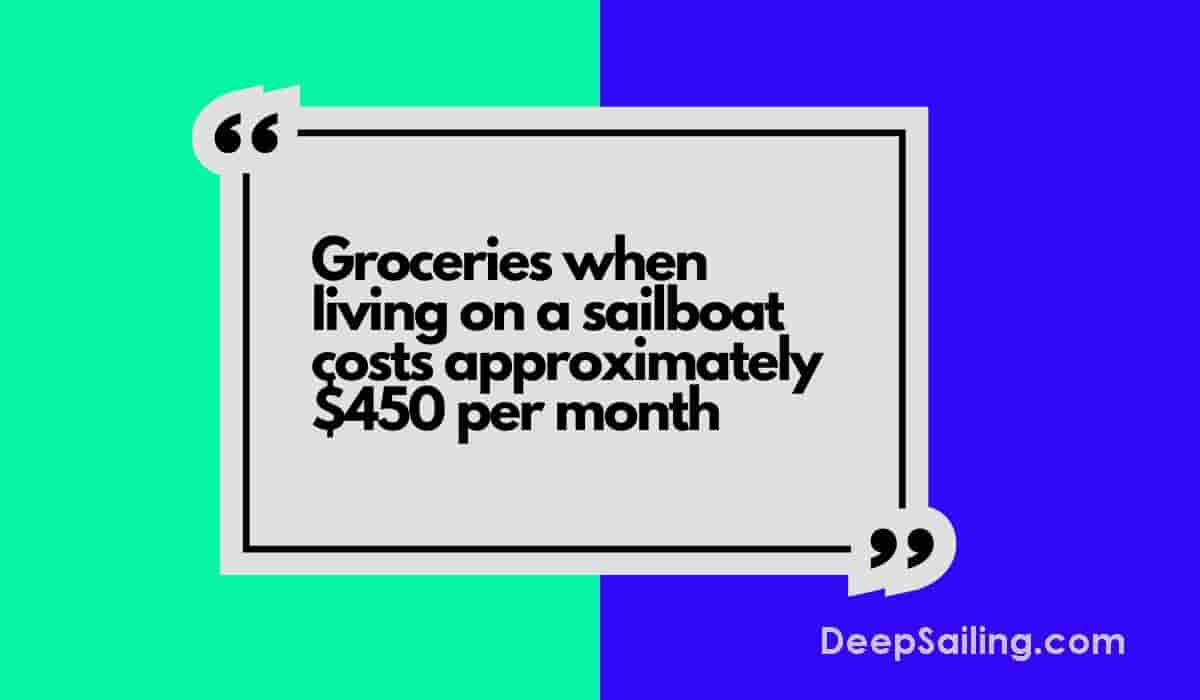
The fifth cost to consider when living on a sailboat is the groceries cost.
The cost of groceries when living on a sailboat is approximately $450 per month or $5,400 per year.
Grocery costs include paying for food, drinks, bathing supplies and kitchen cleaning supplies.
The grocery costs remain the same year-round. To reduce the grocery costs when living onboard a sailboat, boat owners can choose to catch fish by fishing from their boat. However, this will only cause a small reduction.
A saltwater-to-freshwater converter can be used to get a fresh supply of drinkable water without having to spend money on buying drinks. This will only cause a small reduction in costs too.
6. Boating Gear Costs
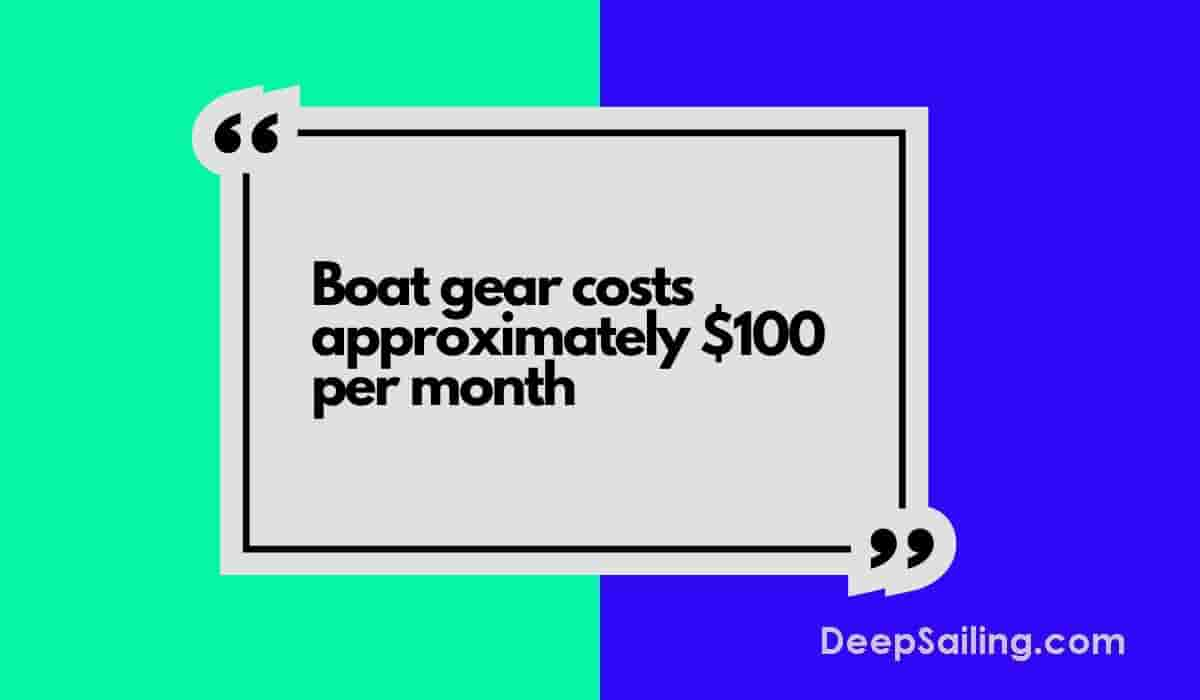
The sixth cost to consider when living onboard a sailboat is boating gear costs.
The approximate cost of boating gear when living on a sailboat is $100 per month or $1,200 per year.
Boating gear costs include paying for gear like sailing sunglasses, sailing jackets, swim gear, fishing gear, sunscreen, wetsuits, sailing hats, fire blankets, and general boating accessories.
The boating gear cost is the most expensive in the winter months when extra sailing clothing is needed to keep warm.
To reduce the cost of boating gear, take good care of your current boat gear to ensure it lasts longer and purchase high-quality boating accessories that will last for a long time.
7. Entertainment Cost
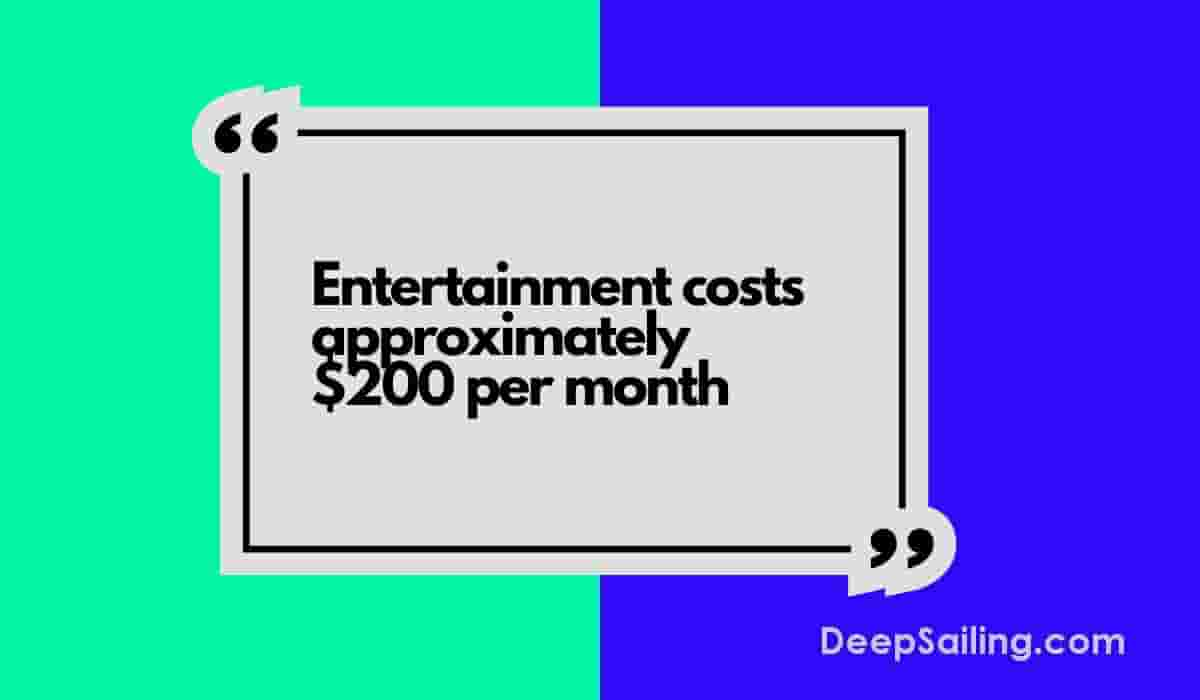
The seventh cost to consider when living onboard a sailboat is the entertainment cost.
The cost of entertainment when living on a sailboat is approximately $200 per month or $2,400 per year.
Entertainment costs include paying for tv subscriptions, board games, dining out, trips to the cinema, etc.
The entertainment costs will not change throughout the year.
To reduce entertainment costs, find free entertaining activities to do rather than spend money for entertainment.
8. Internet Costs

The eighth cost to consider when living on a sailboat is internet costs.
The cost of the internet when living on a sailboat is approximately $100 per month or $1,200 per year.
Internet costs include paying for a 4G/5G connection or satellite internet connection. It includes paying for a wi-fi router to connect to the sailboat too.
To reduce the internet cost on a sailboat, anchor the boat at marinas with a Wi-Fi connection included in the slip fees.
9. Miscellaneous Costs
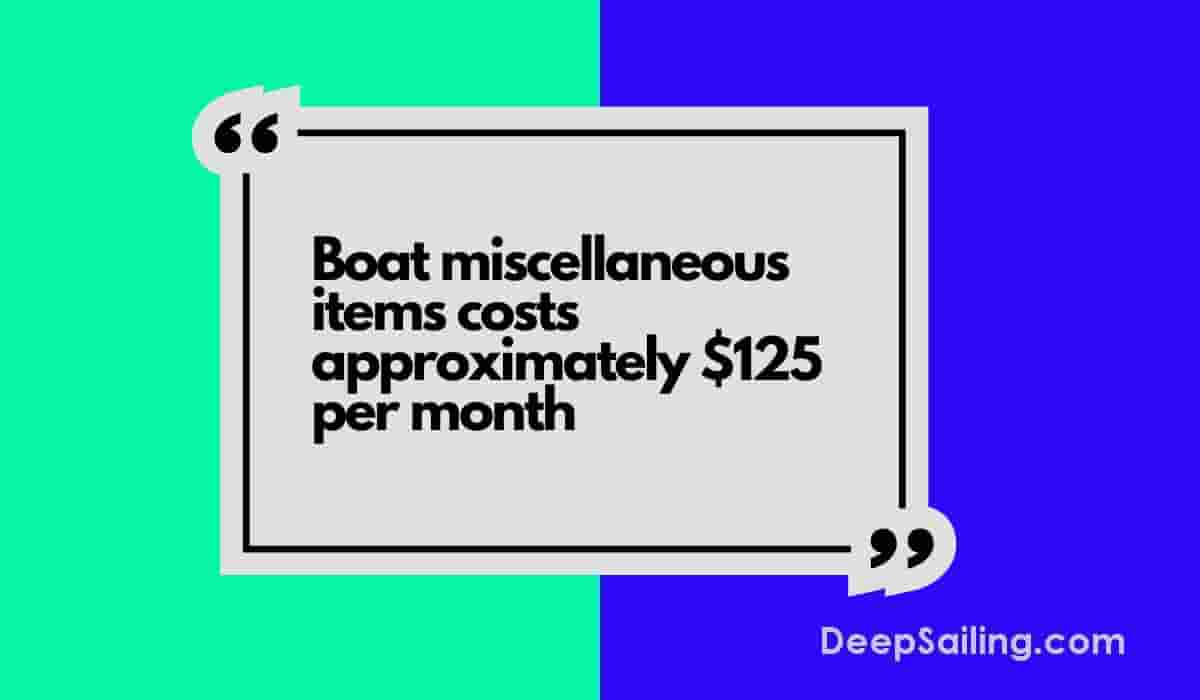
The ninth cost to consider when living on a sailboat is the miscellaneous costs.
The miscellaneous costs when living on a sailboat are approximately $125 per month or $1,500 per year.
Miscellaneous costs will typically remain the same throughout the year without much change.
Miscellaneous costs include costs associated with buying items like boat rugs, personal care items, boat care basics, coolers, boating decor, cooking utensils etc.
To reduce the miscellaneous costs, reduce the number of general boating items purchased and ensure the items that are purchased are of good quality so they last longer.
Frequently Asked Questions About The Cost Of Living On A Sailboat
Below are the most commonly asked questions about the cost of living on a sailboat.
How Much Does A Large Sailboat (Over 50ft) Cost To Live On?
The approximate cost to live on a large sailboat (over 50ft.) full-time is $3,200 per month or $38,400 per year.
What Is The Most Expensive Cost Associated With Living On A Sailboat?
The most expensive cost associated with living on a sailboat is the marina slip fees which are a monthly cost of $10 to $20 per foot of boat size.
How Can The Cost Of Living On A Sailboat Be Reduced?
The cost of living on a sailboat can be reduced by using the sails instead of boat fuel to power the boat when traveling, mooring the sailing vessel in a cheaper marina or anchoring outside a marina, browsing for cheaper marine insurance policies, ensuring care when using the vessel to keep repair costs low, downsizing to a smaller sailboat and keeping entertainment costs to a minimum by finding cheaper or free entertainment alternatives.

Sailboat Living: 10 Things To Know Before Moving On Board
Sailboat living can sound like the dream life, and in many ways it is.
Beautiful sunsets, the freedom to travel with your home, dolphins and crystal clear seas are all a huge part of the sailboat lifestyle , but anyone who tells you it’s an easy life has obviously never really lived on a sailboat!

There are times when sailboat living can feel more like a nightmare than a dream, and no matter how much you prepare there will always be a few troublesome scenarios that you just can’t predict.
However, with a little forethought and a lot of planning, there is a lot you can do to make the transition of moving from a house to a sailboat a relatively easy one.
If you’re prepared to put in the hard work now then we promise you will reap the rewards in the future. As we learnt the hard way, we’ve put together the top 10 things that everyone should know before they move onto a sailboat so that sailboat living for you can be 98% dream and only 2% nightmare!
As an Amazon Associate, we earn from qualifying purchases. We also earn from other affiliate programs. This means we may receive a small commission on products purchased through our links at no extra cost to you.
#1 A Sailboat Is Never Complete
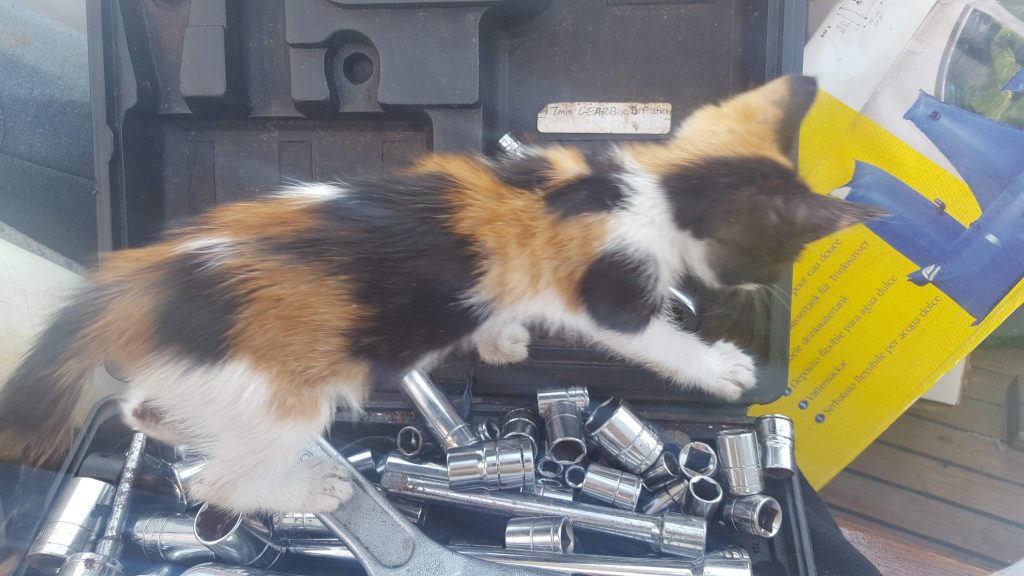
Learn this lesson fast!
Don’t expect to finish boatyard work and stop working. A sailboat breaks. Constantly. Some days it will feel as though your to-do list is endless because unfortunately, it is.
This was one of the things Adam and I were prepared for before we moved onboard our sailboat. After living on a boat in the UK we understood the crazy amount of work that has to go into maintaining something that’s constantly working.
I think a good way of looking at it would be to think of it as a house and a car combined. It has all the working parts of a house – the pipework, the electricity, the leaky windows etc.
It also has all the working parts of a car like an engine, the tires could be the sails, the lines, and all that goes along with them.
Add to that the fact that you’re putting it under huge amounts of stress at all times, in some extreme weather conditions, and you can see why things constantly fail!
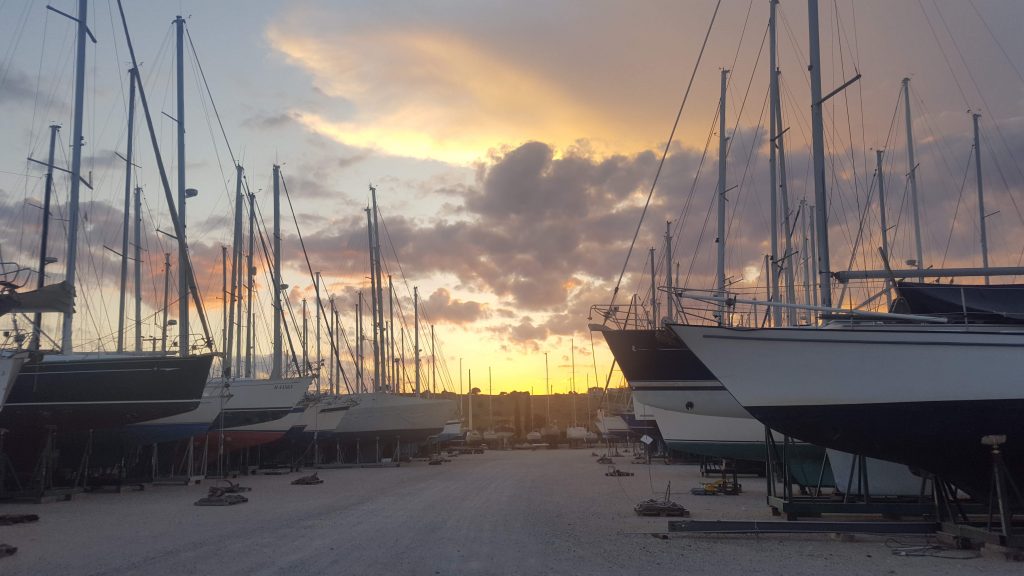
Adam and I spent the first few months of living aboard feeling as though we were just sailing from anchorage to anchorage to find chandlers so we could fix things. We made friends with some full-time cruisers who quickly put a stop to that!
They explained how if we actually wanted to enjoy time on board then we had to give ourselves time off the boat work. The broken things we could live with could wait a few days while we enjoyed a new destination.
Find out how much new sails cost
We now try to only do one or two days of boat work a week, which leaves us with a weekend ‘off’ when we’re working our jobs for three days. This suits us perfectly, but you’ll need to find a pattern that works for you to make sailboat living more enjoyable!
A bonus of living onboard is that you do have the extra time to dedicate to keeping the sailboat in tip-top condition.
Many weekend sailors find themselves with a long list of jobs at the end of the season, but (depending on how cheap/how lucky you get when you buy your boat!) if you get some jobs done every now and again through the season you’ll keep the long stints to a minimum.
#2 Sailboat Living = Tiny Space Living

Think of sailboat living as living in a glorified tent and you’ll be (partly) prepared! There is nothing glamorous about sailboat living!
You’ll be getting changed in tiny spaces where you may or may not be able to stand. You’ll be squeezing into the toilet or squeezing past people to use the kettle. It’s a juggling act, even when all your belongings are stashed away neatly.
Add to that the fact you’ll probably be ripping open cupboards every other day to find that essential item that was placed under all the other essential items and it becomes pretty hard to manage!
Our top tips for managing space onboard your sailboat are to downsize before you move in and to prioritise sailboat storage. It might be a hard thing to do to start with, but you’ll be so thankful you gave up all nonessential items before you even moved aboard.
It’s amazing how quickly you can fill a boat when you live on it! We have loads of handy tips on how to maximise limited space in our post on sailboat storage ideas – check it out before you start sailboat living!
#3 Water, Water, Everywhere But Not A Drop To Wash In

Get used to living frugally. We don’t necessarily mean your finances (though it is possible to live on a budget on a sailboat, check out what we spend monthly here).
Things like water and electricity are limited on a sailboat, especially if you’re spending the majority of your time at anchor.
Unless you have a sailboat watermaker (which we highly recommend splashing out on!) you need to get used to using as little water as possible . It’s not always easy to find when you live on the sea.
Get used to taking sea showers and washing dishes in saltwater. You can always rinse in freshwater, and washing in the sea really isn’t too hard once you’re used to it!
Set your sailboat up with a good way of making electricity as soon as you move aboard. You’ll want decent amounts of solar power and possibly a wind generator too, especially if you’re planning on spending time in countries that don’t see very much sunshine or spending winters at anchor.
You’ll also want to make sure you have a good battery bank for storing it over night, and you may even want to consider getting a small generator if you rely on power for things like charging laptops to work from.
#4 The People You Meet Will Be A True Highlight
The sailing community is what makes sailboat living. They are the most giving and generous community of people we have ever met and the best memories we have are the ones we spent with other cruisers.
It’s not always easy to meet other sailors while you’re living at anchor, so our advice is to make the effort and say hi where ever possible. People are always happy to share a drink or dinner, and a salty tale or two!
Meeting other sailors is also the very best way to learn more about sailing life. No matter how long people have cruised for they always have an experience worth sharing and learning from.
#5 The Weather Controls Your Life In Sailboat Living

We check the weather twice a day, every day. It may seem obvious that the weather is important on a sailboat, but until we moved aboard we didn’t realise quite how much it would affect our lives.
You might be desperate to move the boat and explore somewhere new but find you have no wind to sail. Or you might fall in love with an anchorage and want to stay but be forced to move because of a change in the direction of the wind.
We’ve had to leave beautiful anchorages in the middle of the night because an unpredicted storm had blown through, or been stuck in places we don’t like because the wind has meant it’s the only safe place to be.
The positives of being governed by the weather is that you’re so much more in tune with it. You get up when the sun rises, you notice subtle changes in the temperature and you learn to read the wind and clouds.

Before you move on board you should start checking the weather and anchorages around where you plan on sailing. It makes life easier if you’ve scouted out the best places to be in different weather conditions.
Check things like whether there are safe anchorages for different wind directions or whether you’ll need to use marinas (and how much they’ll be!), and check if there are any ‘bolt holes’ you can use as safe havens in the event of unexpected storms.
You’ll feel more confident and comfortable if you have all this information to hand when you start sailboat living.
#6 Sailboat Living Means Leaving Your Privacy On The Dockside
You’ll be sharing a tiny space with your crew and they will quickly learn literally everything there is to learn about you. And you them.
Before you move onto a sailboat make sure that you’re happy with sharing everything with the people you’re sailing with. I don’t mean you have to tell them about your childhood (though night passages can be pretty dull!) but be prepared to share what you eat, when you toilet, potentially what you throw up.
Expect to be walked in on while you’re changing or showering. Understand that boat toilets break – a lot – so no matter how careful you are you might well end up elbow deep in someone else’s last nights dinner!
#7 Learn To Work As A Team – Quickly
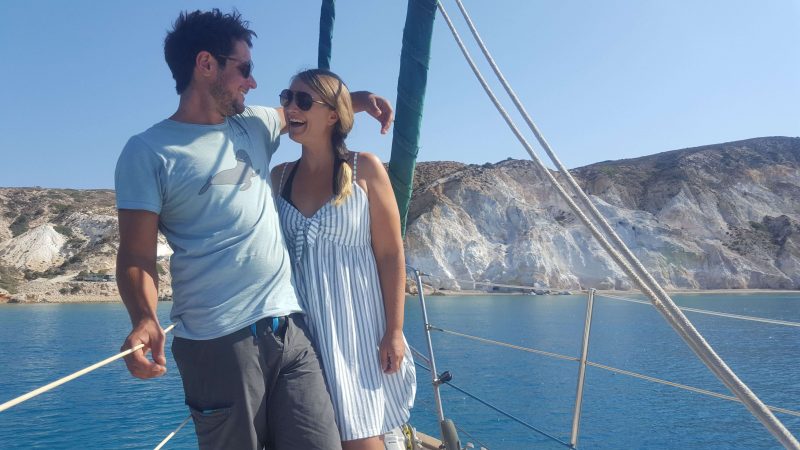
Sailboat living requires a huge amount of team work (unless you’re planning on living alone of course). You need get into a very different mindset when you live and work with the same person or people day in, day out, and when you depend on them (quite literally) to survive.
One of the biggest reasons that people quit at sailboat living is because they fall out with their partners, or call it a day before they do. Sailboat living is hard on relationships, but it can also make your relationship better and stronger if you’re prepared to work at it.
There are lots of things you can do to prepare for this change and I’ve put together a whole range of tips to help you with spending too much time with your partner .
Ultimately, one of the best things you can do is know that this isn’t going to be easy, no matter how strong your relationship is on land. Be prepared for this as a couple, and be prepared to work hard on your relationship when the tough patches come!
#8 Nature Is Incredible

I know, I know, we all know nature is incredible. But sailboat living brings you so much closer to it in so many different ways.
You see things you’d never get a chance to see on land. Every time you jump in the sea you find new sea creatures, either from snorkeling or finding them clinging on to your hull, or washed up on deck.
You see turtles, whales and rays. Birds come to find rest on your boat while you’re on long passages and dolphins swim beside you as you make waves for them to play in.

Then there’s the sunrises and sunsets, and the endless starlit skies. The thunderstorms that you’re suddenly a part of, when before you could hide inside brick walls. The constantly changing sea and sky, and the sun and wind. You become part of it, and you depend on it, and you’re terrified of it.
Sailboat living makes you feel like you’re part of the nature around you rather than just a lucky spectator. It’s certainly changed the way I see the ocean and the weather for the better and I have a new found respect and healthy fear of it’s power and awe.
#9 Prepare For Sleepless Nights

Before we set off cruising full time I had no idea how little sleep I would get. There are so many different things trying their hardest to ruin a good nights sleep on a sailboat.
Firstly, the weather. If it’s windy, you’ll be half awake all night just watching the anchor and wondering if this will be the night it pulls out and you drag into some rocks.
You’ll be waiting for the wind to shift slightly so that you’re no longer protected from the sea. And even if you’re super happy with your anchoring set up, the wind through the halyards makes a very disconcerting noise!
If the weather is calm that doesn’t mean the sea will be. You can never predict whether the anchorage you arrive in will be the rollyest place on the island, so you’ll spend a good few nights just rolling around all over the place trying your hardest to stay in your berth.

Then there’s the heat (or the cold, depending on where you sail). It can be unbearably hot inside a sailboat, so consider buying a decent hammock and sleep under the stars instead.
But if you decide to sleep outside you’re going to want a mosquito net, because those things are FIERCE. Never have I ever experienced so many sleepless nights due to a buzzing in my ears and painful bites all over my legs.
If you can find a comfortable set up with your hammock and mozzie net then sleeping outside on a sailboat is one of the most magical things ever. The stars are brighter than you could ever imagine, and there are shooting stars a plenty. The stillness of a calm night at anchor is one of the very best things about sailboat living.
If you’re sailing with a baby you can expect even less sleep – make sure you’re prepared for that!
#10 Sailboat Living Is More Difficult Than You Could Imagine (But Totally Worth It)

Difficult sounds bad, but that would be inaccurate when describing sailboat living. It’s the hardest thing I’ve ever done and the best. And part of what makes it the best is that it’s the hardest. Does that make sense?!
Sailboat living can feel like a constant battle at times. You have to trek for an hour to find the gas to light your oven to make a cup of tea in the morning. You then have to go back again because you forgot the tea bags. Things break and need fixing. You can’t sleep because of a storm. You can’t leave the boat for days because the winds up and you’re scared the anchor might pull out.
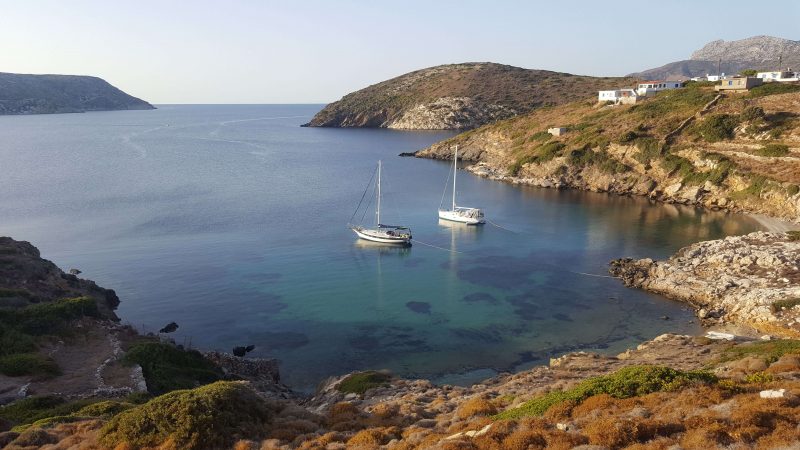
I think people run away to sea to find freedom, but like everything freedom can be defined in so many different ways.
Sailboat living takes away your freedom of easy access to food and water. It takes away your freedom to step out of your front door into relative safety. At times it even takes away your freedom to run and walk.
What it does give you is freedom from monotony. Freedom from daily routine. It gives you the freedom to travel where you want (if not when you want) and the freedom from material possessions.
It doesn’t matter what you wear on a boat, it doesn’t matter how flashy your boat is or how much you smell! At the end of the day, out on the sea, it’s just you surviving. And in a way, that’s the most free I’ve ever felt.

Similar Posts

What Is Capsize Ratio And How Is It Calculated?

Sailboat Keel Types: Pros And Cons 2024

Top Sailing Gear Essentials 2024: The Ultimate Guide
We bought a sailboat.

Canal Cruising In France 2024

Sailing Close To The Wind: How And Why You Should
15 comments.
I’ll be moving on a sailboat with my girlfriend this (still very new) year and I discovered your blog via Pinterest. We’re also writing weekly blog posts about our journey. Your writing is excellent, and I’d like to follow you on your mailing list. But it seems your form does not work. Fix it maybe? 🙂
Ah that’s strange! I can see people are still signing up, will have a look into that! Thanks for letting me know. Thanks so much for reading along. Where’s your boat? I’m so excited for you – those first few weeks aboard are the best!
I can’t seem to sign up for more. The web page has an error on my Android. Bummer.
Can you please add my email address to your email distribution list?
Thanks, Steve
So glad to come across you guys, finding out as much as we can before we take that leap. We are a couple coming to the end of a army career. The last 2 years will be in Kenya Nanyuki. Posted in June. Then we plan to get the dream sailing boat and travel. I am doing all my home work trying to find out as much as I can before we do this. Looking forward to reading about you both and tasking in everything any thing that we will I’m sure be incredible useful. Thank you Sandy
Sorry for the late reply, I’ve only just noticed your lovely comment. I hope you’re getting further along with your dream – would love to hear about it! If you need more help we’ve put together a huge guidebook detailing everything we’ve learnt, from the very beginning of the journey through to buying the boat and eventually living aboard and making it all work. https://twogetlost.com/guidebook
That’s really nice post. I appreciate your skills. Thanks for sharing.
Thanks for reading!
Thanks for the honest truth in this article. Doing all the research possible before following our dreams and in your footsteps 🙌💕⛵⚓
Thanks so much for your kind comment and really pleased we could help! Keep us updated on your journey, you won’t look back!
Wow! I am on a boat reading this while my partner is away for the first time in months, and it made me feel less insane and like there are tools to help us live our dream of minimalist sailboat life.. Thank you so much for your wise words and good tools..
I’m so pleased it helped and excited for you starting this journey! You won’t regret it, and we’d love to hear more when you find the perfect boat and move aboard! If you need more help we’ve put together a huge guidebook detailing everything we’ve learnt, from the very beginning of the journey through to buying the boat and eventually living aboard and making it all work. https://twogetlost.com/guidebook
- Pingback: How To Downsize Your Wardrobe For Boatlife | Two Get Lost
Any suggested reading on preparing your land life (home, insurance, anythin really) for departure. Sell the home or rwnt, thinks like that. Want to start preparjng a year ahead and struggling to make a plan..any blogs ir reading suggestions would be appreciated!
Hello, thanks for reaching out. First off – congratulations! You’re obviously set on your plan to move aboard and it will be amazing (and lots of other things too!!) We actually cover all this in part one of our guidebook. We go through everything we had to consider before moving aboard, things like whether to sell or not to sell, what to do with all your things, even little considerations like what to tell family and friends. We’ve included tick lists for planning the change in lifestyle. You can find it here. https://twogetlost.com/guidebook Part 2 is for after you’ve bought the boat – getting the boat ready for living aboard and all the other things that come along with living at sea. I hope it helps and please do let us know how you get on – perhaps we’ll see you out here soon!
It’s helpful to understand that when living in a sailboat, the weather controls every aspect of our lives. Not long ago, my wife and I decided to invest in a sailboat because we love the sea and nature. We’d like to buy one this year, and maybe in the future, we’ll need to read carefully your advice about living in a vessel.
Leave a Reply Cancel reply
Your email address will not be published. Required fields are marked *
Life on a Sailboat: Everything You Need to Know About Living on a Sailboat Full-Time
Living on a sailboat full-time is often romanticized as a life of endless sunsets, gentle waves, and freedom on the open sea. Many dream of casting off the lines and setting sail for a horizon of adventure and tranquility. However, the reality of life aboard a sailboat can be as challenging as it is rewarding, as frustrating as it is relaxing, and, more often than not, as mundane as it is exciting.
This blog post aims to peel back the curtain on the picturesque scenes to reveal what daily life is really like when you call a sailboat home. We will dive into the motivations, preparations, joys, and challenges of living on a sailboat full-time, providing a realistic glimpse into a lifestyle that is far from ordinary.
Our Live-Aboard Life
Our dream of living on a sailboat was a distant one for many years. But as we watched plans and dreams fall by the wayside in the wake of COVID, we made the decision to make our dream a reality. Once the borders opened up, we made a beeline for the Mediterranean and have since spent each summer living aboard our little 29-foot sailboat Whisper. Without any experience sailing or living on a sailboat, we have taught ourselves to sail and manage life on the boat along the way.
Before we took up sail life, we had been living “van life,” and we’ve come to realize there are lots of similarities but quite a few differences between the two . However, on the whole, learning to live van life first put us in good stead to take on life on a sailboat. Unlike most people, we up-sized when we moved onto a boat.
Despite the upgrade in living quarters, the learning curve and the adjustment to living on the sea were no less challenging. Nevertheless, the shift was not as scary as we thought it might be, and the reality of living on a sailboat full-time quickly became our new normal.
Initially, our plan was to buy a boat and spend one season aboard sailing the Mediterranean before selling the boat and settling down. Instead, it’s safe to say we have fallen in love with life on a sailboat. Now, as we enter our third season, we aren’t sure when we will be ready to furl the sails for good…
Get a Taste of Life on a SailBoat
We document some of the realities of living on a sailboat full-time on our YouTube Channel in our The Vanabond Sails series.
Deciding to Live on a Sailboat
The journey to becoming a full-time live aboard often starts with the desire for change.
Some people are transitioning from one stage of life to the next as careers wind up or children move out. Some yearn for adventure and excitement, while others seek a simpler way of life. Many are drawn to the promise of freedom, the allure of the sea, and the appeal of living more closely with nature. However, the decision to live on a sailboat full-time is not one to be taken lightly. It requires thoughtful consideration and planning.
For us, it was a long-held dream to sail and live aboard a sailboat. It was also a natural progression, having spent several years living and traveling by van . We were ready for a new challenge.
It began with a conversation, then a plan, and then trawling classifieds for second-hand boat sales. Before long, the decision was set in stone, and we were on our way to Croatia to buy a boat , learn to sail it, and move aboard.
Choosing the Right Sailboat
The type of sailboat you choose is critical and depends on your budget, sailing skills, and the kind of sailing you plan to do (coastal cruising, bluewater voyaging, etc.).
Will you prefer the size and stability of a catamaran, or will you prioritize the sailing experience of a monohull? Are you looking for something small that’s easily controlled and maneuvered by a limited (and potentially inexperienced) crew, or do you require the space of a larger vessel? Are you interested in the clean lines and comforts of modern boat designs, or do you prefer the style of older boats? There are a thousand decisions to be made when choosing a boat, and your own aspirations for boat life and, of course, your budget will be critical when it comes to making this decision.
Spend as much time researching boats that are available in your price range, ask questions of sailors you know or on sailing forums, and, if possible, spend time aboard different types of sailboats to get a clearer picture of what life is really like on board before making a purchase.
Check out our full article on buying boat .
Emotional and Practical Considerations for Sail Life
Living on a sailboat means embracing minimalism and being comfortable with the idea of having less space and possessions.
You’ll need to consider the impact of such a lifestyle on relationships with family and friends, as it can mean spending long periods away from loved ones.
The decision also involves considering how to manage work or income while living at sea , which might include remote work, seasonal jobs, or living off savings.
There are plenty of options for those planning on working remotely while sailing. With the rise of remote work , there has never been more opportunity to work and sail.
All of these considerations represent potential challenges to adjusting to life at sea, but they are certainly not insurmountable. You just need to be honest with yourself and decide if your love of the open water and the freedom of living aboard a sailboat will be greater than the inconveniences.
Preparations and Adjustments
Transitioning to life on a sailboat involves a series of preparations and adjustments, both practical and psychological, to ensure a smooth and sustainable living experience.
Training and Skills
If you are thinking about taking up sailing, you should, of course, invest time in learning to sail, navigate, and understand weather patterns. While this may seem like a daunting task, it’s not an insurmountable one. Time on the water is the most important thing, so it’s time to sign up for sailing courses, start planning trips with sailing friends, join a local sailing club, or seek out opportunities to crew for other sailors.
Learning basic boat maintenance and repair is essential to manage the myriad challenges that come with life at sea.
Safety courses, such as first aid, sea survival, and radio operation, are also crucial for handling emergencies.
These skills are important for safe and comfortable sailing and are often legally required. Make sure you are aware of the licensing and registration requirements for sailors in the region you are preparing to sail.
In our case, I had experience sailing small dinghies as a child and thus some understanding of the fundamentals, while Kelli had zero experience. My existing marine license issued in Australia was recognized in Croatia, where we bought our boat. I only needed to acquire a VHF radio license to become adequately certified for inshore sailing in the Mediterranean.
We paid some local sailors to come aboard and teach us both the fundamentals of our new boat (lots of docking and anchoring practice).
Downsizing and Adapting to Limited Space and Resources
As mentioned, moving onto a boat was actually upsizing for us. With a second cabin, a flushing toilet, and a large indoor table, our relatively small 29-foot monohull seemed luxurious compared to the vans we had been living in until this point.
However, for most, moving onto a sailboat often means significant downsizing, and space becomes a premium commodity. The process of downsizing for sail life involves prioritizing essential items and learning to live without the comforts of a traditional home.
Space isn’t the only limitation on a boat. Reliance on water tanks (if you don’t have a watermaker) and solar, wind, or generator electricity often means a downshift in access to creature comforts we take for granted in a house on the grid.
Creativity in organizing and making the most of limited space and resources becomes a daily practice, requiring innovative storage solutions and multi-functional furniture. Most modern sailboats are well-designed with endless space-saving measures and designs. Nevertheless, an adjustment will likely be necessary.
Financial Planning
Financial considerations are paramount, as the cost of living on a sailboat can vary widely depending on factors like marina fees, maintenance costs, and lifestyle choices.
Setting a realistic budget that includes regular maintenance, unexpected repairs, and living expenses is essential for sustaining life at sea.
Depending on your personal aspirations for boat life, this lifestyle can be as affordable or as expensive as you want to be. For us, as a couple in our thirties still in the building and saving part of our lives and careers, we are able to live on a boat in the Mediterranean affordably and comfortably for far less than we (estimate) we would spend living a more stationary lifestyle.
Check out our full article on the Costs of Living on Sail Boat Full-Time
Overall, adjusting to the confines and challenges of sailboat living demands not only physical preparation but also mental resilience and adaptability. The transition from land to sea is a profound shift, requiring a willingness to embrace simplicity, flexibility, and a sense of adventure.
Daily Life Aboard
While there is no typical day aboard, and experiences will differ wildly from person to person and day to day, we can describe what many of our days do look like.
As we work from the boat, our weeks are generally divided into work days, Monday to Friday morning and weekends. The truth is that the novelty does wear off, and many days, especially during the working week, become just as mundane as any other lifestyle. However it never stays mundane for long, one exhilarating sail, a dolphin sighting, a picture perfect anchorage or even surviving an impromptu weather event and the thrill of living on a sailboat quickly returns.
A typical workday for us living on a sailboat often starts with the sunrise (or a little bit before if we have a lot on). Ideally, we are well rested after a still night without rolling swell or, worse, strong wind, but that isn’t always assured at sea. Mornings involve checking the weather first and foremost, all plans revolve around the direction and strength of the wind and waves.
If the weather is calm, we usually try to work in the mornings when we are fresh and focused.
We travel slowly, often spending a few days in a quiet, well-protected anchorage, on a town quay, or in a marina before moving on a short distance along the coast. On sailing days, we often sail in the afternoon when the winds are a bit stronger in the Mediterranean. On days we are staying put, the afternoon might be spent exploring a new town, getting provisions, swimming, or finding a beach to lie on and read a book. In the evening, we will cook dinner onboard and get some more work done or watch some TV.
Weekends look different, and we will take advantage of not needing to be close to reliable network services, completing longer passages along the coast, or visiting islands.
Daily Differences in Sail Life
Living spaces on a sailboat are compact and multifunctional, necessitating an organized and tidy approach to prevent clutter and ensure safety. Cooking in a small galley kitchen presents its challenges, from securing pots and pans on a constantly moving boat to managing limited ingredients and storage.
Meals often need to be simple yet nutritious, requiring creativity and planning. Our approach is to cook simple, one-pot, vegetarian meals like dal or vegetable curry two or three times during the workweek and eat leftovers for lunch and dinner. On the weekend, we like to get more creative with our meals, seeking out local produce or fresh seafood and taking our time to prepare something special.
As mentioned, resource management is a critical aspect of daily sailboat life, especially when it comes to conserving water, fuel, and electricity. Efficient use of these resources is vital, whether it involves careful water usage, monitoring power consumption, or planning the next opportunity to resupply. For us, an electricity supply is mainly dependent on the sun when we are not under motor or plugged into shore power. Extended periods of cloud can alter our plans. Similarly, if we are not careful with water, more frequent visits to refill are required, which can be limiting.
Personal hygiene and privacy take on a new meaning in the confined space of a sailboat. Showers may be quick and infrequent. In our case, we generally rinse off after a swim to bathe and take proper showers during marina stops. Personal space is limited on a sailboat and managing personal relationships can have extra challenges.
Sleeping on the boat can take some getting used to, especially when on anchor. Even on a calm day, the constant rocking of the water can be disruptive at first, and novice sailors may find they get seasick, although these symptoms usually go away after a few days. When it’s windy, or there is some swell, the noise, movement, and the ever-present worry that the boat may pull off its anchor with the movement can make it very difficult to get a good night’s sleep.
Unforecast storms, gear failure, or some other emergency can occasionally create scary and challenging scenarios, especially if disaster strikes late at night. These situations are part of the adventure but can certainly be stressful.
Despite the challenges, daily life on a sailboat is interspersed with moments of profound beauty and peace. Whether watching dolphins play in the bow wave, enjoying a sunset over the ocean, or stargazing on a clear night, these experiences often make the hardships worthwhile, offering a sense of freedom and connection to nature that is hard to find elsewhere.
The Pros and Cons of Living on a Sailboat Full-Time
Pros: the joys of sailboat living.
Living on a sailboat brings a unique set of joys and rewards that can make the challenges seem insignificant.
+ One of the most significant benefits is the sense of freedom and adventure. Sailboat dwellers have the luxury of exploring new destinations, anchoring in secluded bays, and experiencing different cultures in a way that most people never will. The ability to call a variety of picturesque locations home, even if only temporarily, is a remarkable aspect of this lifestyle. Even compared to other forms of nomadic lifestyle, waking up in your own private bay or cove is hard to re-create.
+ The connection with nature is unparalleled in sailboat living. Being surrounded by the vastness of the ocean, witnessing marine life up close, and experiencing the rhythms of the sea create a deep sense of harmony and peace. The simplicity of life on a boat can lead to a greater appreciation for the small things, like the beauty of a sunset, the changing colors of the sea, or the silence of a night watch under the stars.
+ Community and camaraderie are also central to the sailboat lifestyle. The sailing community is known for its close-knit, supportive nature, with fellow sailors often ready to lend a hand, share advice, or offer companionship. This sense of community extends across harbors and anchorages around the world, creating a global network of friends and contacts.
+ The personal growth and self-reliance developed through sailboat living are profound. Navigating the challenges and unpredictability of the sea fosters resilience, problem-solving skills, and a strong sense of self-confidence. The lifestyle encourages continuous learning, from mastering sailing and navigational skills to understanding weather patterns and marine ecosystems.
The Cons: The Challenges and Hardships of Liveaboard Life
While the joys of living on a sailboat are plentiful, the lifestyle also comes with its fair share of challenges and hardships. These difficulties test the resilience and adaptability of those who choose this way of life.
– One of the most significant challenges is dealing with bad weather. Storms, high winds, and rough seas can be terrifying and dangerous, requiring skill, experience (which you can only get by …experiencing it), and a calm demeanor to navigate safely (perhaps the trickiest thing to achieve). The stress from poor weather can be mentally draining, disrupt work, and put a strain on relationships.
– The learning curve required to become a confident and comfortable sailor is not small and can take many seasons while mastering sailing can take a lifetime.
– The constant exposure to the elements also means that maintenance is a never-ending task, with saltwater and sun causing wear and tear that must be regularly addressed to keep the boat functional and safe. Especially on an older boat like ours, fixing and maintaining gear and rigging is an endless cycle. Most systems and hardware on the boat are essential, and when they fail, there is often no one around to help. Constantly sorting out jammed anchors, engine or electrical issues can quickly become tiresome and (if you are trying to work) quite disruptive. It can also be quite stressful when critical systems fail.
– Isolation is another aspect of sailboat living that can be challenging. Long periods at sea or anchored in remote locations can lead to feelings of loneliness and disconnection from land-based communities. The confined space of a sailboat can strain relationships, making it essential for the crew, be it a couple, a family, or friends, to communicate effectively and give each other personal space.
– The financial aspect of sailboat living can also be a hardship. Unexpected repairs and maintenance can quickly drain savings, and the cost of mooring, fuel, and supplies can add up. Sailors must be adept at budgeting and often need to be resourceful in finding ways to sustain their lifestyle, which might include picking up temporary jobs or remote work.
– The physical demands of managing a sailboat should not be underestimated. It requires strength, stamina, and a willingness to tackle everything from sail repairs to engine troubleshooting. The learning curve can be steep, and the responsibility of keeping the boat and its occupants safe is a constant pressure.
Despite these challenges, many sailboat dwellers find that the hardships are part of what makes the lifestyle rewarding. Overcoming difficulties and learning to live in harmony with the sea can provide a profound sense of achievement and satisfaction.
Final Thoughts About Life on a Sailboat
Living on a sailboat full-time is a journey that encompasses the full spectrum of human experience, blending moments of sheer joy and beauty with times of challenge and adversity. It’s a lifestyle that demands resilience, adaptability, and a willingness to embrace the unknown. While the romantic allure of sailing the high seas is undeniable, the realities of daily life on a sailboat are grounded in practical challenges and the necessity of continual learning and personal growth.
The decision to live on a sailboat should not be made lightly, as it involves significant changes in lifestyle, mindset, and social dynamics. However, for those who choose to embark on this adventure, it offers unparalleled opportunities for freedom, exploration, and connection with nature. The hardships encountered along the way are not just obstacles but also catalysts for growth, leading to a deeper understanding of oneself and the world.
If you have a question about living on a sailboat full-time, let us know in the comments below or shoot us an email anytime!
Fair winds and following seas!
In 2016, I had been dumped by my girlfriend, fired from my job, and the lease on my house was running out. Facing moving back in with my parents, 26, jobless and alone I decided to listen to the message the universe was trying to send me. I took off on my first solo backpacking trip, with a one-way ticket to Bangkok and a well-thumbed Lonely Planet guide. From there I wandered Southeast and Central Asia, traveled the Great Steppe, and made my way across Russia and throughout Europe.
In Estonia I met Kelli, who, despite having a less frantic travel style, shared my my restless spirit and passion for exploration. Together, we embarked on a new journey, van life. Over four years we travelled across three different continents with three different vans.
In 2022, as the world began to re-open post COVID we took an opportunity to realise a long held dream, to live aboard a sailboat. Since then we have spent two summers in the Mediterranean, sailing and living aboard our little sail boat Whisper. When we aren't sailing we continue to live our nomadic lifestyle, guided by a philosophy of slow travel and self directed adventure be it by van or backpacking.
We find excitement through our journey into the unknown, stillness and content in the beauty of the places we discover and we find ourselves in the vastness of our world.
Hopefully, we can help you find what you're looking for too. Get lost with us and find your own path.
Leave a Reply Cancel reply
Your email address will not be published. Required fields are marked *
Glory of the Snow
May 16, 2022
Living On A Sailboat Full Time: What It’s Really Like
Have you ever wondered what living on a sailboat full-time was really like? Check out an insider’s guide to the sailboat lifestyle!
“Being on a boat that’s moving through the water, it’s so clear. Everything falls into place in terms of what’s important and what’s not.”
James Taylor
What Is Living On A Sailboat Really Like
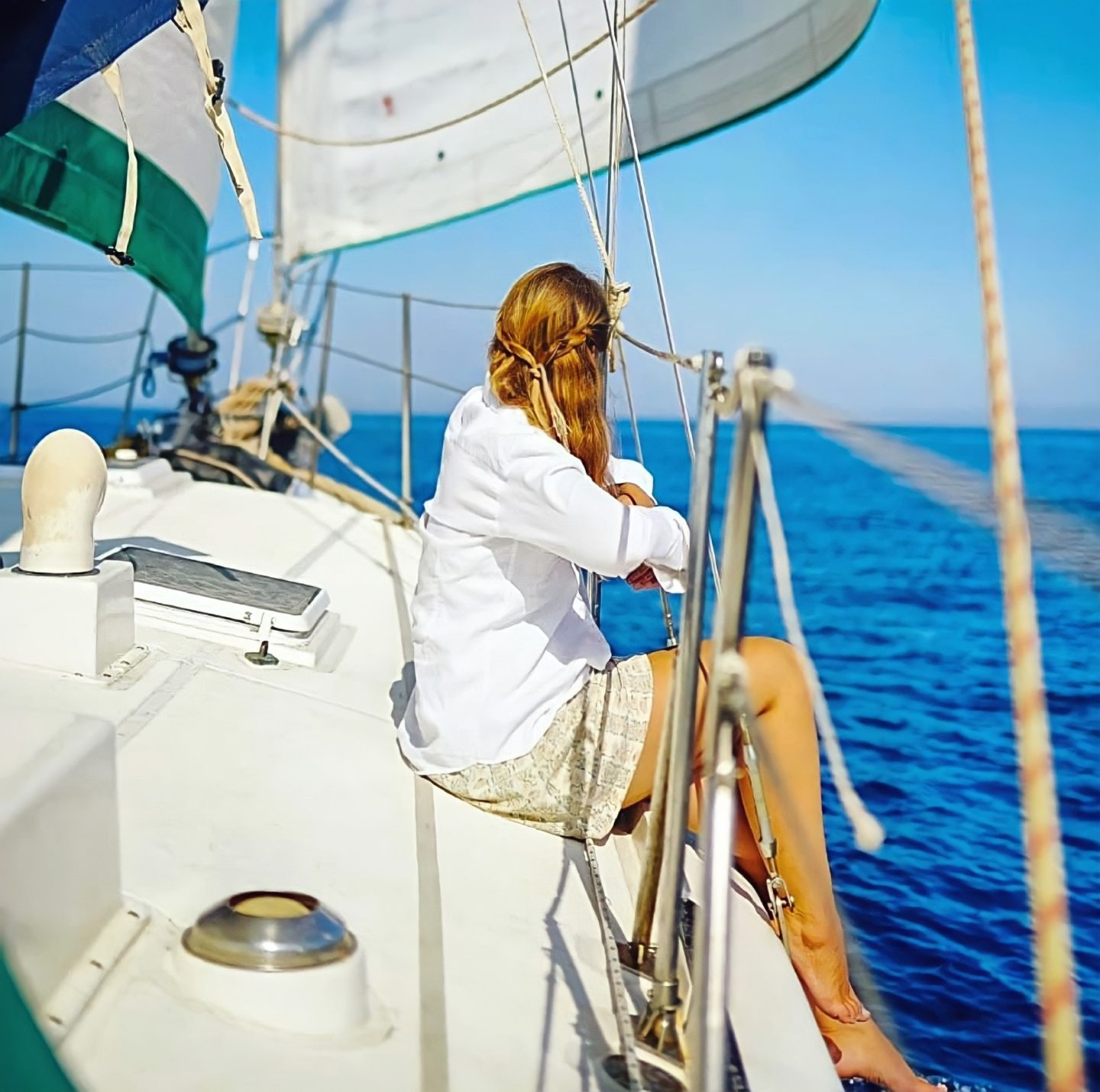
Sailing is the ultimate adventure – the wind in your hair, the power in your sails, the salt spray on your lips. You can spend one night moored up in an ancient city and the next on an uninhabited island, spearfishing your next meal. You can dance with the dolphins or nap in a hammock in the shade of a sail.
But what is it really like to live on a sailboat and spend every day in a tiny floating home surrounded by a landscape so changeable? What are the key aspects that make this lifestyle so unique?
After three years of living on board our 38ft sailboat, we’ve discovered the highs and lows of sailing life and what it’s really like to live on a sailboat.
The Ultimate Freedom
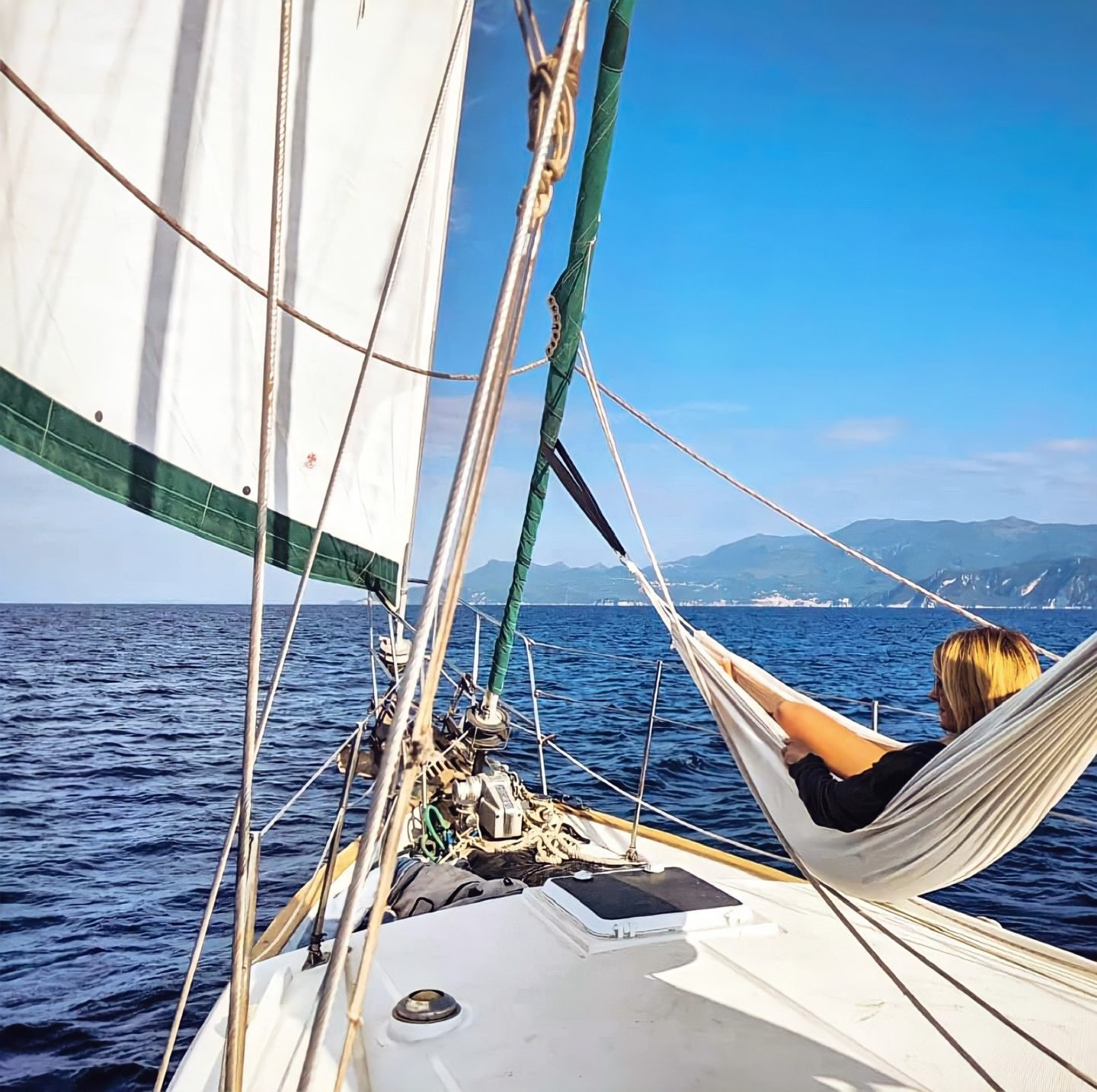
Many people would sum up freedom as the ability to sail away into the sunset. When you live on a sailboat, you have a huge amount of freedom, and it’s an incredible perk.
If you get bored of the view, you can simply move anchorages. If you’re fed up with the winter, you can sail somewhere warmer. Don’t like your neighbors? Just sail away from them!
Having a home that moves is the ultimate freedom, and it’s an incredible feeling knowing you go where the wind takes you.
On the flip side, you’re tied to the boat. The day you move on board is when you inherit a huge responsibility, which can sometimes feel like the opposite of freedom!
If it’s windy, then you can forget about going to the shore as you need to be on board, making sure the anchor doesn’t drag. If something breaks (something always breaks), then you’ll need to get it fixed before you can move on. If there’s a bad weather forecast, you can be pinned to one spot for days, or if there’s no wind, the same can be true.
A Tiny Home

Picture a room in your house. Now imagine this room has to accommodate your belongings, kitchen, bathroom, and office. Imagine spending 24/7 in this space with your significant other or your family. And imagine a moat surrounds this room, and one of the biggest things people notice when they visit is just how small the space is. Compared to a house on the land, a sailboat home can feel a little pokey!
Beds tend to be small and are often strange shapes. Having a double bed that you can climb out of on both sides is a true luxury that only the most expensive sailboats can accommodate.
The headroom on sailboats isn’t great either. It’s common to crouch down to reach certain parts of the boat, and by the end of your first week on board, you’ll wish you’d bought a helmet for the number of times you walk into things.
Another big thing to get used to when living in a sailboat instead of a house is the amount of storage available. Downsizing is key, and after a few weeks on board, you’ll find yourself prioritizing tools and food provisions over clothes and other luxuries.
Safety First
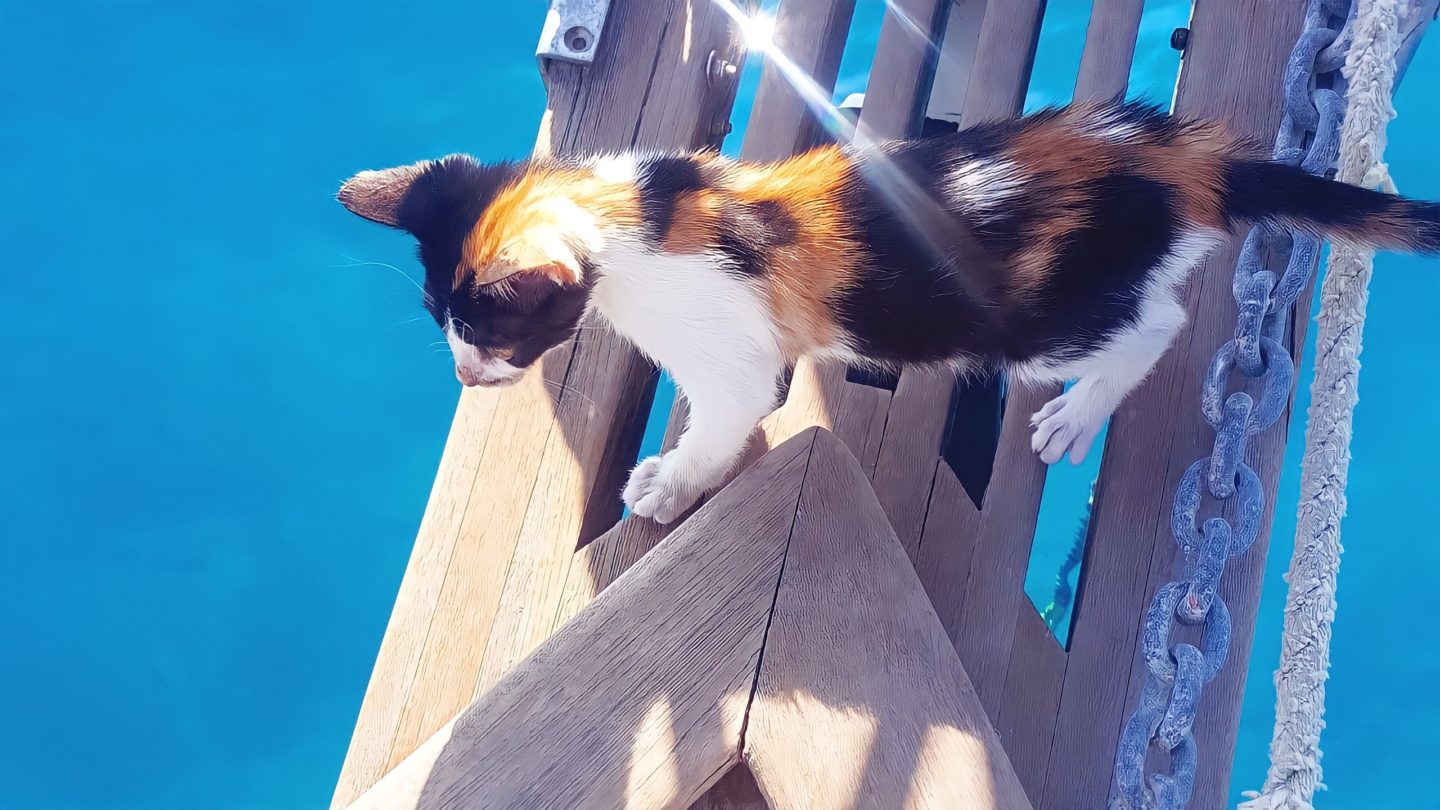
When you live on a sailboat, the biggest consideration is always safety. It’s on the back of your mind no matter what you’re doing. All sorts of things can go wrong when you live in such a changing environment, from storms to fires.
Sailboats are made to be safe, not homely! It’s important to stow things away when you’re finished with them. If you leave out that mug after finishing your cup of tea and a swell comes into the anchorage, you could end up with shattered ceramic all over your moving floor.
Before every sail, you must perform a safety check of your engine and equipment. Carrying spares on board is a must, and chances are you’ll be performing surgery on your engine in the middle of a rocky sea more than once!
If you have friends to stay it isn’t as simple as directing them to the toilet – you’ll need to show them how to pump out the toilet, for starters! But you’ll also need to give them a safety brief, showing them all the potential things that could go wrong and what you’ve got to prevent it!
The Weather Rules

One of the best and worst things about living on a sailboat is that you’re completely reliant on the weather.
It’s incredible to feel so in tune with your environment after years of sitting in an office and not knowing if it’s sunny or rainy outside. You live outside, waking up with the sunrise and watching every sunset.
You don’t realize how reliant you’ll be on the forecast until you live on board. If the wind is blowing a certain way, you might have to move anchorages to find shelter, or if there’s no wind, your plans to move on might be delayed. You can’t get off the boat if the wind is too high, so you might be stuck on board for days.
A Simple Way Of Life

The sailing lifestyle is about slowing down and simplifying life, which can have an incredible impact on mental health. The fast-paced land life melts away once you’re sailing offshore with the wind powering you and nothing but dolphins to distract you from the sound of the waves.
Everything takes longer, and you learn to appreciate that. It feels more like surviving, but somehow that’s a good thing!
Water isn’t freely available. You learn to make it last a long time by washing in the sea or the rain and washing up in salt water. To get food, you often have to trek an hour to a local supermarket, where there are limited food options, and then lug it all back in your rucksack, into the dinghy, and back on board.
You learn tips and tricks to make your sailboat provisions last longer and get back to cooking from scratch every night without takeaways and ready meals at hand.
Power is limited to what you can make from the sun or wind, which often means no freezer and limited time on devices.
Suddenly, long, hot showers feel like a luxury. Having easy access to a washing machine is something you crave! And as bad as that might sound if you’re reading this from the comfort of your own home, it does make you truly appreciate the little things you used to take for granted.
Immersed In Nature

One of the first days we had onboard looked a little like this…
We got up with the sunrise and drank our morning coffees in the cockpit, watching the kingfishers and gulls diving for jumping fish. Then we headed out for a sail and squealed in delight as a huge pod of dolphins danced in our bow waves. We arrived at a new anchorage and dived into Greece’s crystal clear waters to spearfish some dinner, which we later cooked on a campfire under the Milky Way. To end this perfect day, we took a midnight dip surrounded by bioluminescent algae.
If you had told me this day wasn’t going to be a one-off, I wouldn’t have believed you. But living on a sailboat brings opportunities like this all the time, and you never get bored of it.
Of course, the downside to this is the terrifying storms when you fear the boat may get struck by lightning or the days when it constantly rains and the hatches leak, and you can’t even turn the lights on.
The summer brings a constant battle against mosquitoes and flies, and the winter greets you with freezing cold days under blankets. Somehow, though, as soon as you spot those dolphins, all the bad moments fade away.
A Cheaper Way Of Life
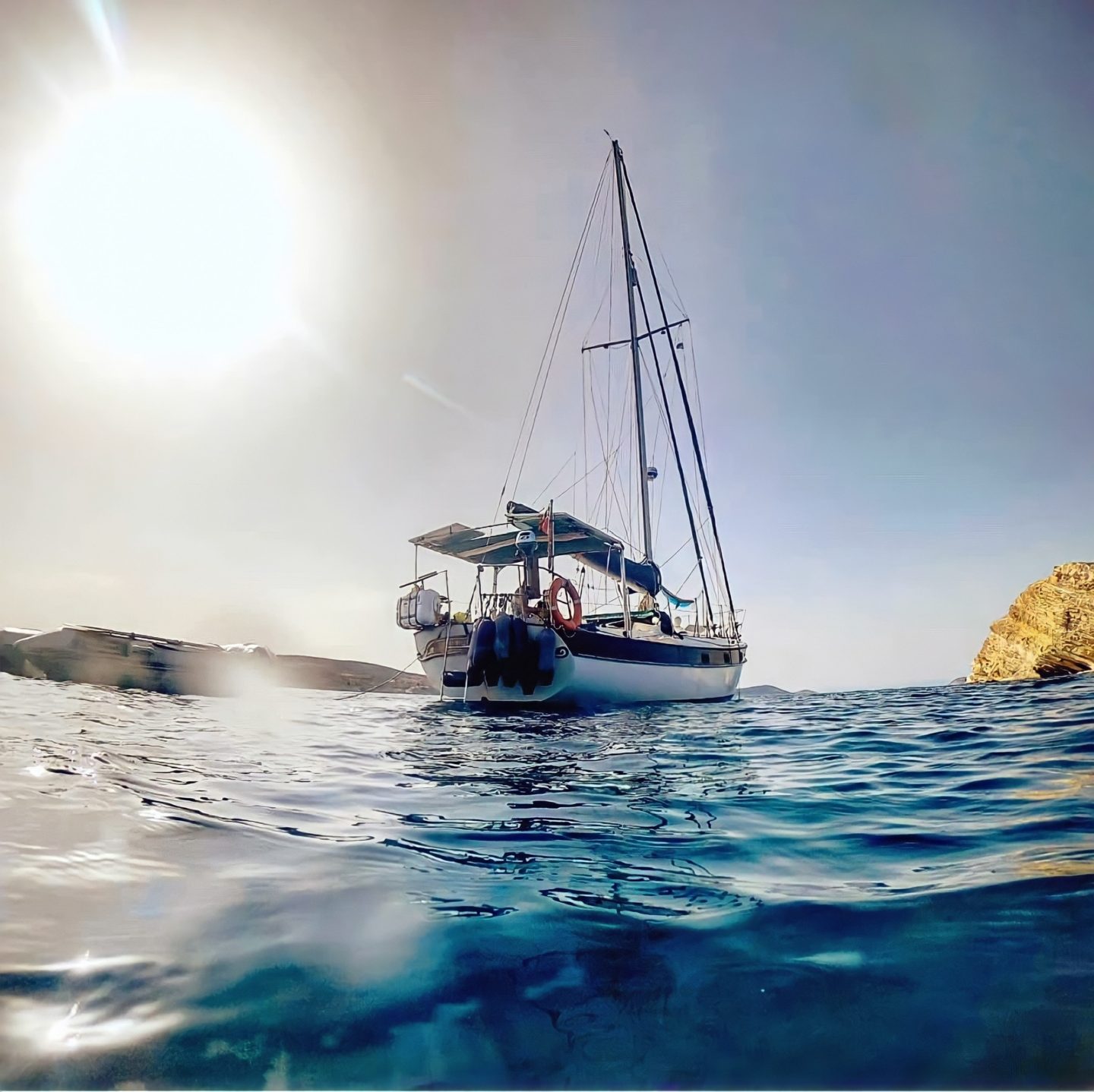
You may be wondering whether sailboat living is cheap.
Sailboat life can be a lot cheaper than living on land. People assume that owning a yacht makes you well off when you can pick up older, smaller sailboats for next to nothing if you’re prepared to do a lot of boat maintenance to get it up to scratch.
We spend most of the year at anchor, and marina fees in Europe for a 38ft monohull tend to be around £400 a month over winter. So we can get away with our ‘rent’ costing an average of less than £200 a month over the course of the year.
If you’re determined, you can sail to new destinations, which costs nothing. You can row to shore in your dinghy to save on petrol costs. You make your own power from the sun and wind.
The expensive side to owning a boat is the sailing gear you need to invest in to make life on the water more comfortable. There are many ways to keep these costs down if you’re determined, like buying second-hand and making do without modern luxuries.
Testing Relationships

If you want to put your relationship to the test, buy a sailboat! You’ll be sharing a small space with your significant other, often unable to escape for days. Having some space will consist of moving 10ft away from them and putting on a pair of headphones!
You will be entirely reliant on each other, sometimes for your lives. That might sound overdramatic, but when you live on a sailboat, that can, at times, be the truth. When problems occur at sea, you will only have each other to depend on, and you’ll need to work as a great team to keep yourselves, your boat, and your relationship safe!
The wonderful thing about experiencing this life with the ones you love is that it can bring you so much closer. You learn to work together quickly. You learn to communicate well and resolve arguments swiftly, and the memories you make together will last a lifetime.
So What Is Living On A Sailboat Really Like?
It is, for us, a life enhanced. It’s the extremes. The pure joy you feel when you complete a difficult passage and drop the anchor in a calm bay, the connection to your food when you catch a fish that you know will sustain you for several days, the exhaustion you feel after a rolly, windy night.
Living on a sailboat is thrilling and boring; it’s peaceful and challenging; it’s freedom and responsibility.
If you’ve finished reading this and you still aren’t sure what it’s really like to live on a sailboat, then I guess you’ll have to find out for yourself!
About The Author Of “Living On A Sailboat: What It’s Really Like”

Emily Nancolas is an adventure-seeking travel fanatic who ran away to sea with her boyfriend three years ago. Since then, they have sailed Sicily and Greece, been locked down in a boatyard, nearly sank the boat (twice), and adopted a Greek kitten called Tiny Cat. Emily loves to write about her sailing lifestyle for new sailors and has released a complete guide on ‘ How to Run Away to Sea ’, which has helped numerous others start a life of adventure on the ocean.
I hope you have enjoyed this post and now you know exactly what to expect from living at sea on a sailboat.
Just before you go, you may also want to check out this article about van life: 7 THINGS I WISH I’D KNOWN BEFORE LIVING IN AN RV .
Thanks for stopping by!
If you enjoyed this post featuring the pros and cons of the boat lifestyle, please pin it on Pinterest to help it reach more readers!
***PIN IT***
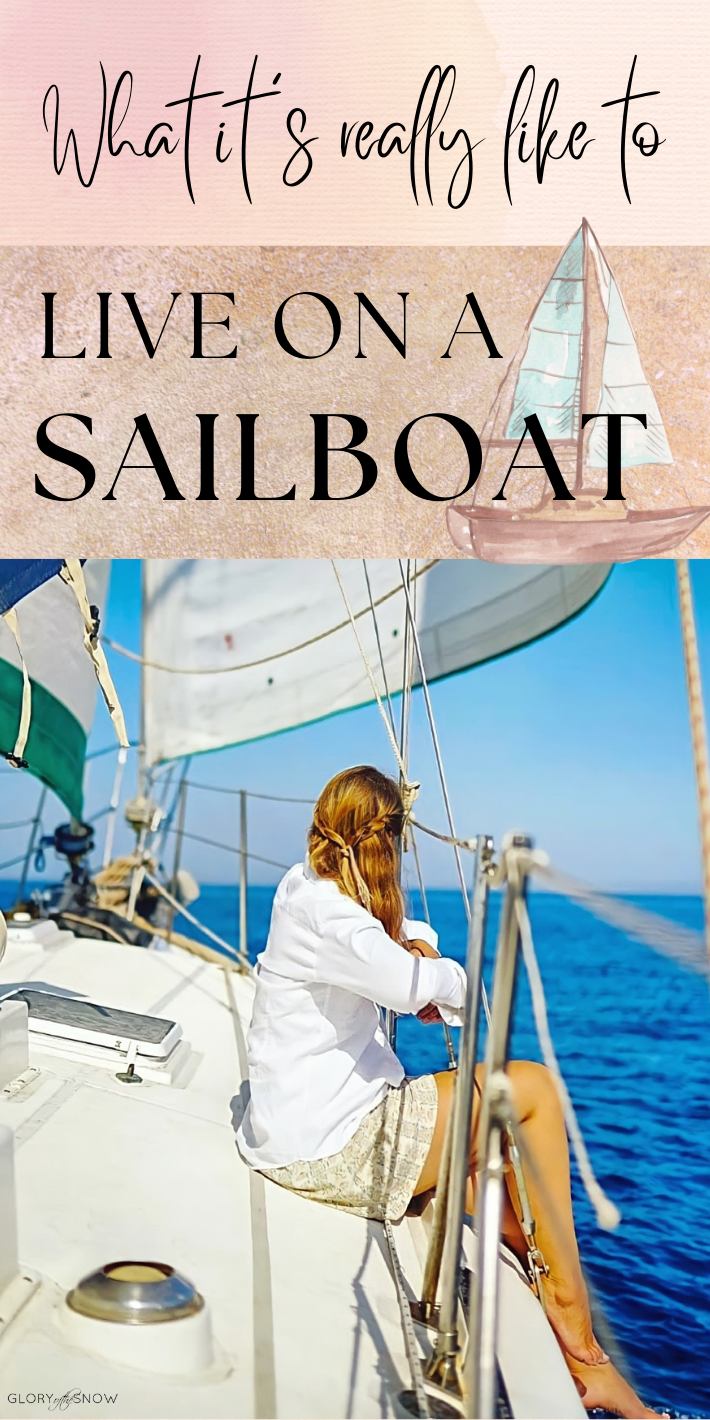
Copyright © 2024 Glory of the Snow · Theme by 17th Avenue

My Cruiser Life Magazine
17 Best Sailboats to Live On + What You Should Know First
Many dream of living aboard a sailboat, but finding the right one can be daunting. There are many different types, and countless manufacturers have come and gone over the years.
Here’s a list of 17 options – a sailboat for every sailor on every kind of budget.
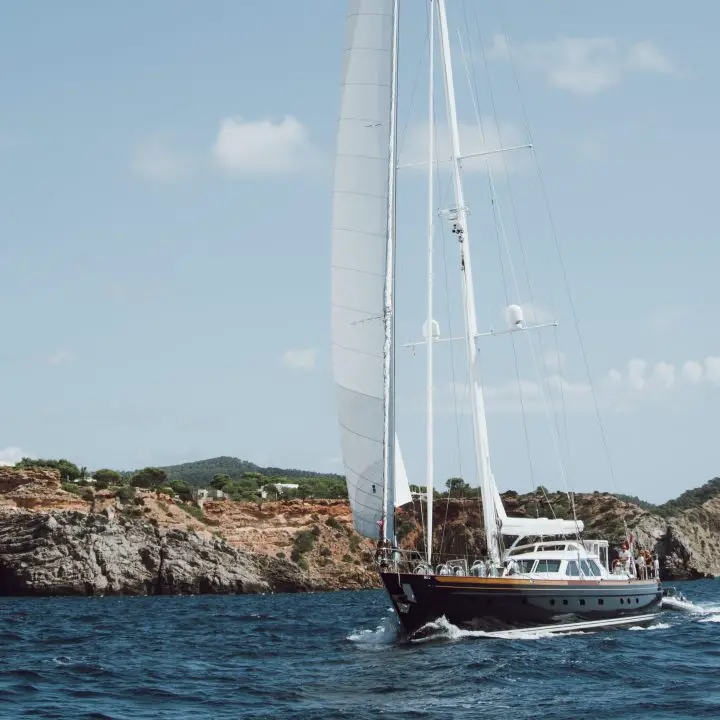
Table of Contents
17 best sailboats to live on, pros of living aboard a sailboat, cons of boat life.
- Find Your Type of Boat
Set Your Boat Budget
What size boat to pick, best liveaboard sailboats under 35 feet (< 35 feet), best liveaboard sailboats under 40 feet (35–40 feet), best liveaboard sailboats under 45 feet (40–45 feet), best liveaboard sailboats under 50 feet (45–50 feet), best liveaboard sailboats under 60 feet (50–60 feet), want to live on a sailboat, best sailboats to live on faqs.
- Catalina 34/35
- Panda/Baba 35, Tashiba 36a
- Gemini 105MC
- Islander Freeport 36
- Passport 40
- Jeanneau Sun Odyssey 42DS
- Leopard 42/43
- Beneteau Oceanis 473
- Hallberg Rassy 46/48
- Leopard 46/Moorings
- Amel Super Maramu 2000
- Privilege 585
What to Know First
So, boat shopping is a challenge, to say the least. Understanding where to start and what to look for comes down to understanding what you want to do with your boat.
Here’s a look at some pros and cons of living aboard to get you started.
- Seaside living at a fraction of the cost of a waterfront home
- Ability to travel anywhere by water
- Ability to move anytime—not tied to one location/town
- Different liveaboard lifestyle options to choose from: at a dock, mooring, anchoring, cruising (traveling)—tired of one, mix it up for a different experience
- Small living space lacks storage and privacy
- Limited resources: you must meter your fuel, water, and electricity use when not at a dock
- More exposed to the elements and more affected by weather events
- Seating and furnishings are less comfortable than in a house
- Constant maintenance to keep the boat seaworthy and clean
How to Find the Best Boat to Live on Year Round
At first, you might think boat shopping is like looking for a new car. But when shopping for a car, you have a small pool of manufacturers and models to choose from. In the end, you might have five choices and already have an opinion about each maker’s quality and reputation.
Boats are different. We’re usually shopping for boats that are a decade or more old. The manufacturers may have gone out of business years ago. When you total up all the possible makes and models of each type of boat, you might have dozens of choices with brands you’ve never heard of. Yikes!
Find Your Type of Boat
There are dozens of types of boats you could live on, depending on where you want to live and where you want to take it. Most people shopping for a sailboat will choose between coastal cruisers, bluewater boats, and sailing catamarans.
Here are some of the pros and cons of these sailboat types.
The Coastal Cruiser
- Inexpensive compared to bluewater and catamarans
- Perfect for dock living or near-shore hops
- With modifications and the right outfitting, many have island-hopped the Caribbean
- Many to choose from, and often they are lightly used
- Designs are often race-inspired and faster than typical heavy bluewater boats
- Newer, bigger boat for your money
- Often production boats have low-quality, lightweight builds
Related: Best Trailerable Sailboats
The Bluewater Sailboat
- The best bluewater cruising sailboats are capable of going anywhere
- Built to last and take anything
- Give the most comfortable ride in rough conditions
- Newer examples are expensive
- Good ones sell quickly
- Older vessels may be tired and in need of an extensive refit
- Often lack the living space that coastal cruisers have—narrower beams and transoms

The Catamaran
- Cruising cats have the maximum living space, especially cockpit dining and upper salon
- Light-filled with plenty of airflow, perfect for the tropics and living at anchor
- Larger models (40+ feet) are bluewater boats capable of going nearly anywhere
- A shallower draft than most monohulls allows for more cruising and anchoring choices
- More expensive to purchase, keep, and maintain than similar-sized monohulls
- The most in-demand vessels, prices are high and good ones sell fast
- Sometimes hard or expensive to find dock space and boatyards that can haul it out for maintenance
Still unsure which side of the monohull vs. catamaran debate you’re on? Try to get aboard some boats and experience the living space first-hand.

Everyone has a budget when going boat shopping, even if you’re Jeff Bezos or Elon Musk. Establishing how much you can spend on your boat is the biggest factor that will affect your decision, and it’s the backbone for all other decisions.
You must understand just how much boat costs increase as the size of boat increases. Boats are already expensive, and the average cost of owning and buying a liveaboard sailboat varies dramatically. But when the boat gets bigger, it needs bigger hardware, lines, rigging, sails, motors…everything. And bigger means more expensive, so these costs add up fast.
And then there are your storage and boat maintenance costs, all of which are charged per foot. The marina might charge you $15 per foot/per month for a dock slip, and the boatyard will similarly charge you per foot to haul and store the boat. Divers charge per foot for bottom cleaning, as do detailers for annual compounding and waxing of the hull.
When it comes to budgeting, there are two rules of thumb.
- Always pick the smallest boat you can comfortably live on.
- If you have an amount budgeted for your boat purchase, spend half on the boat and save the other half for outfitting and maintenance.
As you’ll see below, boats can be grouped by price and size. When you go up in size, you go up in price—often by a lot.
The size of the boat is a factor of your budget, but also of how big a boat you can handle. Most people believe this means driving it and maneuvering it, which is true to some extent. But a good training captain can teach you what you need to know to drive any size boat in just a few sessions.
No, the size of the boat you can manage refers more to how much maintenance you want to do. The bigger the boat, the more complex and plentiful its systems. There’s more to break on a bigger boat, and more things broken means more time fixing things.
Catamarans compound this by doubling a lot of the systems. Two engines, two saildrives, two hulls to wax, two hulls to bottom paint—you get the idea.
Another factor you should consider early on is getting insurance. Yacht insurance has gotten harder and harder to get in recent years. If you’ve never owned a boat and have no experience, you might be forced to get something small (think an under 30-foot daysailor) to get some experience on before you move up. It’s also difficult because many underwriters won’t write policies for liveaboards.
As a general rule of thumb, most people will find boats under 35 feet too small to live on full-time. Most of these vessels don’t even have standing headroom. There is often only a “wet head,” one where you take showers while sitting on the toilet.
Boats 35 to 40 feet are good for solo travelers or couples who don’t mind living in small quarters. The beds will be small and accessed only from one side, as in a v-berth or a Pullman-style berth. If there is one, the second bunk is likely only for the occasional guest.
You’ll get better accommodations when you move up to 40 to 45 footers. The second bunk may be in its own stateroom. The main suite will have an island-style berth that can be accessed from both sides—a huge upgrade for most couples. The head will likely have a separate, enclosed shower. This size sailing yacht makes a good liveaboard sailboat for most boaters.
Boats bigger than 45 feet are best for bigger families. If you often travel with kids or guests, these are the boats for you. They’re extremely spacious and make boat living easy, but the extra maintenance and cost may not be worth it.
The List — Best Sailboats to Live Aboard
All lists, whether found in internet blogs or international sailing magazines, have issues. There’s no one list to rule them all because there are simply too many different boats out there. And everyone uses their boat differently, so the “best” for you might be a terrible choice for me. Different boats for different folks, so to say.
So, what’s the deal with this list? It’s made from personal experience of having seen a lot of boats out cruising. And it’s a list that tries to put aside the fantasies—Oysters and Gunboats are pretty in magazines, but like Ferraris, not many of us will ever own one. So let’s look at some practical boats that fill each size category.
For every boat on this list, a dozen or more could’ve been included. Use these models to research brands and see which sizes suit your needs.
Boats under 35 feet tend to be best suited for solo travelers or couples comfortable living in small spaces. As always, coastal cruisers in this class have much more space than bluewater boats do. Catamarans in this class are also coastal cruisers—you need more length and volume to get real bluewater performance out of a cat. No matter which type of boat you’re looking at here, storage space on this size of liveaboard boat will be limited.
View this post on Instagram A post shared by Wilderness Of Waves (@wildernessofwaves)
Coastal Cruiser Under 35 — Catalina 34/35
If you want to move aboard, you’re on a budget, and you want the most space you can get, it’s really hard to beat an older Catalina. Starting with the Catalina 30, these beamy boats have a surprising interior volume. They make great first liveaboards.
Bluewater Sailor Under 35 — Panda/Baba 35, Tashiba 36
The famous yacht designer Bob Perry drew these Taiwanese-built boats, all tracing their lineage to the older Tayana 37 . They’re updated slightly and built by different yards, but all full keels with cutaways and built for bluewater cruising. They all have gorgeous teak joinery and are comfortable and forgiving at sea.
Catamaran Under 35 — Gemini 105MC
The Gemini 105M and 105MC were arguably the most popular cat models ever. They’re American-built, with a single diesel engine and a narrow beam that allows them to be parked in a standard boat slip. In the US, this means many more marina choices if that’s how you roll. The boat has centerboards and kick-up rudders, so the board-up draft is a scant 18 inches—gunkholing perfection.
While some Geminis have crossed oceans, they aren’t made for it. They have average (sometimes below-average) build quality and fiberglass work. However, they’re perfect coastal cruisers and capable of heading into The Bahamas.
The Gemini should be on your shortlist if you’re looking for a cheap catamaran .
Runner Up: PDQ 32
Are you looking for a small cat with better build quality? They didn’t make many of them, but the PDQ 32 is what you seek. It’s an attractive small catamaran with a wider beam. It came with twin outboards in wells, but the LRC (long-range cruiser) option had inboard diesels.

Forty feet is the sweet spot for most cruising couples—big enough to be comfortable and carry enough provisions but small enough that handling and maintenance are manageable. This class of boat has a lot of excellent choices in both coastal cruiser and bluewater boats, making it a good size range to find the perfect affordable liveaboard sailboat.
The catamaran group from 35 to 40 feet has a few very popular choices, but they are right on the edge of being too small for most cruisers. Counterintuitively, these cats are perfect for couples who don’t mind downsizing and traveling lightly. These shorter cats are prone to hobby horsing and don’t provide as comfortable a ride in bluewater as slightly longer cats do.
Coastal Cruiser Under 40 — Islander Freeport 36
The Islander brand is no longer around, but these California-built production boats from the 1970s and 80s were well-built and well-liked. The I32 and I36 were very popular cruising boats designed by Bob Perry. The Freeport 36 is a before-its-time European deck salon with enormous windows. The swing-down swim platform is another bonus for a boat from this era, as are the Pullman-style berth and forepeak-located head (some layouts). If you can find one in good condition, these boats make excellent liveaboards.
Bluewater Sailor Under 40 — Passport 40
Yet another boat from the desk of Bob Perry, the Passport 40, is a sharp-looking aft-cockpit bluewater cruiser from one of the best yards in Taiwan. They feature a long fin keel and skeg-mounted rudder. Everything about this sloop is just right for long-term cruising.
Catamaran Under 40 — Prout 38
The Prout 38 traces its heritage back to the earlier Prout Snowgoose. The boat is still being made, now under the Broadblue brand. It’s a sturdy British-built cat made for serious offshoring. While it lacks some of the open feeling that newer charter boats have, it more than makes up for it with its robust and high-quality build.
Runner Up: Leopard 40 (2005-2009)
This early L40 (don’t get confused with the newer ones built around 2020) was designed by famous multihull designers Morelli and Melvin. It’s got more of the things you might expect from your typical charter cat: a sliding salon door, galley-up layout, and a huge walk-through cockpit.
While this seems a small step up from the size of boats above, prices increase rapidly above the 40-foot mark. At this point, the boat’s gear needs to be bigger and heavier, from all the lines and rigging to each block and winch. Engines are now larger four-cylinder diesels, and there’s much more hull area to clean and paint.
A 45-foot coastal cruiser has enough space to keep a small family happy for short trips or a couple happy for any length of time. These boats usually have island berths in a spacious master bedroom, so no more crawling over each other just to go to the bathroom! Bluewater boats in this class are a little smaller inside, making them just right for most couples doing a long-term cruise.
As far as catamarans go, the 40 to 45-foot range is the perfect sweet spot for most cruising couples. A spacious interior plus excellent seakeeping abilities make these top picks. There are tons of boat choices out there, and most of the best cruising catamarans come from this size group.
View this post on Instagram A post shared by Tara Smith (@minofmine)
Coastal Cruiser Under 45 — Jeanneau Sun Odyssey 42DS
Jeanneau is part of Groupe Beneteau , but their boats often have a more refined finish than Beneteaus. The DS stands for “deck salon.” They feature larger windows that let in more light and have better visibility than a standard cruiser. This is especially welcome if you’re attracted to the living space in a catamaran but need something smaller and more affordable.
The 42DS also has an enormous island berth, plus a huge twin-helm cockpit with lots of space for entertaining.
Bluewater Sailor Under 45 — Hylas 44
The Hylass 44 is regularly picked as one of the best offshore cruising boats. It’s a center cockpit boat designed by German Frers. It has a wonderful layout with tons of living space and a large, usable galley. The aft cabin has a large island berth with an en suite head.
Catamaran Under 45 — Leopard 42/43 (2001-2006)
These early Leopard charter cats are highly sought after on the used market. Like all charter cats, the best finds are the “owners versions” with one hull dedicated to the master stateroom with en suite head and shower. The Leopard 42, which came out in 2002, had a soft canvas cover over the cockpit and was updated to the Leopard 43 with a hardtop.
Above 45 feet is another big price jump. For beginners, these big boats will require some training and experience before you head out on your own.
Related: Best Boat for Beginners
View this post on Instagram A post shared by Leopard 46 "Shanties" (@leopard46shanties)
Coastal Cruiser Under 50 — Beneteau Oceanis 473
This big Beneteau came with either 2, 3, or 4 staterooms. Finding the right layout is as important as finding the right boat. The two-stateroom version has enormous berths and lots of storage, perfect for couples with occasional guests or families of three. Most have the standard keel with less than a six-foot draft, making this fin keel/spade rudder boat a rare find. They were built from 2000 to 2005.
Bluewater Sailor Under 50 — Hallberg Rassy 46/48
Hallberg Rassys are well-regarded boats built in Sweden, mostly designed by German Frers. These are high-end boats of the best quality, so don’t expect to find one available cheaply. They’re gorgeous, however, and make wonderful world cruisers.
Catamaran Under 50 — Leopard 46/Moorings 4600 (2006)
If you want a big catamaran, it’s hard to go wrong with the 2006 Leopard 46. Where modern Lagoon and Leopards have tall profiles with tons of windage, this is one of the newest, largest boats that still have single-level living. It has distinctive hull chines that increase living space without increasing wetted surface and plenty of sail area for good performance. In true Leopard fashion, all lines are led to the helm for easy short-handed cruising despite the boat’s large size.
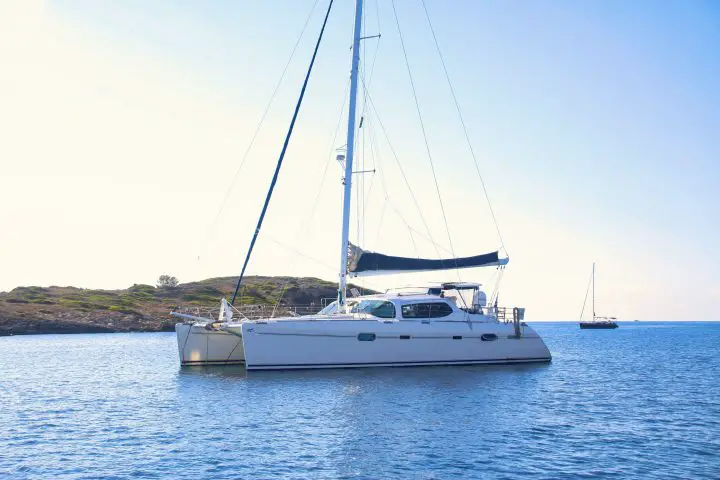
Boats in this class are borderline yachts based on their sheer size. If you were to charter these boats, they’d usually come with a crew. That size means they’re more expensive and more of a handful to manage daily.
Coastal Cruiser Under 60 — Irwin 54
The Irwin brand is long gone, but many examples are available on the used market. They were known especially for their large center cockpit ketches, like this 54-footer. This is a spacious, big water boat that certainly meets the qualifications of most bluewater boats. They can go anywhere, but they may need maintenance and refit given their ages.
Don’t get to lured by the low prices of these boats. You’ll have to lay out some serious cash to get one ready to cruise long-range. But if you aren’t opposed to some hard work and projecting, the Irwin can get you a lot of boat for not much money.
Bluewater Sailor Under 60 — Amel Super Maramu 2000 (53′)
Made famous by the Delos YouTube channel, the Amel is a French-built brand of high-quality bluewater boats. Today, this brand’s new models look like many others—wide sterned, flat-bottomed sloops. But the Maramus that made them famous were unique—ketch rigged and ruggedly built, designed to take a cruising couple anywhere. Electric winches were standard on everything to keep such a large boat easy to operate.
Catamaran Under 60 — Privilege 585
Privilege is the French-made catamaran that you don’t hear enough about. Unlike Lagoon and Fountaine Pajot, these are beefy cruising boats ready to take you anywhere. Their construction and fit-and-finish are first-rate, as is the joinery down below.
Living on a sailboat is an adventure—it’s not for everyone. Finding the right boat is an important part of doing it successfully, but it’s not the only step in preparing for the lifestyle.
You should also consider checking my post on liveaboard catamaran options, to make sure you research thoroughly enough!
What makes a great liveaboard sailboat?
Everyone’s priorities for a liveaboard sailboat are different—a bluewater cruiser looking to sail around the world might pick a very different boat from someone who lives full-time dock life. In general terms, you need to find a boat that is safely capable of taking you where you want to go and has enough living space to be comfortable while doing it.
Sailing catamarans are some of the most popular liveaboard sailboats because their living space is unmatched. Most are also bluewater-capable cruisers that can go pretty much anywhere.
What is the best size sailboat to live on?
The size of the boat you’ll be comfortable on long term is a personal choice that depends on your personality and the number of people you’ll be traveling with. Solo travelers may be content with a sailboat around 30 feet, while most couples are comfortable on something around 40 feet. Forty-five to fifty feet is more realistic if you often have guests or kind on board.
With all of this in mind, however, it’s really important to remember that the costs of buying and maintaining a sailboat increase exponentially with length. Getting the smallest boat you are comfortable living on is always better because that will be easier to manage and keep in the long run.
What are the negatives of living on a sailboat?
People live on their sailboats differently, so it’s difficult to narrow down the biggest negatives. Everyone struggles with the small living space that a boat affords. You’ll have to downsize your possessions to the absolute minimum you need. And getting personal space away from your spouse or family is pretty much impossible on a small boat.
Why are sailboats so expensive?
New boats require a massive investment in time and resources to produce. The nicer the boat, the more time and skill it takes to build, which makes costs soar. Some production companies, like Beneteau, have found ways to reduce production costs and keep the price of new boats more reasonable. But these boats pale compared to other yachts in terms of overall quality.
Older used boats can be found pretty cheaply. In fact, it’s often possible to find free or nearly-free boats that are on their way to the junkyard or dumpster. The key is understanding how much work and money it will take to get these boats ready to go again.
Is it a good idea to live on a sailboat?
Living on a boat is an amazing way to experience seaside living or traveling the world by water. But it’s also a unique, out-of-the-ordinary lifestyle choice that’s not without challenges.
Before you move onto a sailboat, you’ll want to research the topic carefully and talk to some folks who already to it. Many people start with occasional boating, spending a week or more onboard to try it out. With a little experience, it’s easy to see if it’s something you could do for the long term or if it’s best to keep a land house and enjoy the water occasionally.
Can you live comfortably on a sailboat?
Many people live comfortably on sailboats, but a lot depends on the size of the sailboat and your tolerance for living in a small space. Even the largest sailboats can feel cramped, while some folks love the cozy feeling of living on the tiniest boats.
Matt has been boating around Florida for over 25 years in everything from small powerboats to large cruising catamarans. He currently lives aboard a 38-foot Cabo Rico sailboat with his wife Lucy and adventure dog Chelsea. Together, they cruise between winters in The Bahamas and summers in the Chesapeake Bay.
Leave a comment
Your email address will not be published. Required fields are marked *
Save my name, email, and website in this browser for the next time I comment.

6 Popular Boats For Full-Time Living (Affordable Options)
It’s a big investment to get a boat you can live in full time.
Here are some of the more affordable boats out there that we can fully recommend.
Hang with us as we guide you through some of the most popular and affordable boats for full-time living.
Table of Contents
Don’t Get “Sticker Shock”:
If you are choosing to live aboard a boat in you will need to brace yourself for the expense.
While this article is showing you “cheap” or “inexpensive” boats to live on, you should not be comparing them to other boats.
We are not talking about small boats here, but boats you can live on, remember.
Daily use boats do not afford the luxuries that a live-aboard boat can. This makes them more expensive. When looking at live-aboard boat prices, you will want to compare it to traditional living expenses. All choices for live-aboard boats are expensive and you will most likely be looking for a used, possibly even a “project” boat.
If you are looking for a new boat, or even a luxurious used boat you will need to be prepared to spend $100,000 or more depending on the size and type of boat you want.
An Affordable TRAWLER You Can Live On
A trawler is an inexpensive option that allows for generous space. Trawlers are also durable and can take large amounts of use.
The wider hull of a trawler allows for roomy interiors that include bigger kitchens, more spacious sleeping areas and more room. This boat is also stable and accessible. This makes getting on and off the boat much easier.
They also have less draft than boats with deep hulls like sailboats and lower clearance on top for bridges.
Some cons of a trawler include noisy engines that are slower moving. They also consume large amounts of fuel.
Trawlers also will need maintenance just like any other vessel and can often be older, so they might require more maintenance up front.
1. Albin North Sea Cutter

North Sea Cutters made by Albin are large, spacious and elegant. These boats offer multiple comforts and sleeping areas.
Depending on the year you select, you could have multiple cabins and many places that convert into sleeping areas. You can purchase a used Albin boat that costs anywhere from $20,000 to over $200,000. These prices vary depending on space, age and amenities offered.
Models older than 2000 will often range between $20,000 to $80,000 and they can get more expensive from there.
An Affordable YACHT You Can Live On
2. beneteau swift trawler.

These boats can be swift, fuel efficient, and stable. They offer a spacious deck as well as spacious living quarters.
They often come with more than one cabin and enough room to move around and house more than one person.
The Beneteau Swift Trawlers are more expensive than the Albin models and will likely cost you more than $100,000.
If you are looking for a brand new Beneteau, you could be looking at a base price close to or even over $500,000.
So you definitely want to get a used model if you are looking for a cheaper alternative here!
2 Affordable SAILBOATS You Can Live On
Sailboats can be a relaxing option for your live-aboard vessel. Sailboats come with an open deck and oftentimes have plush cabins situated in their hull.
Some of the appeals of a live-aboard sailboat are that you will spend less money on gas. They are also quieter than their motorboat counterparts.
If you choose to live-aboard a sailboat, you will want to make sure that you have a motor available in case you do not have a cooperating wind.
3. Island Packet 35
These boats are smaller than the trawler options and are better suited to housing smaller families. They have one main living and sleeping quarters so there is not a lot of privacy offered. These will be ideal for a couple.
These are very popular choices among sailing cruisers and they were designed with sailing in mind. They are very user-friendly sailboats.
The prices on an Island Packet range close to $100,000.
You will be looking for a used vessel, though, as these were not manufactured after the mid-1990s.
4. Cabo Rico 38
Cabo Rico boats were designed with luxury in mind and it is reflected in their prices.
Older models from the 1980’s and 1990’s range between $80,000 and $100,000 while newer models that were made in the early 2000s can easily reach over $300,000.
The main goal of these boats was to increase the appeal of their aesthetic.
Like the Island Packet, these boats are more ideal for smaller couples. This boat also has an abundance of clever storage spaces that will help you maximize the space that you have.
Affordable MULTI-HULL Boats You Can Live On

Multi-hull catamarans can be either double or triple hulled.
The benefit of a multi-hulled vessel is the stability offered as well as the possibility for separate living spaces.
A catamaran offers a wide and spacious deck, however, the living spaces in the hulls are generally smaller than they would be on other vessel types.
The major disadvantage of a multi-hull option will be price. Because the construction of these boats is similar to building two separate boats, you should expect to pay more. If you want to live on a multi-hull vessel you could be looking at spending $100,000 or more.
Like a sailboat, you might consider a used catamaran.
In addition to a higher purchase price, these boats also might require two slips in a marina which can make them more expensive.
5. Lagoon 380

The Lagoon 380 is a smaller catamaran which is not the most common. The Lagoon 380 is the smallest catamaran in the Lagoon fleet.
Unlike some other inexpensive options, these are still being produced which offers you the chance to buy new, which means that you will be more likely to customize your boat.
This boat comes with a full bath and a large queen-sized berth or the chance to instead get four cabins. Stowage on this boat is impressive and it comes with many lockers and storage space.
The boat truly is impressive for its small size and will be comfortable for living in. The price of this vessel can range from $170,000 to over $200,000 depending on the year and the options available.
Other Lagoon options can be more expensive but are also great live-aboard vessels.
6. Leopard 44

If you are looking for a more luxurious catamaran, then you will want to look at the Leopard 44.
The most inspiring part of the design of the Leopard 44 is the inclusion of two cockpits. This allows sailors to change where they steer based on the position of the sun and adds additional comfort.
This boat also provides edging on the surfaces so that you can feel where the boat ends. Attention to detail was key when crafting the Leopard 44.
Like most catamarans, this vessel is also spacious and provides comforts and amenities that will be useful when living on board. These include multiple berths and cabins that are well suited to housing more people.
The average price for this vessel is higher than the Lagoon 38 can range between $280,000 and $400,000.
Affordable HOUSEBOATS You Can Live On

If you plan on living aboard a boat without doing a lot of traveling, a houseboat might be ideal for you.
These allow for plenty of space, but are bulky and are not very efficient so they are generally used for living while moored and never actually venturing out on the water.
The most common form of houseboats is built onto pontoon boats. These boats can even offer full enclosures on the deck with plenty of windows and light.
Another downside to a houseboat is their price. Because these boats offer the most space and comfort they are pricey.
Houseboats can offer anything from multiple rooms to decks. They are essentially a house that floats.
Houseboats are often custom designed and are not generally offered as a part of a fleet or boating line. Prices also range wildly and could be anywhere from $30,000 used to over one million dollars.
When looking at houseboats you also have to consider location as a decision that needs to be made.
Houseboats are not designed to move so in addition to the expense of the boat, you are also often looking for a permanent place to put it, and that can be more costly than a marina or other available options.
What About The Bigger Yachts?
Even more expensive than the multi-hull vessel is the luxury yacht.
This is not an inexpensive option. These are the most expensive choice as they are essentially floating hotels.
For this reason, we have opted out of listing options for the luxury yacht, but they are an option that is available for consideration.
So How Do I Choose The Right Boat?
It is most important to choose your boat based on desired lifestyle, budget, and skill level.
If you do not want to worry about learning to sail, then you should look into the power boat options.
You also want to make sure you pick the appropriate size.
If you plan to go down rivers often, you might not want a boat that is too wide or too tall. This can make river navigation tricky and stressful.
You also want to make sure that while you are conscious about how the size of your boat is external, you allow for enough space internally.
No matter what type of boat you choose you will be giving up some luxuries and living a more minimalist lifestyle. You need to look at what your minimum size requirements will be and start there.
Another thing that is extremely important when choosing is the condition of the boat. Because these types of boats are so expensive, you will most likely be looking at used options.
This means that you will want to get your boat fully inspected before you buy it.
Much like you would get an inspector for your home, you are able to hire marine inspectors who can see things on your vessel that you can’t.
The most important places of consideration are the hull and the engine.
Even a tiny hairline crack in the hull can expand and get worse over time. These are also the most dangerous because you are less likely to see them and get them taken care of.
A marine inspector will also be able to give you a rundown on the vessel and this might help you plan for future expenses and even to negotiate a better price.
In addition to this, when buying a used boat you want to make sure you do not buy a boat that is exactly your budget. You will want to save at least %10 of your budget for possible issues and immediate maintenance needed.
Maintenance will be an ongoing expense that you will have to plan for in order to maintain the integrity of your boat.
Is It Possible To Live On A Boat Full Time?
Living on a boat full time is completely possible if you know what you are doing.
Where to Moor Your Boat:
One of your most major considerations will be where to keep your boat. Many places require marinas to have a liveaboard license and many of the places that do have long waiting lists that could last years.
If you know you want to live aboard a boat full time you will want to start checking into places right away. It would also be wise to not close a deal on a boat until you know you have somewhere to put it.
You will also want to consider the location of where you are mooring your vessel.
If you choose to dock your boat in a marina you will be more likely to have 24/7 access to both electricity and water. This is not true if you choose to live at anchor or on a mooring bay.
This can make a big difference in the comforts afforded while you are living on your boat.
Another consideration to make is the ease of getting on and off your vessel. If you do not moor in a marina you could be relying on a dinghy to get on and off your boat and this can quickly become a hassle, especially if you are transporting things with you as well.
Live-aboard marinas often provide more comfort to you, such as cable, Wi-Fi, or even laundry.
Marina’s do come with a higher cost, so you will have to decide if this is worth it to you.
Comfort Issues To Consider
One major challenge of living on a boat is space. Even with a spacious boat, you will always be living in close quarters to your boat-mates.
Depending on the size of boat you get, you could be asking your partner to move every time you want to move to a different room or area of the boat.
This can quickly get annoying and you will want to make sure that you and your partner both understand the reality of the situation.
Even if you plan to live alone you can be looking as small and confined spaces.
One good way to know if you can handle the day to day challenges of a liveaboard lifestyle is to try it out first. There are plenty of ways to rent a boat to test the waters before you take the plunge.
Another challenge is living without the comforts that most people have every day. Most liveaboards that are affordable do not have hot showers or laundry.
They also usually have small kitchens and bathrooms with small amounts of storage space. If you are a person who likes to have everything and minimal living is not something that sounds appealing, living on a boat is likely not for you.
To keep your space comfortable, you might want to also consider a dehumidifier to keep your humidity in check.
Important Safety Considerations

One major thing to make sure you plan for is safety. Like all boats, you will need to have the proper life preservers and flotation devices. This is a legal requirement on all water vessels.
In addition to the proper flotation devices, you will want to make sure you have all other required safety equipment.
This includes a fire extinguisher, a carbon monoxide detector in all enclosed areas, a flare, an emergency kit, and a first aid kit.
You should also have anything needed to repair unexpected maintenance issues. Depending on where you are, you will want to make sure you can deal with any issues that might arise until you can get to help.
In addition to the standard safety precautions, living on your boat comes with a few more.
If you are planning to live on your boat, and travel, you will want to make sure you are confident in your abilities and your boat itself before you get too far away from shore. It is wise to spend a few months cruising near land and shores before you attempt any long trips.
You also need to ensure you have the proper communication equipment on board.
Depending on how far from shore you get, you might not be able to communicate using traditional methods such as a cell phone.
A cell phone will be less effective the farther away from shore and any cell phone towers you get.
You should be sure to have satellite communications, a marine radio, and a Ham radio on board.
You will also want to make sure you regularly get your boat inspected and perform any routine maintenance. A boat that is fully functioning and well maintained will be the safest.
How Much Will Living On A Boat Cost Me?
Despite the large upfront cost, living on a boat can be cheaper than living in a traditional manner.
Costs that come with a live-aboard boat can include, but are not limited to:
- Insurance: Just like with a home, car, or daily use boat you will need to pay for insurance. The live-aboard insurance rate will be higher than just recreational boating insurance. This insurance can sometimes compare to home insurance.
- Moorage: Like insurance, live-aboard moorage is more expensive than traditional insurance. You will also need to go to a marina that holds a live-aboard license.
- Mortgage Payments: If you cannot pay for your boat out of pocket, which is likely, you might have to make loan payments on it. Depending on what you spent on your vessel this could be costly.
- Maintenance Costs: After your initial purchase you will still need to spend money on boat maintenance. This expense will vary based on the age of the boat, how often you perform regular maintenance, and how you use the boat itself.
- Utilities: Based on how you have decided to live on your boat, you might have utilities or additional costs with the marina. This will likely still be less than you would pay in a traditional living situation.
- Provisions and Entertainment: Just because you don’t live in a traditional manner, you will still need to buy traditional items such as food, toiletries, and entertainment. If you live completely without the comforts you are used to, your experience will not be very pleasurable.
Most importantly while looking at expenses, you need to make sure you are budgeting and stick to it.
If you are not able to afford your lifestyle, you will not have a lot of immediate options.
If you choose to travel while you sail, budgeting will be even more important. Traveling often does not allow for a traditional job and you do not want to overspend if you do not have any money coming in.
If you know this is the lifestyle you want to live, you might consider going all in. Many people sell their homes in order to live this lifestyle.
What Boat Should I Get For Full-Time Living?
Before you buy a boat to live aboard, you need to be clear about your needs.
There are a lot of options to choose from and this is not a decision to rush through. One of the first things that you need to decide when picking a boat is whether you want a motorboat or a sailboat.
A Sailboat Or A Motorboat?
Sailboats are not just appropriate for ocean living, they are also good for lake, river, or bay living. Sailboats are quieter than motorboats and are generally more economical because they use less gas.
One issue with sailboats is that they require more skill to handle and they might not be ideal for a singular person.
Like any boat, you will want to ensure that you are choosing the right size. If you plan on using your sailboat in a river, you will want to think about the required clearance when it comes to bridges.
Motorboats with ample cabin space can also be ideal for full-time living on a lake, river or bay.
These boats are often very spacious and easy to handle. Unlike sailboats, you do not have to take classes or training to be able to maneuver or handle the vessel. Motorboats that you can live aboard can range from trawlers to yachts to certain types of catamarans .
Motorboats do not rely on the wind and this can make them ideal for a boat you want to do both living and traveling on.
The issues with motorboats is that you will need to consider gas and other expenses that come with running an engine. They are also louder than sailboats and often their engines are placed close to living quarters. This can make sleep difficult if you are moving.
Below are some inexpensive boat options that would be perfect for full-time living .
What Are The Benefits?
Even though this all might seem very expensive, there is a large list of benefits as well.
Living on a boat can be cheaper than living in a traditional home, especially in high priced areas.
The main reason that you should live on a boat is the freedom and adventure that comes with it.
You would be able to take your home on vacation with you or just pick up and go to a new location.
You are also more likely to meet adventurous and like-minded individuals who will most likely have interesting stories to tell.
One of the best parts about living out on the water is the views that you will see. There is nothing quite as beautiful as waking up to a sunrise over the water.
Click to share...
work with us

Your cart is currently empty!
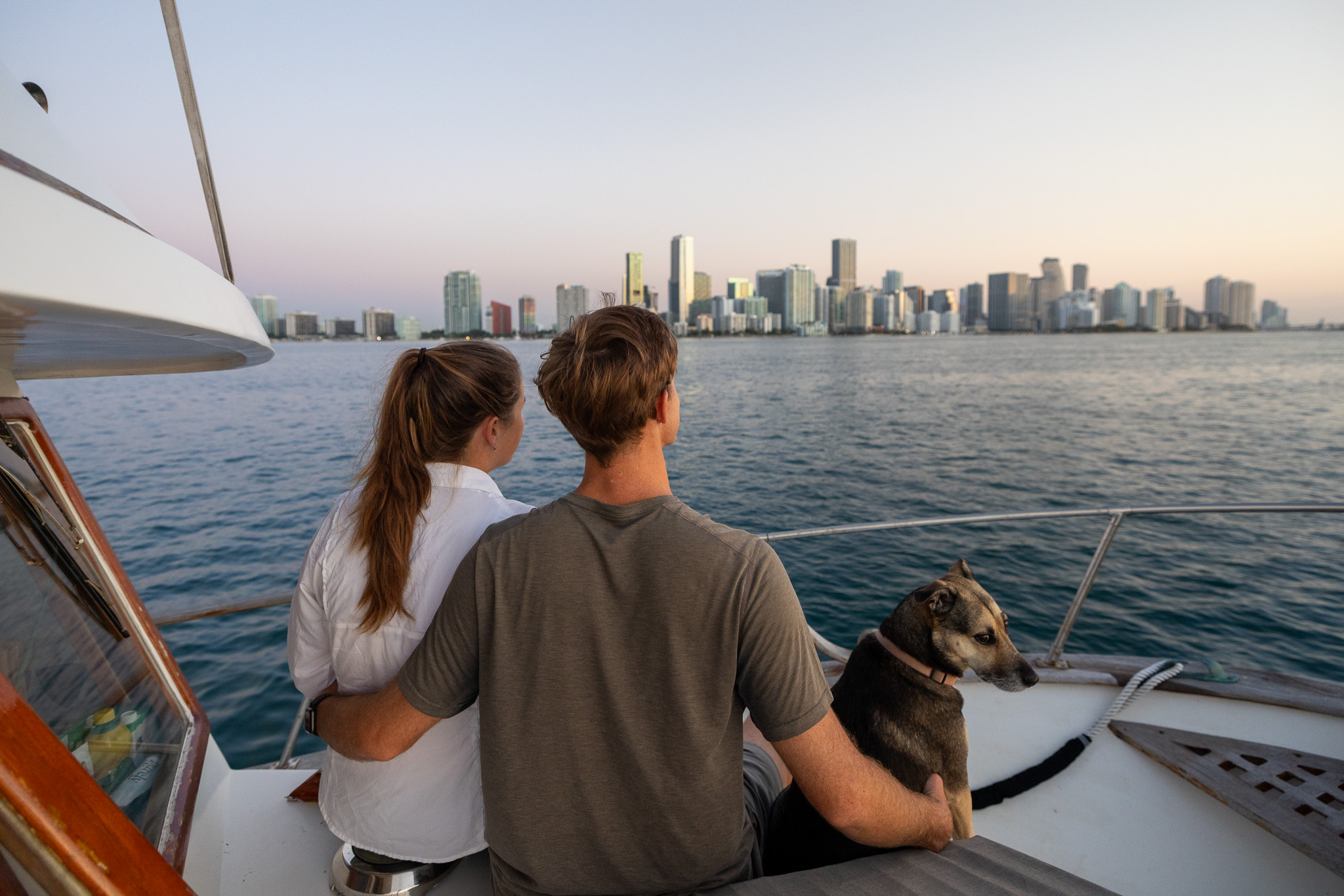
Our Experience Living on a Boat For 3 Years
We bought an old Trawler in January 2021 and lived on that boat until we sold her in September 2023. Our boating lifestyle consisted of full-time cruising, where we would stay in place for one night, all the way to our longest stay of three months! We traveled across the Eastern United States while journeying on America’s Great Loop , transiting almost 10,000 miles. Living on a boat is a stark difference from traditional land life, and here is the A-Z of what it meant for us!
Note: We use affiliate links which provide us a little kickback each time you use one of our links and make a purchase, without any additional cost to you. We do not recommend products that we don’t already love or have heard great things about, so you can trust we’re only suggesting great products to you .
Table of Contents
How We Started Living on a Boat
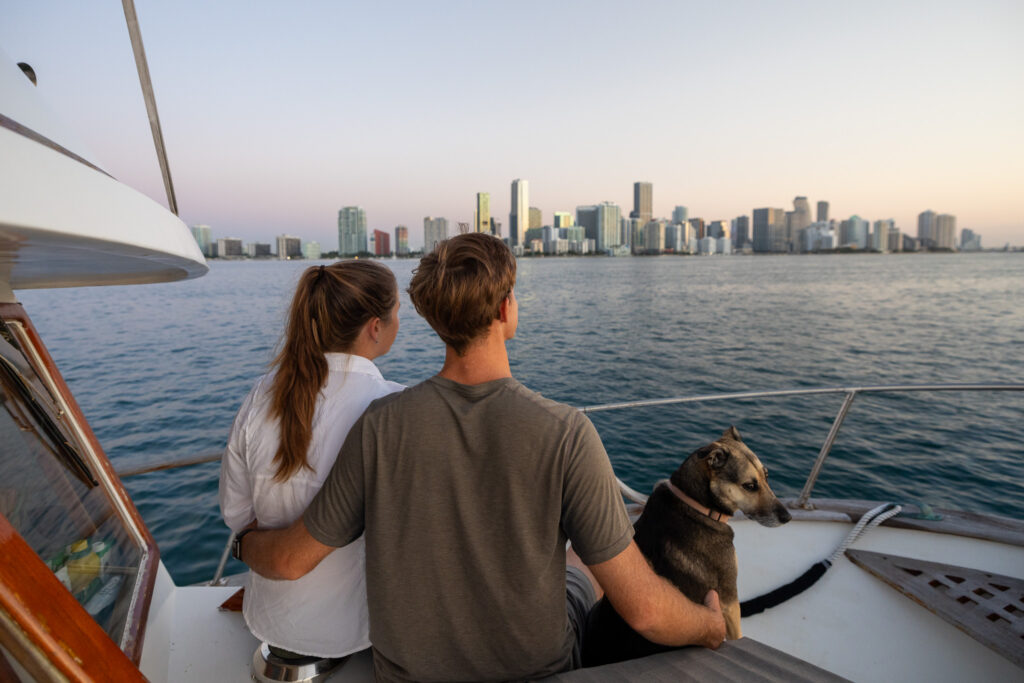
We started living on a boat after traveling abroad for a year and wanting to live and travel out of a tiny home. We didn’t know if we would like to live on a boat. So we bought a 1989 34′ Marine Trader Trawler that was within our budget. We chose a 34’ Trawler because it was large enough for Jennifer, me, and our 8-year-old dog, and it also met all the criteria for the Great Loop . We bought our Great Loop boat in a boatyard, did some work to paint the bottom, and got everything into ship shape before splashing and moving in!
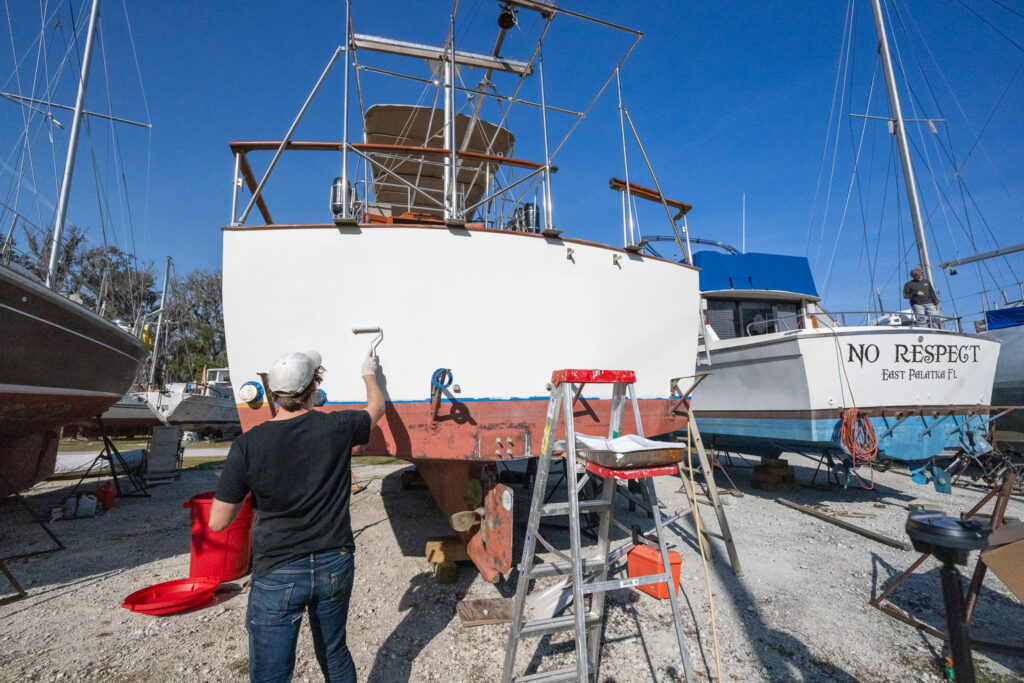
Although we did some online safety training before living on a boat, but by and large, we were very new to boating . We planned on learning as we go while living on a boat and that worked out fantastic. There isn’t a better way to learn than trying and being immersed daily. Looking back, we would hire a captain to ease our entry into handling a boat.
Our Daily Life Living on a Boat
Our daily life living onboard was a tale of two stories. The days we moved our boat were vastly different than the days when we remained in one spot!
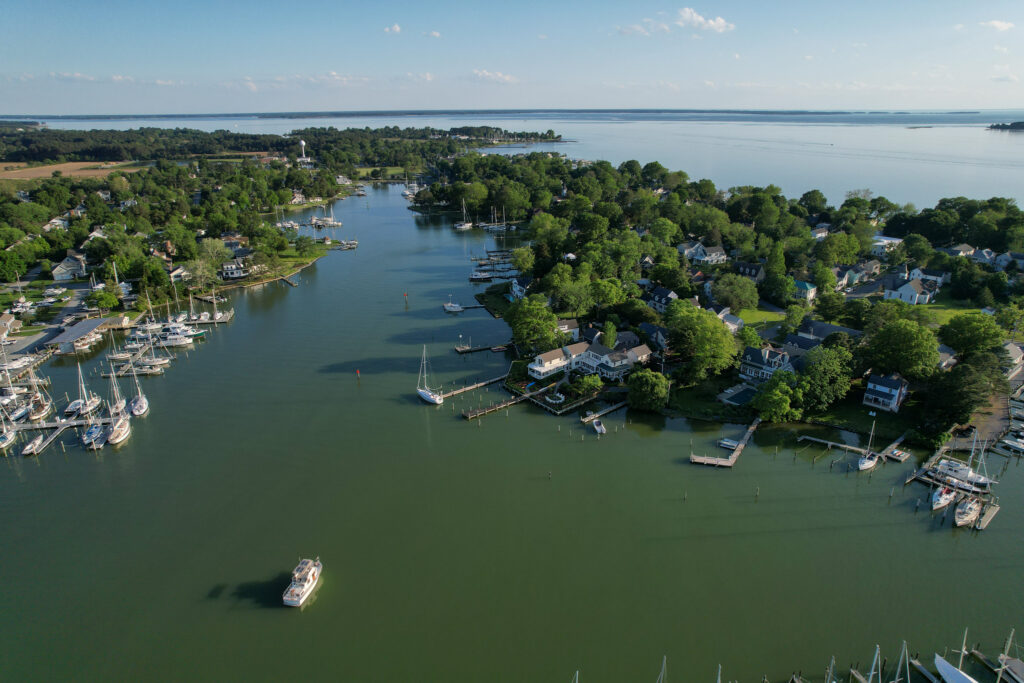
When we moved our boat , our daily life started very early. Typically, we would wake up right before dawn, check our engine, and prepare for the cruise. Living on a boat requires self-reliance and planning so these daily checks were very important to living on a boat comfortably. We would spend hours cruising the water before coming to our destination a few hours before sunset. After dropping the anchor at the end of a day on the water, we would divvy up our tasks: I would take the dinghy to shore with our dog , and Jen would begin cooking dinner. Finally, after a dog walk, we would enjoy a sunset dinner before heading to bed.
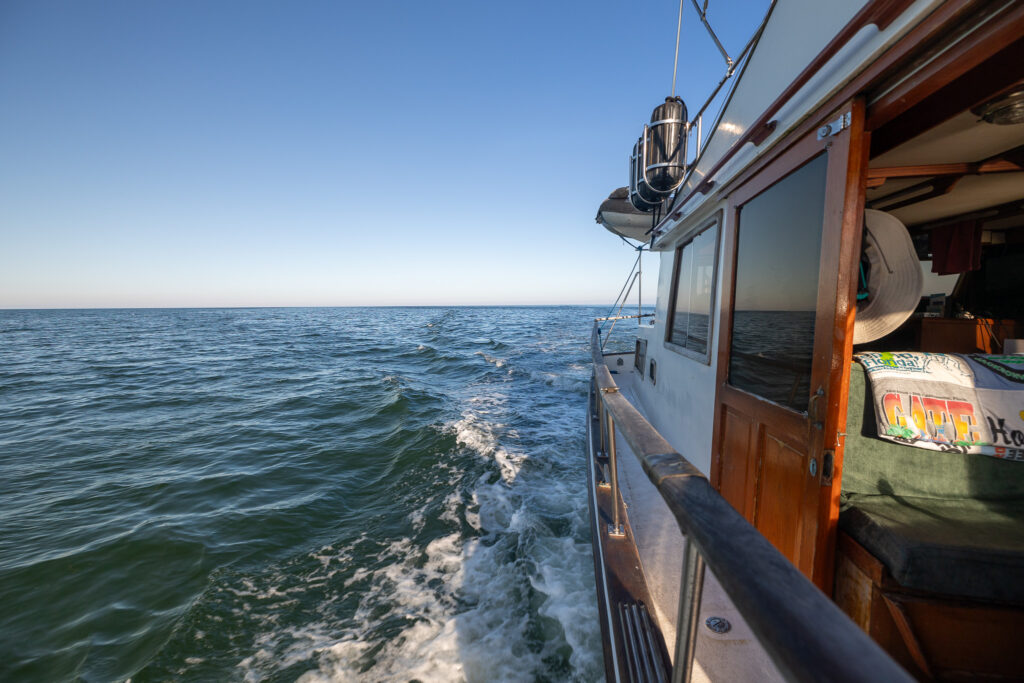
When we did not move our boat, we stayed at a Marina or on anchor , and relished in the moments. Our favorite times while living on a boat were the slow mornings watching the birds fly in the sunrise and the peaceful sunsets over the water. During the day, we would take our dog out a few times, get exercise, and work just like life on land! A key piece of being able to work on our boat is a solid electrical system and Starlink, meaning we could work anywhere!
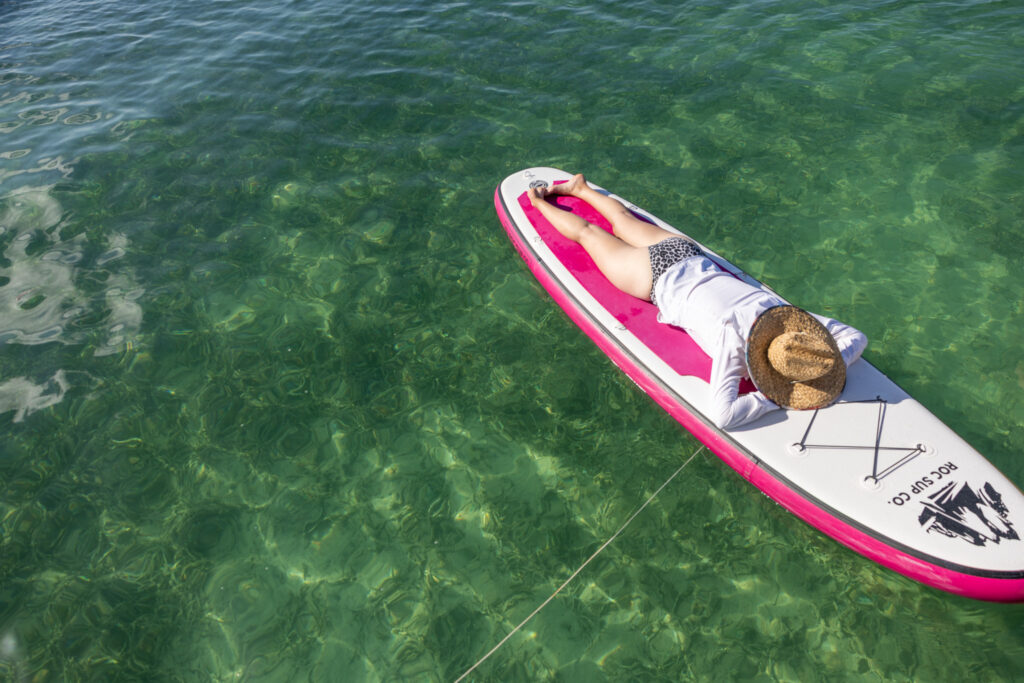
If you are interested in what setup we used to have enough electricity and power to work remotely, check out our Electrical E-book !
What We Loved Living on a Boat
Our favorite parts of living on a boat were the simplicity of life, being off-grid, enjoying a slower pace of life, and always having a new waterfront property to enjoy. Because we could move our home, we could travel comfortably and still cook, which we loved to do . We had all of our essential items , similar to life on land.

What We Disliked Living on a Boat
The worst parts about living on a boat are dealing with bad weather and the increased time any chore takes. For example, if you need to get groceries, take your dinghy to shore, catch a UBER, or walk to the grocery store and then reverse it all to get back with heavy bags of food. Then you must perform tetris in your boat galley, ensuring everything fits!
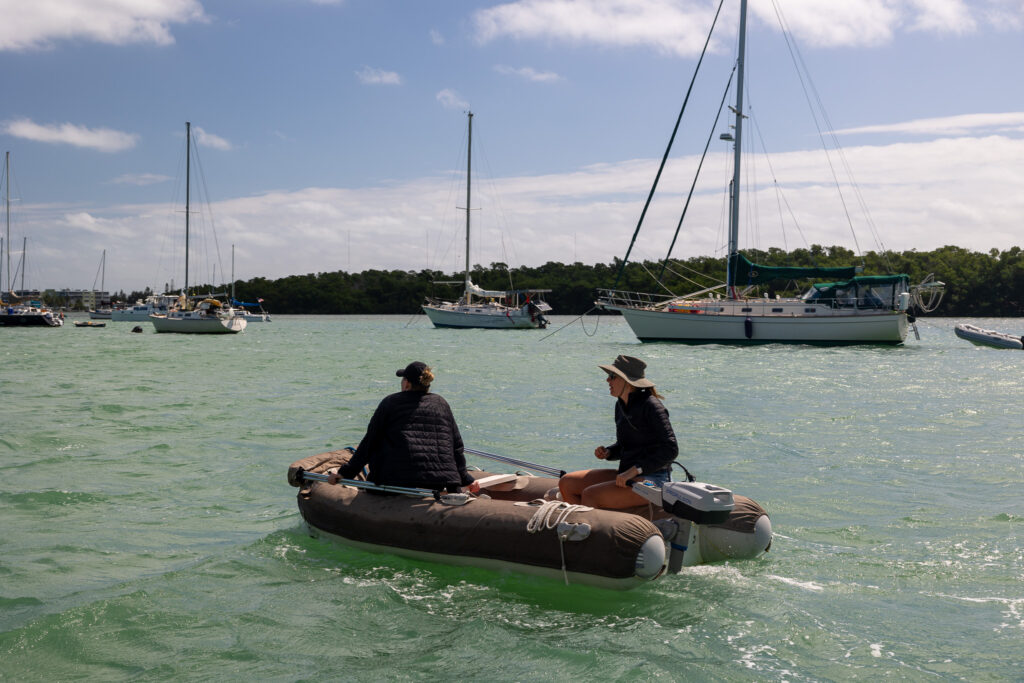
When living on a boat, you must constantly watch the weather forecast . If a bad storm is coming in or poor wind conditions, it may mean you have to move your home! Living on the water is beautiful but unforgiving, so we do what we can to have a safe and enjoyable time.
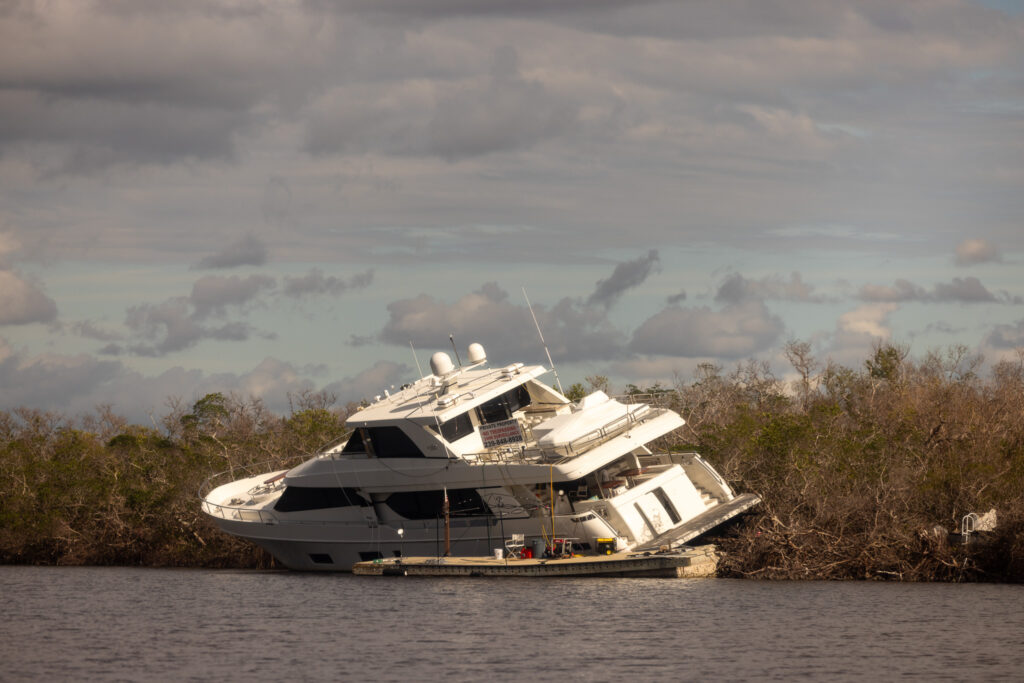
Read The Best Marine Weather Apps for Boating , including the apps we look at daily!
How much it costs living on a boat.
Living on a boat can be cheaper than living on land. This is because you save money on certain items like rent and car payments. We released how much exactly it cost us to live on our boat for a year in our monthly Great Loop Expense Reports . While you may not do America’s Great Loop, you can see how much some of the other parts of boat life cost, like marina stays, engine maintenance , repairs , and safety equipment!

Read next: 15 Tips for Boating on a Budget !
What is the Boating Lifestyle
Boating Lifestyle, just like any lifestyle, depends on the individual. You can live on a posh yacht or a small old sailboat that never leaves its anchorage! Our boating lifestyle consisted of adventure, traveling 10,000 miles around the Eastern U.S., peace and relaxation, spending hundreds of nights on anchor, and working full time.
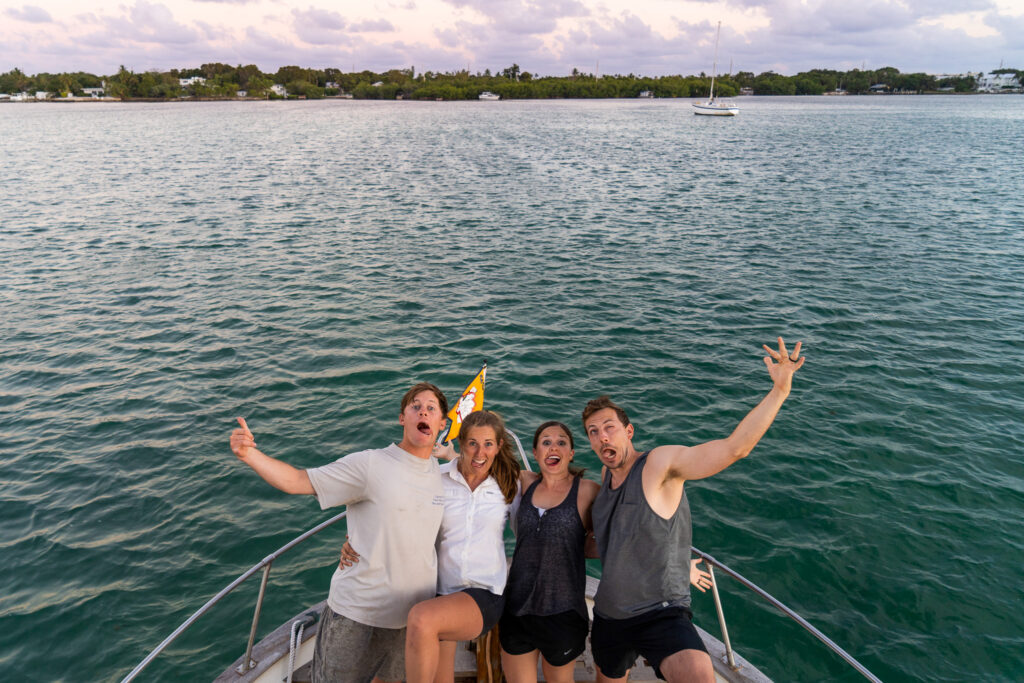
I Want to Live on a Boat, What’s Next?
Fortunately, it has never been easier to live on a boat. There are the minimum things that are required to live on a boat:
- The Boat (obviously)
- Enough money to afford safety equipment , insurance, maintenance , and repairs.
- Knowledge of how to maintain and cruise a boat
All of these are very obtainable with the right steps!
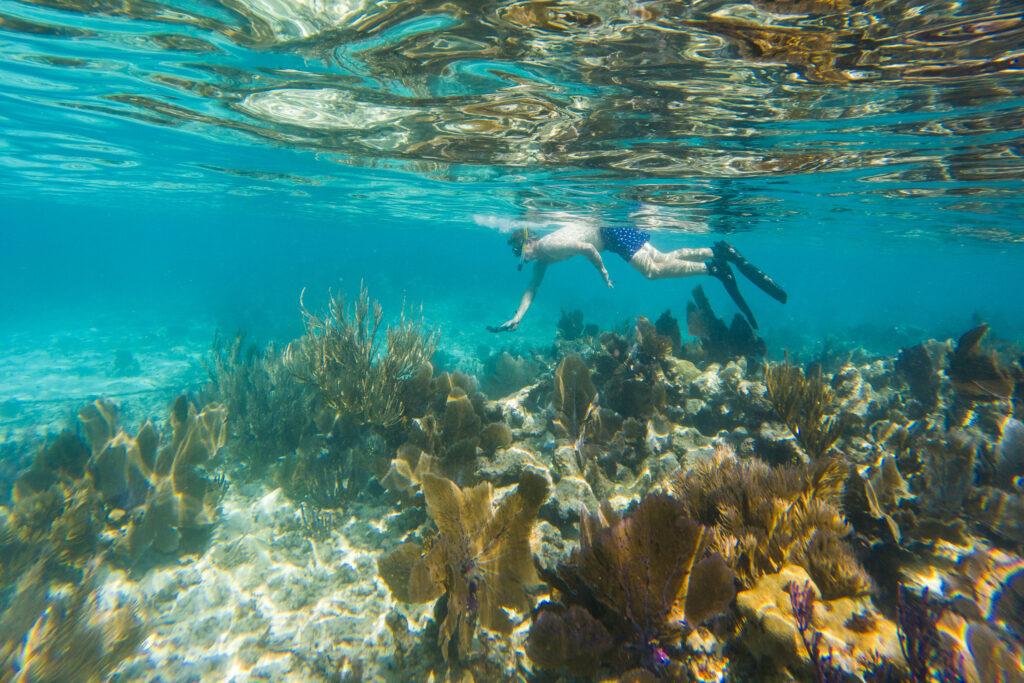
Here are Actionable Steps to Start Living on a Boat
- This will help you decide what type of boat to live aboard and give you lots of practical knowledge.
- Being surrounded by other boaters will help you learn from their experience. Sometimes, clubs will have race nights where captains let you help the crew after you begin sailing classes.
- If you are working, transition to a remote role.
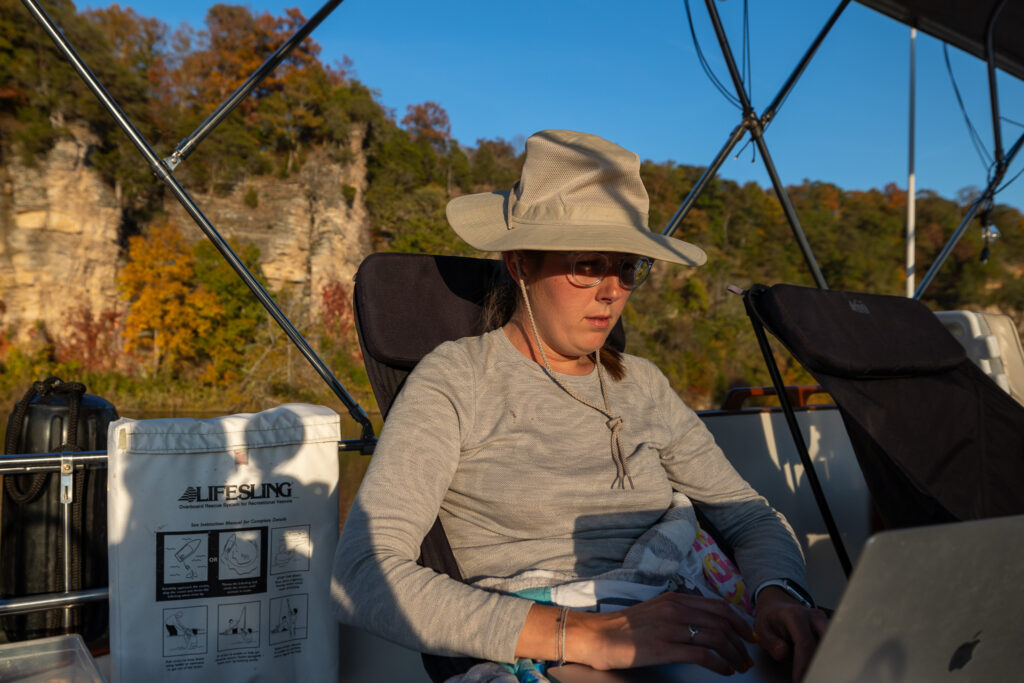
Living on a Boat Full-Time Compared to Living on a Boat Part-Time
You don’t have to live on a boat full-time; you can live on a boat for weekends or seasons at a time. The benefit of this approach is that you get the best of boat life by living aboard only when the weather is best, and in short periods, you miss a lot of the negatives about living on a boat. The tradeoff is that you need another home to spend the rest of your time, and a place to keep the boat when you are not onboard, which increases costs significantly!
Common Boat Life Questions
Do you need boating experience to live on a boat.
No! We started living on a boat with zero experience, and you can too. You can watch our YouTube videos for how it worked out for us. But as long as you take it slow and get mentoring, anyone can live on a boat.
Permissions and Rules
Living on a boat can sometimes carry some poor stigma. So it’s important to respect the rules if you decide to live on a boat. If you plan to spend the majority of time in one marina, ensure the marina allows liveaboards. If you plan to spend most of your time on anchor, ensure your boat is functional and well-maintained. Most municipalities require anchored boats to be functional to avoid derelict or abandoned boats. Respect laws when coming to shore and ensure you don’t trespass and dispose of trash properly.
The best boats for living onboard are tailored to your needs; a boat is just a series of compromises. There is no perfect boat . We wrote a blog post on the best boats for the Loop , which may help you on your journey.
Kids can also be raised living on a boat, but like everything, there is a series of tradeoffs. The big one is you trade off community and socialization (e.g., in school) for responsibilities and exposure to new circumstances. We recommend checking out boating YouTube channels like Sailing La Vagabond, who travel with their two kids to get a better glimpse.
What We Learned Living on a Boat
While living on a boat, we learned to take things slower and appreciate the small moments that make up our day. We also were welcomed to a new community of boaters which is a wonderful and friendly community.
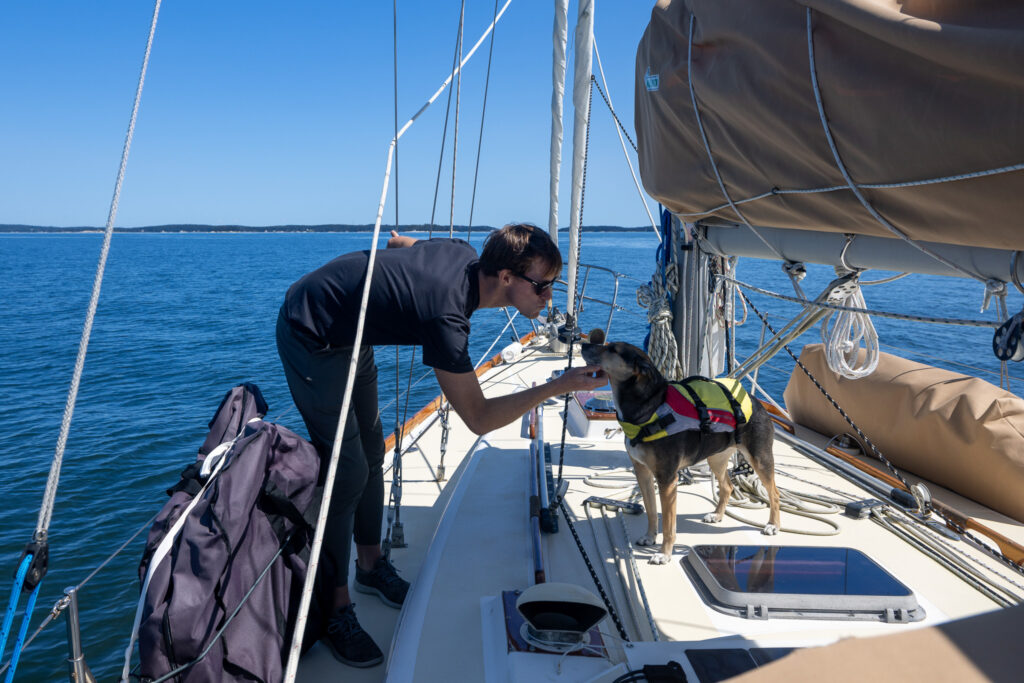
Save for Later
Save this to Pinterest to read again later!

The ups, downs, and everything in between , we share it all. If you like what you see, there are lots of ways to show your support and say thanks ! The easiest way to support our work is by commenting on this post, liking and sharing our content on Facebook, and pinning our content on Pinterest . It’s a small way to say thank you that goes a long way!
Elliot Schoenfeld
3 responses to “Our Experience Living on a Boat For 3 Years”
I’ve so enjoyed reading about and seeing your journey on your Sunday Summary emails and YouTube. Good luck on your next adventure! p.s. Hugs to Ollie!
Thank you for watching our videos and following along on our adventure! We really appreciate it 🙂
We are planning to travel the inland rivers this summer and have really enjoyed your journey, tips and story. Thank you. We are considering an ePropulsion motor like yours. We would appreciate your final opinion on it. Also, how did you secure it to the dingy when at the dock so that it was not stolen?
Leave a Reply Cancel reply
Your email address will not be published. Required fields are marked *
Save my name, email, and website in this browser for the next time I comment.
Notify me via e-mail if anyone answers my comment.
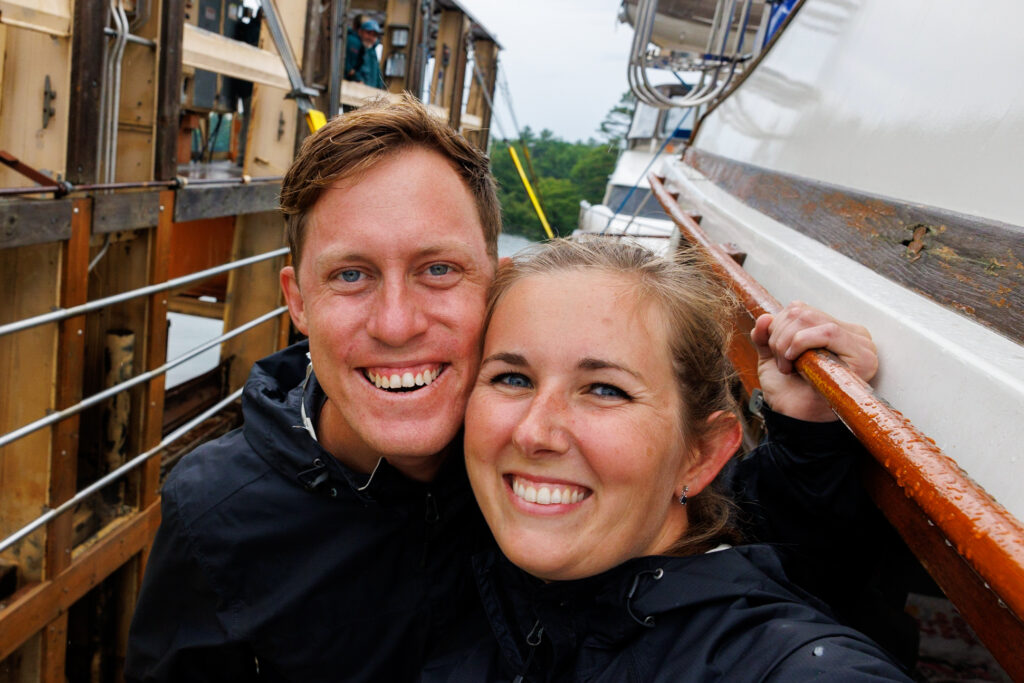
We’re Jen and Elliot , aka Scho & Jo, and we are happy to help plan your next Pivot! Sometimes, we’re forced to make decisions, and sometimes, we have time to plan them out; in all cases, Pivots are part of our lives, and we’re better off embracing them rather than avoiding them!

- TV & Film
- Say Maaate to a Mate
- First Impressions - The Game
- Daily Ladness
- Citizen Reef
To make sure you never miss out on your favourite NEW stories , we're happy to send you some reminders
Click ' OK ' then ' Allow ' to enable notifications

'Genius' man bought a flat on cruise ship because it's cheaper than home and he can travel the world
A man from san diego has decided to set sail from all his woes on land.
Poppy Bilderbeck
A man has revealed why it's ended up cheaper living at sea rather than on land.
With the cost of living crisis really continuing to crisis, many are looking for alternative ways to live to save a bit of money and ultimately live a more peaceful life and Austin Wells from San Diego worked out buying an apartment on a cruise would be cheaper than home on land. Watch below:
Wells revealed that he put down $300,000 (£238,000) on a 12-year lease studio apartment onboard the MV Narrative in an interview with CNBC in 2022.
Now, let's not deny it, this is still a hefty sum and far more than most of us could even begin to imagine having in our bank accounts now - or even ever - but compare it to rising house prices across the country - and don't get me even started on London - and Wells is laughing.
Not only this, but there's an array of amazing food to choose from while on board and you'll hardly get bored of the views out of the window when they're changing so frequently and you're sailing around the entire globe .
However, there's one small caveat.
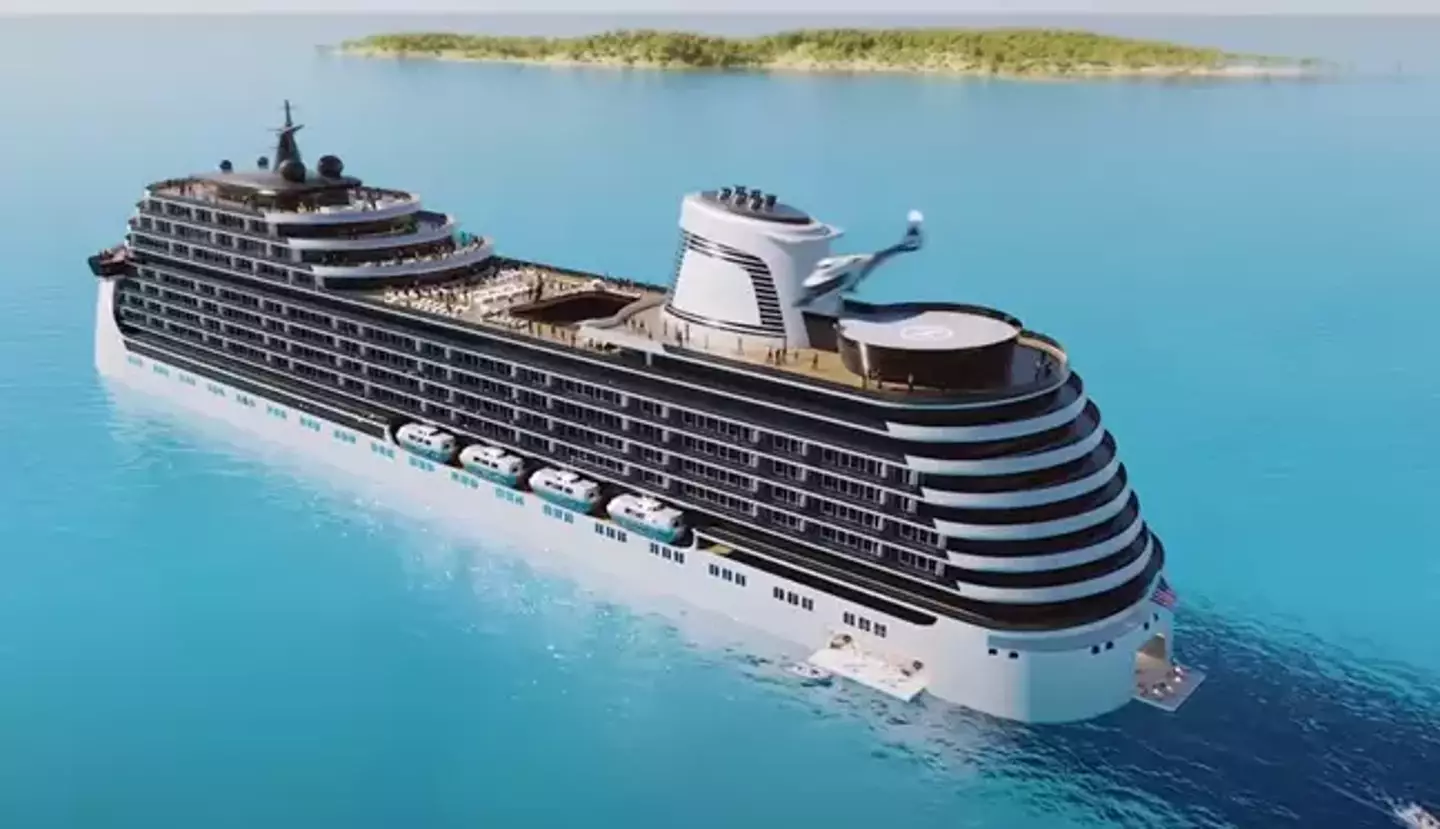
The ship is still under construction in Croatia and isn’t due to set sail until 2025.
But Wells certainly has more than enough to look forward to and dream of to make it through the rest of 2024, with the mega cruise ship boasting a whopping 500 private rooms and apartments, with Wells’ room spanning 237 square feet and features a desk, shower room, pantry and foldaway bed.
Those who live onboard full-time are also granted access not only to a private gym and farmer’s market, but also medical services, 24-hour room service and private kitchens.
What’s more, the ship plays host to 20 restaurants and bars, a school, a library, a bank, a cinema and a swimming pool.
But there's one thing which excites Wells 'the most'.

Wells shared: "The thing that most excites me is I don’t have to upend my daily routine, in order to go see the world.
"My working hours will be shifted towards evenings, nights and very early mornings, but that does open up the ability for me to see a city midday to afternoon.”
He added: "This is probably the first time ever that there is even the ability to have a standard job and even consider working and living from a floating apartment complex."

Wells also said he hopes he’s going to make lots of friends onboard seeing as he’ll be ‘travelling the world with them’.
According to The Sun, a flat in San Diego costs around $2,500 (£1,980) per month while Wells’ room on the MV Narrative will set him back about $2,000 (£1,587) per month.
The outlet notes that Alister Punton and Shannon Lee, the bosses of luxury residential ship brand Storyline, came up with MV Narrative because they ‘wanted to offer more affordable apartments for life at sea’.
Around 1,000 residents will call MV Narrative home when it sets sail in a year or so and there’ll be 11 different types of homes onboard.
Topics: Travel , US News
Poppy Bilderbeck is a Senior Journalist at LADbible Group. She graduated from The University of Manchester in 2021 with a First in English Literature and Drama, where alongside her studies she was Editor-in-Chief of The Tab Manchester. Poppy is most comfortable when chatting about all things mental health, is proving a drama degree is far from useless by watching and reviewing as many TV shows and films as possible and is such a crisp fanatic the office has been forced to release them in batches.
Choose your content:

IKEA’s Shouting Brekkie, So Gather The Fam And Throw On Your Favourite PJs
These are some deals you do not want to sleep on..

Brits warned about method to get 53 days off in 2025 using just 23 days annual leave
This method won't work for everyone.

Brits urged to fly to ‘Hawaii of Europe’ holiday island with year long summers and no UK time difference
It's a much shorter flight away but with stunning weather.

UK's cheapest Michelin restaurant where you can dine for as little as £3.50
Cheap fancy scran in london surely not.
- Man who's lived on cruise ships for more than 20 years can no longer walk straight on land
- Invite-only cruise ship that costs £2,000 per night launches in 2025
- Couple spend a year and a half on a cruise because it’s cheaper than paying for retirement home
- Mum goes on 48-hour holidays for £16 because it's 'cheaper than going around Manchester'
- Search Please fill out this field.
- Manage Your Subscription
- Give a Gift Subscription
- Newsletters
- Sweepstakes
- Food and Recipes
The “Cheap” Lunch My Grandmother Always Made Us, That I Still Make All The Time
It costs less than $5 and tastes like pure nostalgia.
:max_bytes(150000):strip_icc():format(webp)/Kaitlyn-Yarborough-2000-b9ba0c5b291d49b08647594678365883.jpg)
Why It’s So Good
- How To Prepare It
How To Dress It Up
Caitlin Bensel, Food Stylist: Torie Cox
Growing up, I spent many lunchtimes at my grandmother’s house, usually perched up at the counter stool watching her make me one of her signature lunches. In my mind, she was the queen of lunches. Yet, looking back, all of the meals I remember having often have three things in common: simple, Southern, and “cheap.”
Now, decades later, weekday lunches have become the bane of my existence. Not only do I not want a mess that needs cleaning up, but I also don’t want to spend inordinate amounts of money for a semi-healthy, hunger-staving lunch that I have to make myself. Which is why I often find myself turning back to my grandmother’s lunches, which look nothing like the delicate salads and fancy wraps that most folks seem to favor today.
Perhaps her most controversial—in a child’s mind, anyway—but most delectable in my opinion, was her cream-cheese-olive sandwiches. They consisted of her Southerner-approved cream-cheese-and-olive spread on fluffy white bread, sliced diagonally with the crusts cut off, so that they looked fit for a tea party. All in all, it comes out to under-$5 for a more-than-generous serving that I can enjoy at lunch and later. Thanks, grandma!
Cream Cheese and Olive Spread is a Southern classic. It’s made simply, starting with just two main ingredients: a block of cream cheese and a jar of olives. While that might seem a bit uninspired to first-timers, give it a taste, and you’ll regret ever thinking that. My grandmother’s version typically called just for the addition of generous sprinklings of Lawry’s garlic salt and black pepper—and that’s it. Simple, Southern perfection. Two pieces of sliced bread—or crackers if you prefer—and you’re ready to go.
As an adult, such an easy and cheap lunch is too good to pass up. Hence, why I’ve been whipping it up almost weekly like it’s my job. It never disappoints as lunch on a sandwich or a snack with Ritz crackers and sliced cucumbers.
How To Prepare It
Often, I’ll make a batch at the beginning of the week and dole it out as I see fit—as a sandwich one day, with crackers the next. Her recipe was simple for a reason, and it’s easy to keep all the ingredients on hand, particularly because it calls for so few ingredients that stay good for a while. Don't like olives? Use chopped or shaved cucumbers instead!
Cream Cheese and Olive Spread Recipe
- 1 block of cream cheese, softened (cost: around $2)
- 1/2 jar of pimiento-stuffed olives, roughly chopped (cost: around $2 for the serving)
- Worcestershire sauce, a couple dashes
- Garlic salt, as desired
- Black pepper, as desired
Stir all the ingredients together, season to taste, and you're all set.
There are many possible variations of this recipe that still keep it easy, affordable, and make-ahead-friendly. You can add chopped pecans for crunch, or a spoonful of mayonnaise for extra creaminess. You can double the recipe, which my grandmother often did, giving a jar of the extras to a neighbor.
Serve with hot sauce on the side for those who like a kick, which I sometimes favor when eating it with crackers. Sometimes, I'll add chilled smoked salmon (like the affordable Everything Bagel seasoned pack from Trader Joe's) onto the sandwich or crackers for extra protein.
Put simply, it pleases me for a quick lunch, and it almost always pleases a crowd. Except for olive haters–bless their hearts.
Related Articles
A couple left their home to move onto a residential cruise ship — see inside their cabin on Villa Vie Odyssey
- Angela and Stephen Theriac purchased a cabin on the residential cruise ship Villa Vie Odyssey .
- The ship plans to sail around the world every 3 ½ years. Its launch has been delayed by three months.
- The cheapest dual-occupancy cabin starts at about $100,000, with an additional $3,500 monthly fee.

Angela Theriac hit a turning point in 2018.
In a span of six months, her mom and oldest brothers died, her husband faced a health scare, and she underwent two surgeries.
She said her perspective shifted: She decided to stop taking life for granted, grinding every day at work, and wondering if she'd ever have time to see the world.
"You know what?" Theriac, 53, a retired schoolteacher, recalled saying at the time to her husband. "Let's go for this big adventure and live life to the fullest."
That mission drove Theriac and her husband of almost 30 years, Stephen Theriac, 53, to purchase a cabin in March on a residential cruise ship called the Villa Vie Odyssey . They bought the cabin just one week after learning about it in a YouTube video.
"Sometimes, you just got to be adventurous and do it," Stephen, a retired deputy sheriff, told Business Insider.
Mikael Petterson, the founder and CEO of Villa Vie Residences, told BI in an email on Monday that Villa Vie Odyssey would embark "any day now." The 509-cabin residential cruise ship plans to circumnavigate the world every 3 ½ years, sailing to 147 countries and 425 destinations along the way.
Petterson declined to provide a specific sail date, saying the ship is still waiting for "the green light from DNV . It's impossible to say which day exactly." DNV is a certification and risk-assessment firm for the maritime industry.
Villa Vie Odyssey promises amenities, including three restaurants, five bars and lounges, a pool, and a golf simulator.
The ship's comprehensive itinerary is a dream for retirees like Angela and Stephen, who say cruising is a "big passion." Destinations include Australia; South America; Walvis Bay, Namibia; and Singapore.
Related stories
Before moving to Nicaragua in 2011, the couple spent most of their lives in Florida and frequently took advantage of their proximity to some of the busiest cruise ports in the US .
They estimate they've boarded 50 cruises over the past 25 years, with the longest lasting 39 days.
"I really enjoy seeing new places, learning of new cultures, trying different food, and drinking different microbrews," Stephen said. "It's a great lifestyle."
The couple told BI they paid for the smallest, least-expensive cabin on the never-ending cruise , partly funded by an inheritance from Angela's mother.
(The couple said they signed a nondisclosure agreement and could not tell BI how much they paid for their accommodation. However, the cheapest dual-occupancy interior cabins start at about $100,000 with an additional $3,500 monthly fee.)
The Theriacs said they've already been to popular cruise destinations like the Caribbean and Mediterranean. They're excited to go further — New Zealand for Stephen and tropical destinations like Bali, Indonesia, and Fiji for Angela, a self-proclaimed "water girl."
They said they have plans to rent their home in Nicaragua to a close friend.
The Odyssey cabin features twin beds and a vanity
The couple started decorating their floating condo with pillows, artwork, and "personal touches emphasizing storage," Angela said. "Our room is our bedroom, and the ship is our home."
But there's a caveat — while they can spend their days aboard the ship, they're not yet allowed to stay overnight.
The never-ending cruise was initially scheduled to set sail in May from Belfast, Ireland, following Villa Vie's acquisition of Fred Olsen Cruise Lines' more than 30-year-old Braemar vessel, now renamed Villa Vie Odyssey. However, Villa Vie has said issues like the aging ship's rudder stocks and recertification have since delayed its departure by three months.
Like many other would-be Villa Vie residents, the Theriacs flew to Belfast for the initial springtime departure date. Since then, the couple said they've been staying at hotels — including some a flight away in Liverpool, UK, where they say the nightly cost is cheaper — and spending time on other cruises.
Petterson said the Florida-based Villa Vie also provided residents with shuttles to and from the ship, food, drinks, excursions, and lodging — or a daily per diem for those who "choose to do their own thing."
But the couple has been patient and understanding of the delays — because, according to Stephen, "it's a now-or-never kind of thing."
"We're still in pretty good health and financially fine," Stephen said, reflecting on the sight of "80-year-olds getting off Princess ships in walkers." "I don't want to be that old and try to see the world. I want to do it now while I can still enjoy it."
Villa Vie would be the first ship of its kind in 22 years
Villa Vie isn't the only startup that has faced difficulties while trying to launch a never-ending voyage.
The residential-cruise industry has been plagued by issues since the inauguration of The World, the only ship of this kind, in 2002.
Startups trying to launch floating condominiums have since popped up as quickly as they've sunk — from Miray Cruises' Life at Sea Cruises , which shut down two weeks before it was supposed to embark in November, to Storylines , which has delayed its departure by seven years to 2026.
Miray's former CEO, Kendra Holmes, recently launched GlobeCruises, a concept similar to Life at Sea's three-year cruise , scheduled to sail in April.
GlobeCruises and Villa Vie are the only options vying to join The World in its extended voyage around the globe.
Are you sailing on a residential cruise ship like Villa Vie or have a tip? Contact the reporter at [email protected] or on X @brittanymchang .
Watch: Cruise ship captain breaks down 8 cruise ship disasters in movies and TV
- Main content

How to Retire on a Sailboat

Last Updated by
Daniel Wade
June 15, 2022
Living on a sailboat is a rewarding and affordable way to enjoy your retirement.
In this article, we'll cover the basics of how to retire on a sailboat, including the typical cost and other considerations. We'll also cover the top destinations for liveaboard retirees, along with how to complete daily tasks while living aboard. We’ll also show you how to find the best sailboat to retire on.
The best way to retire on a sailboat is to purchase a larger boat that's in good condition and to dock it at an affordable marina. Buying a new boat can make retirement easier and safer.
This article is primarily based on the experience of retired people who currently live on sailboats. We also sourced information from organizations such as the AARP.
Table of contents
How Much does it Cost to Retire on a Sailboat?
Cost is a major consideration during retirement. Sailing is commonly perceived as a luxury activity, so many people are surprised to learn just how affordable it can be. Here, we'll break down some of the biggest liveaboard sailing expenses to help you get a general idea of what to expect.
The Boat Itself
Generally speaking, the boat itself is the greatest overall expense. And when you think about it, it makes sense to spend more on a nicer boat initially so you can spend more time enjoying it and less time fixing it.
If you already have a comfortable sailboat, you don't have to worry about the initial cost. So, how much does a sailboat cost? A well-maintained used sailboat that's suitable for retirement costs anywhere from $15,000 to $50,000 depending on the size, type, and age.
Considering that you'll be living aboard, purchasing a comfortable sailboat is considerably more affordable than buying a retirement condo or home pretty much anywhere in the country. To put it into perspective, the cost of a quality liveaboard sailboat is comparable to the cost of a used single-wide mobile home in many places.
If you're considering a brand new sailboat, the costs are considerably higher. The typical cost of a larger new cruising sailboat exceeds $125,000. We'll use a brand new 31-foot Catalina 315 as an example.
The manufacturer's suggested retail price (MSRP) of this sailboat is $163,000, which is about average for a boat of this caliber. The base MSRP is just for the base-model boat itself. In most cases, a well-equipped Catalina 315 leaves the dealership ready-to-sail for about $215,000 to $225,000.
New Sailboat vs. Used Sailboat
Why would anyone consider spending upwards of $200,000 on a liveaboard sailboat? Actually, there are numerous reasons to consider purchasing a new sailboat for retirement. Modern technology has radically transformed sailing, and new sailboats come equipped with the latest comfort, convenience, and labor-saving options.
On many new vessels, almost all of the rigging can be controlled electrically from the cockpit. Everything from raising the sails to lowering the anchor can be automated, which eliminates the laborious and hazardous aspects of sailing.
Additionally, these vessels come with clean and modern cabins and all the necessities, such as spacious bathrooms, electrical outlets, sound systems, lighting, and cooking facilities. And since it's new, you're not likely to have any problems with it for a long time.
Used sailboats have benefits too, the most obvious of which is the price. Fiberglass sailboats between 25 and 45 feet in length have been manufactured since the 1960s, and there are still many well-preserved examples for sale.
A used sailboat from the 1970s or 1980s can save you a significant amount of money, provided you're willing to spend more time maintaining and repairing it. Don't expect too many bells and whistles on these vessels, but many modern convenience and safety features can be retrofitted with relative ease.
Insurance is a factor that a lot of people fail to consider when living aboard a sailboat. Boat insurance isn't usually mandated like car insurance, but it's a valuable thing to have. Thankfully, sailboat insurance is one of the least expensive necessities for liveaboard retirees .
The average price of sailboat insurance is just a few hundred dollars per year. The price varies based on several factors, including the value of your boat. For a typical used sailboat that's worth about $25,000, your annual insurance cost will be about $350.
As a rule of thumb, you can expect insurance to cost 1.5 to 3 percent of the value of your vessel.
The cost of insurance for a brand new boat will obviously be higher, but there are several ways you can reduce your rate. These include bundling your car insurance (if you choose to continue driving), and you can take sailing or boating training courses. Each insurance company has different requirements for discounts, so be sure to shop around.
The best boat insurance companies are BoatUS (which offers towing and other marine services), United Marine Underwriters, along with traditional auto indemnity companies such as Allstate, Nationwide, Progressive, and Geico. Many liveaboards choose to insure their boats with a marine insurance company such as BoatUS, as these companies offer nation-wide water services such as towing and repair.
Docking and slip fees are often the highest recurring expenses for liveaboard retirees. These are usually paid monthly, though some marinas work out long-term rates with liveaboards.
Slip fees cover the cost of docking your boat at a marina or yacht club, and they usually don't include club membership fees. Utilities are often included in the price as well, which simplifies monthly bill paying.
On average, the cost to dock a liveaboard sailboat ranges from $600 to $3,000 per year. This is considerably cheaper than rent in most places. That sail, slip fees vary widely between locations and cities. Some marinas charge per foot of length, with prices ranging from $5 per foot to upwards of $300 per foot per year. Next, we'll take a look at the average cost to dock a typical sailboat in five major U.S. coastal cities.
Slip Cost in Miami
Florida is an extremely popular destination for retired liveaboard sailors, and there's an enormous amount of docking infrastructure there. In big cities such as Miami, the cost to get a slip at a decent marina ranges from $1,000 per year to $5,000 per year.
Slip Cost in Cape Cod
The atmosphere in Cape Cod is about as far removed from Miami as you can get. Prices for slips in New England vary widely, but the typical price in Cape Cod starts around $5,000 to $6,000 per year.
Slip Cost in Galveston
The Texas coastline is famous for reasonable docking prices, though costs have increased over the years, and it's not the bargain that it used to be. That said, you can usually find a slip for between $2,000 and $5,000 per year, depending on the marina and how long you stay.
Slip Cost in San Francisco
San Francisco is one of the costliest places to dock in the United States, The most affordable slips in the city rent at an average rate of $18.00 per foot, meaning that a 30-foot sailboat would cost about $6,480 per year. Nevertheless, that's still highly affordable compared to housing costs in the city.
Slip Cost in Chicago
The Great Lakes are an excellent place to live aboard a sailboat, provided you can deal with the cold. The typical cost to dock a sailboat in the city is between $2.00 and $4.00 per foot per month, adding up to between $720 and $1,440 per year.
Utilities are another factor to consider before moving onto a sailboat. Utilities are included in the cost of the slip at some marinas. And while many others don't meter your usage, they may charge an extra monthly fee to allow you to access power and water hookups. Most sailors find that they use much less power and water while living on a boat, which reduces utility expenses significantly.
Property Taxes
Some states and localities charge property taxes for liveaboards. Some states, such as Florida, charge a 6% personal property tax on sailboats. Be sure to check with a local tax attorney to better understand what (if any) tax obligation you could face.
Fuel is an expense to consider even if you don't plan on going anywhere. Sailboats are never hooked up to city gas lines, so you'll need to purchase stove and heater fuel separately. Most sailboats have liquid-fuel stoves and heaters, which run on diesel, kerosene, or alcohol. It's wise to factor in an additional monthly fuel cost of $50 to $150. These figures can double during the winter, especially if you have a large boat.
Repairs and Maintenance
Repairs can quickly increase the cost of living on a sailboat. This is why many people opt to purchase a new boat and ditch the hassle of downtime and repair costs .
Regular maintenance itself is responsible for the majority of these costs. Hauling out, which is necessary to annually scrape the bottom, costs between $20 and $30 per foot. This is without the added cost of scraping or painting the bottom, which costs between $1,000 and $3,000. The total cost of yearly maintenance averages out to about $2,700.
Registration
Registering a sailboat is fairly inexpensive in most places. In most states, you can renew your tags for between $100 and $200 if you have a sailboat under 40 feet in length.
Total Cost to Retire on a Sailboat
Based on everything we've covered, the total cost to retire on a sailboat ranges from $5,000 to $10,000 per year, not including the purchase price. Below, we put together a chart of annual sailboat costs along with the initial price of a used and brand new 31-foot sailboat.
| Sailboat Type | New 30-Foot Sailboat | Used 30-Foot Sailboat |
|---|---|---|
| Purchase Price | $215,000 | $20,000 |
| Registration | $110 | $110 |
| Insurance | $3,225 | $300 |
| Slip Fees | $2,000 | $2,000 |
| Utilities | $360 | $360 |
| Fuel (Heating, Cooking) | $450 | $450 |
| Total With Purchase | $221,145 | $23,220 |
| Annual Total | $6,145 | $3,220 |
Health and Mobility
Health and mobility are essential factors to consider before moving onto a sailboat. Even the largest sailboats have tight passageways in some places, and the majority of boats have one or two steep steps in the entryway.
If you're still able to perform normal tasks such as climbing stairs and driving, you should have no trouble getting around on a sailboat. Living aboard on the dock is a relatively easy and low-risk proposition.
Embarking on long sailing trips, on the other hand, requires more careful consideration. The best thing to do is to get regular physical evaluations and to talk to your doctor prior to embarking on an extended voyage.
Oxygen tanks and similar long-term treatment devices can be extremely hazardous to use on a sailboat, so those needing long-term daily treatment may want to consider a more spacious powerboat or limiting their boating to occasional excursions. Again, each case is different, so check with your doctor to evaluate your specific circumstances.
Extended Retirement Voyages
Many retirees choose to make extended passages on their sailboats. Everything from local island-hopping to circumnavigation is well within the realm of possibilities to an experienced sailor or retired couple, and numerous groups exist related to this topic.
Recently, Ronna Benjamin and her husband Mike published their sailing chronicles in the AARP "Disrupt Aging" column . Mike, an experienced sailor in his 60s, bought a 49-foot sailboat with his wife and sold their home of 30 years to pursue their dreams of sailing the world.
At one point, Ronna recalled meeting a retired liveaboard couple in the 1990s who lived aboard their boat and enjoyed the tropical environment. Ronna and Mike aren't alone, as the Internet is full of thousands of stories about retirees making long offshore passages and exploring the world on their sailboats.
The most popular destinations for retired sailboat owners are the Bahamas, Hawaii, and various remote Pacific islands such as Fiji. With proper planning, any experienced sailor in generally good health can safely mate these passages, provided they have a well-kept boat that's up to the task.
Keeping Up with Family and Friends
Many retired people worry about giving up-close contact with family and friends if they move onto a sailboat. But in reality, there's no reason why you have to sacrifice relationships to move onto a boat.
This is especially true if you choose a sailboat with a spacious interior. Sailing itself is an excellent way to spend time with friend9, kids, and grandkids. Retirees who live aboard can use it as an opportunity to move even closer to family members, provided that they live near the coast, a river, or a large navigable waterway.
How to Perform Daily Tasks when Retiring on a Sailboat
Retiring aboard a sailboat can make daily tasks such as cooking and doing laundry a bit more challenging. However, where there's a will, there's a way, and malty sailors have already cracked the code. Here's how to make daily tasks easier when retiring on a sailboat.
Here's a great opportunity to simplify your cleaning supplies. On a sailboat, limited space means it's best to find cleaning equipment that serves multiple purposes. A high-quality dust-buster vacuum can replace a large broom, and it can also keep pet hair under control. When finding cleaning supplies for your boat, think small and utilize products that make the most out of limited space.
Cooking aboard a sailboat is much like cooking in a house, except everything is scaled down. Most sailboat galleys have a stove, az oven, a sink, and a refrigerator, but you'll have to downsize your meals and silverware collections. The upside is that it encourages healthy portion sizes, and it's much easier to stay clean and organized.
Laundry can be challenging aboard a sailboat. Some liveaboards do their laundry manually and dry it on the rigging, but this is much too laborious for most people to consider. Thankfully, most full-service marinas offer laundry facilities for a reasonable price. And if your marina doesn't, you can always drop your clothes off at a laundromat or dry cleaning shop.
Bathing is one activity that you won't have to make too much of a sacrifice with, as most modern sailboats come with spacious heads (bathrooms) and on-demand hot water.
Some larger sailboats have more than one head, and others feature a master bathroom with a shower and bathtub combination. You probably won't find a full-sized bathtub aboard a typical sailboat, but tubs are available on many sailboat models today.
How to Find the Best Retirement Marina
How do you choose the best marina for retirement? There isn't a huge number of retired liveaboards, so there aren't any marinas specifically oriented towards retirees. That said, there are many excellent marinas that cater to liveaboards of all kinds.
The first thing to do when choosing a marina is to make sure that they allow liveaboards in the first place. High-end yacht clubs usually discourage the practice due to aesthetic concerns. That said, regular marinas are split about 50/50, and many welcome liveaboards. The easiest way to find out is to call ahead.
The next factor to consider is location. Is the marina within a reasonable distance of shops and medical facilities? Also, it's a good idea to check out the marina and the surrounding area in person to make sure you don't end up in a bad part of town.
Another factor to consider is the condition of the marina and how it's designed. Accessibility is important, as is the condition and safety of the docks. Run-down marinas and docks filled with derelict boats are common and should be avoided. If you like the marina, see if you can talk with some of the residents to get their opinions on the management.
The residents themselves are the final consideration. What kind of people occupy the marina, and do they seem friendly? It's important to gauge the neighbors before renting a slip, just to make sure you'll get along with the people you'll see every day.
How to Choose the Best Sailboat for Retirement
Choosing a boat is one of the most important and exciting parts of the process. Before you begin searching, it's helpful to decide what you're going to do with the boat, how much space you need, and how much you're willing to spend.
Sailboat Size
Most people would agree that the smallest practical liveaboard sailboats are around 30 feet in length. Many people live on smaller boats, but cramped conditions can become a serious hassle over time. When it comes to retirement, bigger is almost always better.
When it comes to sailboat length, 35 to 40 feet seems to be ideal for most people. Additionally, a boat between 30 and 60 feet in length will fit in most marina slips, and it will likely be seaworthy enough for any reasonable passage.
Unless you're looking for a project boat, it's usually best to spend a little more upfront on a nicer boat that doesn't need any major repairs. It's pretty easy to tell if a vessel has been cared for, so avoid used boats with any signs of mold, rot, or neglect.
Configuration
Sailboat configuration is another factor to consider before purchasing a boat. Configuration covers things like sail plan, cabin layout, and hull type. Here are a few examples of sailboat configurations.
Most sailboats are fiberglass Bermuda-rigged sloops with a single cabin forward of the cockpit. These vessels are common because they work very well, and most people enjoy their practicality and sailing characteristics.
Traditional sailboats have more complex rigging and require more maintenance, but some of them are more seaworthy and elegant. It all comes down to personal preference.
If retiring and living aboard is the goal, it's essential to consider the layout of the cabin. The best way to judge a sailboat cabin is to actually go inside of it and try to picture yourself living in it long-term. Niche vessels such as catamarans of aft-cabin monohulls are often more trouble than they're worth, as facilities are often separated and require going up on deck to reach.
Features and Comfort
Modern sailboats come packed with modern technology, which adds an enormous amount of features and improves comfort. But virtually all sailboats sold on the consumer market prior to 2000 seem spartan in comparison. Here's a list of helpful features that many newer boats offer.
- Automatic power control systems
- Automatic and dimmable lights
- Automatic climate control
- Air conditioning
- Integrated WiFi
- Integrated navigation
- Sound systems
- Dimmable windows
- Power winches
- Power halyards
- Solar or wind power generators
Some people prefer simpler systems, as they're easy to use and maintain. But by doing so, you may sacrifice comfort and miss out on many of the great labor-saving devices that are available on sailboats today.
Sailing Characteristics
The final major consideration when choosing a sailboat is its sailing characteristics. Factors that affect how a boat sails are its size, hull shape, rig, and displacement. For example, a heavy-displacement sailboat with a full keel and a wide beam will sail slower than most vessels.
However, this type of sailboat will also be more forgiving and offer superior comfort and safety in rough weather.
On the other hand, a lighter sailboat with a fin keel and a narrow beam has characteristics more aligned with a racing vessel. This boat will be fast and agile, and it offers great responsiveness, but it will probably be less comfortable in rough weather.
Related Articles
I've personally had thousands of questions about sailing and sailboats over the years. As I learn and experience sailing, and the community, I share the answers that work and make sense to me, here on Life of Sailing.
by this author
Most Recent

What Does "Sailing By The Lee" Mean?
October 3, 2023

The Best Sailing Schools And Programs: Reviews & Ratings
September 26, 2023
Important Legal Info
Lifeofsailing.com is a participant in the Amazon Services LLC Associates Program, an affiliate advertising program designed to provide a means for sites to earn advertising fees by advertising and linking to Amazon. This site also participates in other affiliate programs and is compensated for referring traffic and business to these companies.
Similar Posts

How To Choose The Right Sailing Instructor
August 16, 2023

Cost To Sail Around The World
May 16, 2023

Small Sailboat Sizes: A Complete Guide
October 30, 2022
Popular Posts

Best Liveaboard Catamaran Sailboats
December 28, 2023

Can a Novice Sail Around the World?
Elizabeth O'Malley

4 Best Electric Outboard Motors

How Long Did It Take The Vikings To Sail To England?

10 Best Sailboat Brands (And Why)
December 20, 2023

7 Best Places To Liveaboard A Sailboat
Get the best sailing content.
Top Rated Posts
Lifeofsailing.com is a participant in the Amazon Services LLC Associates Program, an affiliate advertising program designed to provide a means for sites to earn advertising fees by advertising and linking to Amazon. This site also participates in other affiliate programs and is compensated for referring traffic and business to these companies. (866) 342-SAIL
© 2024 Life of Sailing Email: [email protected] Address: 11816 Inwood Rd #3024 Dallas, TX 75244 Disclaimer Privacy Policy
Superyacht sinks latest: Investigators reveal where bodies were found as probe looks at 'crew's responsibility'
Italian officials revealed at a news conference there could be "a question of manslaughter" as they opened a shipwreck investigation and said the probe is also looking at the "crew's responsibility".
Saturday 24 August 2024 18:33, UK
- Superyacht sinking
Please use Chrome browser for a more accessible video player
- Prosecutor: There 'could be a question of manslaughter'
- Probe 'concentrating' on crew's responsibility
- Seven bodies recovered after five-day search of superyacht wreckage off Sicily
- Saturday's papers pay tribute to youngest victim Hannah Lynch
- Hannah's sister pays tribute to 'my little angel'
- Explained: Inside the superyacht | What challenges have faced divers?
- Eyewitness: Sombre scenes greet rescue teams as final body is brought ashore
- Live reporting by Niamh Lynch
We're ending our live coverage for this evening but here is a recap of what we know:
- Prosecutors have opened a manslaughter investigation into the Bayesian sinking;
- Officials have revealed more details on their investigation and the difficult five-day rescue mission;
- The six bodies found during the search in recent days were all in cabins on the left-hand - and highest - side of the ship. Five were found in the first cabin and the sixth was found in the third;
- Prosecutors said the six passengers were most likely asleep when the boat sank;
- The probe is now focusing on the crew and their responsibilities, with the captain set to undergo more questioning.
Monday 19 August
The Bayesian yacht, flying a British flag, sinks at around 5am local time when the area was hit by a tornado.
Fifteen people are rescued from the 56 metre vessel - including a mother and baby - but another seven remain missing.
One body, later confirmed to be the yacht's chef Recaldo Thomas, is found near the wreck.
It emerges that British technology tycoon Mike Lynch and his 18-year-old daughter Hannah are among six people that remain missing.
Tuesday 20 August
The search continues for the six tourists missing.
It is reported that among those missing are Morgan Stanley International chairman Jonathan Bloomer; his wife, Judy Bloomer; Clifford Chance lawyer Chris Morvillo; and his wife, Neda Morvillo.
Police divers try to reach the hull of the ship, resting at a depth of 50 metres.
Italy's fire brigade Vigili del Fuoco say early inspections of the wreck were "unsuccessful" because of limited access to the bridge and furniture obstructing passages.
The operation is later described as "complex", with divers limited to 12-minute underwater shifts.
Tributes pour in for Mr Thomas, with his friend Gareth Williams saying: "I can talk for everyone that knew him when I say he was a well-loved, kind human being with a calm spirit."
Wednesday 21 August
The search for the six people unaccounted for enters a third day, with crews carrying out inspections of the yacht's internal hull.
A team of four British inspectors from the Marine Accident Investigation Branch (MAIB) arrive in Porticello to look at the site of the sinking.
A helicopter is drafted in to help with the search effort and remotely controlled underwater vehicles are being used, with naval units and cave divers also taking part in the search.
Five bodies are found inside the yacht on Wednesday afternoon. Only four of them are brought to shore.
Body bags are seen being taken to Porticello in the afternoon where dozens of emergency services staff wait.
Searches finish for the day just before 7.30pm.
Thursday 22 August
The search resumes for the remaining missing person.
The body of the fifth missing person, found but not recovered the previous day, is brought to shore.
A fire service boat with flashing blue lights returns with a blue body bag to the port of Porticello just after 8.45am local time on Thursday.
Tributes pour in for Mr Lynch and Mr and Mrs Bloomer after they are identified as having died.
The search is called off at around 8pm in Sicily, with divers expected to begin again at 6.30am on Friday.
Friday 23 August
The search continues for the final person missing from the wreck of the Bayesian, Hannah Lynch.
Vincenzo Zagarola, of the Italian Coastguard, says the search for Hannah has not been "easy or quick", comparing the sunken yacht to an "18-storey building full of water".
The coastguard confirms in the late morning that her body has been found.
A green body bag is brought to the port of Porticello from the site of the sinking.
A spokesperson announces on behalf of the Lynch family that they are "devastated" and "in shock" after the deaths of Mike and Hannah.
Hannah's sister Esme pays tribute to her "little angel".
Saturday 24 August
A press conference is held in the court of an Italian town, Termini Imerese.
Public prosecutor Ambrogio Cartosio tells reporters that his office has opened an initial investigation against unknown persons into manslaughter and negligent shipwreck.
As the focus now turns to the manslaughter investigation, here's another reminder of the seven victims of the sinking and the 15 people who survived.
A close friend of the Lynch family has added to the chorus of tributes for British tech tycoon Mike Lynch, who died in Monday's superyacht sinking.
Susannah Gurdun, who lives in Suffolk, recalled being "daunted" when she first met Mr Lynch at a dinner party, before discovering he was "so much more than the corporate cliche".
"He was riveting. He was funny, and kind, and endlessly interesting; capable of talking about anything and everything," she said.
Ms Gardun said the businessman also had a "thrilling ability" to make complicated subjects "accessible to those of us less blessed with a science acumen".
"In particular, he was wonderful with children. I will never forget hearing him explain to a group of them - including our ten year old son - the physics of why the sky went pink at sunset," she said.
She went on describe Mr Lynch as a "true genius" and "phenomenal creative".
Ms Gardun said his daughter Hannah was also showing "serious literary promise", and added that it was "beyond tragic that we will never know where her own particular brilliance might have led".
"I still feel blessed to have shared that time with them in Spain. Not just because I witnessed Mike’s incredible storytelling; but because I was given a chance of understanding what that moment said about all four of them as a united vibrant loving family," she said.
"He was an extraordinary human being and it was - truly - a privilege to have known him."
A yacht crew member who survived the sinking has paid tribute to Hannah Lynch, calling her a "diamond in a sea of stars".
Sasha Murray, chief stewardess of the Bayesian, has released a statement after divers recovered the final missing body from the wreckage, which is believed to be 18-year-old Hannah.
"Those who knew her will know that Hannah was a diamond in a sea of stars," she said.
"Bright, beautiful and always shining. What most people may not have seen was the extraordinarily strong, deep and loving relationship she shared with her parents, whom she adored more than anything.
"While swimming with them she often said, if anything ever happened she would save them.
"I have no doubt that the Irish, Latina fire that burns in her soul kept that spirited determination alive."
Ms Murray's statement comes as a new image of Hannah Lynch and her father Mike Lynch is released:
Prosecutors announced in this morning's news conference that they have opened a manslaughter and negligent shipwreck investigation.
Officials were unable to answer several queries from the media, saying they needed time to establish the facts, but what are the key questions facing prosecutors?
Why weren't passengers who remained on board the vessel warned about escaping from the yacht?
The prosecutor in charge of the case, Raffaele Cammarano, suggested that some passengers may have been asleep when others were awake.
Asked why they were not woken up or alerted, he said that is something investigators are trying to work out from the statements of the survivors.
He called it an "essential" part of the inquiry.
Why were several of the passengers in one cabin?
The press conference heard several bodies onboard the sunken yacht were found in a single cabin which was not theirs.
Mr Cammarano said investigators currently do not know the reason for them being discovered in the same cabin.
The chief of the Palermo fire service, Bentivoglio Fiandra, said the yacht pinned to the right and suggested people tried to go on the other side, taking refuge in cabins in the higher part of the wreck.
Why did the boat sink?
The vessel had been deemed "unsinkable" by its manufacturer - Italian shipyard Perini Navi.
The Bayesian was hit by a downburst, according to Mr Cammarano, which are powerful winds that descend from a thunderstorm and spread out quickly once they hit the ground.
Officials will look into the safety equipment on the sunken vessel.
Mr Cammarano was asked about whether there is a black box and if the hatches were left open.
He said investigators do not have exact information about the black box and that the first phase of the inquiry will look into it.
Why were nearby vessels not similarly affected?
Another yacht, the Sir Robert BP, was about 150 to 200 metres from the Bayesian when extreme weather hit.
Its crew helped to rescue 15 people from the stricken vessel.
Italian officials said they would be looking at how the downburst could affect one vehicle and not other nearby vessels.
What weather warnings was the Bayesian alerted to?
Maritime director of western Sicily, Rear Admiral Raffaele Macauda, said the weather at the time of the yacht's sinking was abnormal and there was nothing to suggest such an extreme situation would arise.
He said there were forecasts of winds and a storm alert, but there was no warning of a tornado.
"Given that the conditions were such, there wasn't anything to suggest there could be an extreme situation arising," he said.
"There are vessels that can monitor, after all, these events and one would have thought that the captain had taken precautions."
How long will it take to recover the sailing vessel?
Mr Macauda could not confirm how long it would take to retrieve the shipwreck of the sunken yacht.
"Everything depends on the availability of the owners and the timeframe of the retrieval of the wreck and of course all that has to be submitted to the port authorities and in parallel of course there will be the inquiry results and it's only really then that we will be able to authorise the operation," he said.
"I can't say, like some experts who have already spoken on the subject, [said] that it will be eight weeks."
He made clear that the owners will bear the full cost of retrieval, although he could not estimate the figure.
Italian authorities detailed the challenging and meticulous rescue operation to recover the six missing people from the Bayesian wreck (see 9.18am post).
But why was the five-day search so difficult?
Read more below...
More on this morning's press conference.
One of the main updates from prosecutors was that they have opened manslaughter and shipwreck investigations after the deaths of seven people in the Bayesian sinking.
Watch the announcement below...
Prosecutors have given a lengthy news conference this morning on their investigation into the sinking of the Bayesian.
Read the full report on the prosecutors' probe below...
Marine investigator James Wilkes has been speaking to Sky News after this morning's press conference.
"Naturally, there are more questions than there are substantive answers at the moment - that's the nature of investigative work.
"Something forced that yacht to roll beyond its nominal stability limits, such that it wasn't able to right itself with the ingress of a certain amount of seawater that was coming into the yacht.
"So the investigators are going to ask themselves one initial question - what must the conditions have been for this to happen?
"Then they are going to look at the contributing factors to the yacht, sinking, and, and the unfortunate loss of life."
Prosecutors said this morning that the future of the investigation is reliant on recovering the wreck.
Mr Wilkes said the yacht is a "major piece of physical evidence in and of itself."
"It's lying at 50 metres, which is a recoverable depth.
"If it was significantly deeper, then I'm not sure they'd be considering salvage at this stage or certainly, the salvage question would be a lot more complicated to answer.
"But if there was the ability to raise that yacht in one piece safely, then it gives the investigators physically more to look at."
Mr Wilkes said he was unsure if the yacht would have a "black box" - called a voyage data recorder in shipping.
"It would record things like GPS position, heading speed, engine telemetry, whether the radars were on, what they were recording, alarms, communications from the yacht itself, any audio on the bridge.
"But more often than not, these are on merchant ships. The yacht was a commercial yacht in the sense that it could be chartered out so it's quite possible it has a voyage data recorder on, but I'm not sure that it does. I don't know that as a matter of fact," he said.
Be the first to get Breaking News
Install the Sky News app for free

Advertisement
Supported by
Search Resumes for British Mogul and 5 Others After Yacht Sinks Off Sicily
The body of the vessel’s cook was recovered while divers searched the hull of the Bayesian for passengers, including the tech entrepreneur Mike Lynch.
- Share full article

By Elisabetta Povoledo
Deep-sea divers with Italy’s firefighter corps resumed their search on Tuesday for six missing passengers — including a British software mogul and his daughter — of a yacht that sank off the coast of Sicily the previous day.
Twenty-two people were on board the 180-foot British-flagged sailing yacht, the Bayesian, which was anchored near the port of Porticello, when it was hit by what witnesses described as a waterspout, a small tornado on water, during a sudden and violent storm.
Fifteen people who managed to get to a raft were rescued by the captain of a nearby sailing cruise ship. The body of the yacht’s cook, identified by news outlets as Recaldo Thomas, a Canadian Antiguan, was recovered on Monday. But several people are still unaccounted for, according to Salvatore Cocina, an official with Sicily’s civil protection agency.
Those still missing are Mike Lynch, a British technology entrepreneur; his daughter Hannah; Jonathan Bloomer, chairman of Morgan Stanley International; his wife, Judy Bloomer; Christopher J. Morvillo, a lawyer at Clifford Chance; and his wife, Neda Morvillo.
Mr. Lynch was acquitted of fraud in a U.S. trial in June, ending a high-profile, decadelong legal battle against accusations that he had defrauded Hewlett-Packard when he sold his company, Autonomy, to Hewlett for $11 billion.
Mr. Lynch and the others went missing days after Mr. Lynch’s co-defendant at the fraud trial, Stephen Chamberlain, a former vice president of finance at Autonomy, was fatally struck by a car on Saturday while out for a run, his lawyer, Gary S. Lincenberg, said in a statement.
Prosecutors in the Italian city of Termini Imerese, east of where the yacht sank, are opening a formal investigation into the yacht’s sinking. Reached by telephone, the chief prosecutor declined to comment.
The search for the missing passengers began on Monday but was suspended late that night as crews found themselves limited to the bridge deck and items like furnishings “obstructing passage,” the firefighters’ corps wrote on social media .
When divers resumed the search on Tuesday, ships trawled the waters near the site, the corps said in a statement. The Italian Coast Guard also said in a statement that search operations were “continuing unabated,” with the deployment of helicopters. There was no evidence that gasoline was leaking from the yacht, the Coast Guard said.
The yacht was lying on its right side in about 165 feet of water, meaning that divers, working in pairs, could stay underwater for only about 12 minutes at a time, said Luca Cari, a spokesman for the firefighters’ corps.
Divers were seeking a safe point of access to the vessel’s cabins. “Obviously, everything fell and the space is very tight,” Mr. Cari said, adding that the divers were having to remove obstacles, like furnishings and electrical wiring, that were “completely blocking passages.”
The firefighters’ corps said in a statement that it was impossible to verify whether people were inside the hull.
Mr. Cari said that several divers had been part of the search-and-rescue operations when the Costa Concordia, a cruise liner, capsized off the Tuscan island of Giglio in 2012, killing 32 people. It is considered one of the worst maritime disasters in modern Italian history.
“It’s like the Costa Concordia, but much smaller,” Mr. Cari said in a telephone interview, comparing the search operations. “In the Costa Concordia, we came across many obstacles but we somehow were able to overcome them. Here, the obstacles block the passages and have to be removed.” He added, “This makes it more difficult.”
Crews were also trying to raise the yacht, which experts will examine to try to determine why it sank. Until then, experts can only hypothesize what happened.
Karsten Borner, the captain of a ship, the Sir Robert Baden Powell, which picked up the Bayesian’s 15 survivors, said in an interview that when the wind picked up around 4 a.m. Monday, the Bayesian was about 490 feet behind his vessel. Once the wind wound down, he said, he could not see the yacht anymore.
“My theory was that she was capsized first and then went down over the stern,” Mr. Borner said.
Dario Boote, a ship structures and naval architecture professor at the University of Genoa, said: “Now I imagine that a whole series of lawsuits will be triggered, obviously to ascertain whether there is any responsibility, as always happens very unpleasantly in these situations.” He said, however, that in this case, responsibility might be hard to determine. “Clearly, only once the wreck is raised will we know more,” he added.
Several fishermen told Italian news outlets that they had witnessed a waterspout. Peter Inness, a meteorologist at the University of Reading, said they were relatively common in the Mediterranean, though their occurrence and intensity are unpredictable.
“Until one actually forms, you can’t start telling people where it is,” Mr. Inness said, or “how to get out of the way.”
The inclement weather — with lightning intermittently streaking through the sky — made it hard to know exactly why the yacht sank. Col. Attilio Di Diodato, director of the Italian Air Force’s Center for Aerospace Meteorology and Climatology, said the agency had registered intense lightning activity and strong gusts of wind in the area at the time the boat sank.
The Bayesian had one of the tallest aluminum masts in the world, according to its builder, Perini Navi. “Having a tall aluminum mast would not make it the safest port to be in case of a storm,” said Andrea Ratti, associate professor of nautical design and architecture technology the Politecnico di Milano. The type of intensity unleashed by a violent lightning storm “could have created a significant shock wave,” he added.
He, too, cautioned that “a lot of questions will remain until we have other elements at our disposal.”
Modern yachts are built to withstand meteorological events of reasonable intensity, and all international naval registers suggest that new ships be designed for higher waves and more frequent and extreme weather events.
But “this seems a case of an unreasonable extreme event,” said Emilio Fortunato Campana, an expert in Naval Hydrodynamics at Italy’s National Research Council. “In that case, no ship is 100 percent safe,” he added. “I think the Titanic showed that nothing is unsinkable.”
Elisabetta Povoledo is a reporter based in Rome, covering Italy, the Vatican and the culture of the region. She has been a journalist for 35 years. More about Elisabetta Povoledo

COMMENTS
Insurance ($233) If you are a newbie cruiser, your boat insurance options will most likely be limited. Insurance was a considerable expense in our first year. In our second year, the cost dropped from 2.8% of the boat's value to 1.3%. (We now have restricted cruising grounds for July - November.)
The Aloha 28 is under 30 feet in length, making it relatively inexpensive to dock at most liveaboard-friendly marinas. You can find this affordable liveaboard sailboat for a fraction of the cost of a new boat, as most models sell for around $10,000 to $15,000 in clean and usable condition.
Sample Liveaboard Budget. Now that we've covered the basic expenses to expect when living aboard, we'll put together a sample liveaboard budget. The figures are based on someone making a monthly income of $4,000 docking a 30-foot sailboat at a reasonably priced marina. Monthly Expense.
Living on a boat is cheap. We spent two years living on a sailboat in a marina in Vancouver with a full suite of amenities (power, parking, high-speed internet access, laundry, showers, workshop) and it only cost us $550 a month in liveaboard slip fees (our next best option would have been an apartment for $1100+).
Hopefully you'll find that the pros far outweigh the cons. Pros such as privacy, freedom, and adventure top my sailboat living list. Some cons are cramped living space, having your home rock when the weather turns nasty, and small living space. There are many variables to consider when creating a list of pros and cons for living on a sailboat.
One parting thought: Living on a boat full time and traveling is like having three or four full-time jobs. Each requires 30-40 hours per week when you include labor, research, and thinking and planning. Boat ownership — basic maintenance and cleaning. Cruising full-time — destination and route planning, weather study.
Get the boat ready for life aboard, not just a weekend in the islands. Prepare the boat before you move so it feels like a home, not a camper. If you move from a 2,000-square foot house to a 45-foot boat, you may have a two-bed/two bath waterfront condo but all the closets are smaller, the cupboards are fewer and there's no two-car garage.
The first cost to consider when living on a sailboat is the marina fees/slip fees. The marina costs for a sailboat are approximately $10 to $20 per foot per month. For example, a sailboat owner with a boat size of 30 feet will typically pay between $300 and $600 per month in slip fees to stay at a marina. A marina will charge a boat owner on a ...
Living aboard a boat will generally cost somewhere between $500 and $10,000 per month at either extreme. For most, it's probably somewhere close to $1,500 - $5000. We spend somewhere around $2,500 per month living on a boat in the Mediterranean.
Watching the sunset every day is one of the best things about sailboat living. Then there's the sunrises and sunsets, and the endless starlit skies. The thunderstorms that you're suddenly a part of, when before you could hide inside brick walls. The constantly changing sea and sky, and the sun and wind.
Living on a sailboat full-time is a journey that encompasses the full spectrum of human experience, blending moments of sheer joy and beauty with times of challenge and adversity. It's a lifestyle that demands resilience, adaptability, and a willingness to embrace the unknown. While the romantic allure of sailing the high seas is undeniable ...
You may be wondering whether sailboat living is cheap. Sailboat life can be a lot cheaper than living on land. People assume that owning a yacht makes you well off when you can pick up older, smaller sailboats for next to nothing if you're prepared to do a lot of boat maintenance to get it up to scratch.
Some people dream of completing a circumnavigation, while others stick to seasonal cruising. Whatever your goal, sailboats might not be the fastest way to travel, but they are certainly the most romantic. 4. Small Space Simple Living. On the one hand, boats and RVs are the mobile equivalents of the tiny house.
You can get it cheaper but there are no recommended surveyors in Sicily so we made the decision to fly one in from the UK. That way there weren't any language barriers either. We were slightly unlucky that the marina the sailboat was in was such an expensive one to get a lift out, you can get lifted out for more like £200-£300 ($250 - $380 USD) in other boatyards.
Bluewater Sailor Under 50 — Hallberg Rassy 46/48. Hallberg Rassys are well-regarded boats built in Sweden, mostly designed by German Frers. These are high-end boats of the best quality, so don't expect to find one available cheaply. They're gorgeous, however, and make wonderful world cruisers.
Living aboard a sailboat is a common dream, but people often assume that the cost of living on a sailboat precludes them from even considering it. Many people. ... Stock up on Cheap Food. Whether you are trying to live off of the land or not, stocking up on affordable food is a wise choice. You'd be amazed at the meal you can make with a ...
Liveaboard Boats. The liveaboard boat life is one of freedom and adventure, whether you're doing coastal cruising, crossing oceans or living in a marina. Here, you'll find the best liveaboard boats, including small sailboats, catamarans and power boats.
The boat truly is impressive for its small size and will be comfortable for living in. The price of this vessel can range from $170,000 to over $200,000 depending on the year and the options available. Other Lagoon options can be more expensive but are also great live-aboard vessels. 6. Leopard 44.
Living on a sailboat is possible if you find the right boat, stay organized, manage maintenance and utilities effectively, make an income, and choose a suitable marina. Anyone who follows these steps can live a frugal and comfortable life on a sailboat. ... Another alternative is propane, which is cheap and cleaner than diesel or kerosene ...
There are the minimum things that are required to live on a boat: The Boat (obviously) Enough money to afford safety equipment, insurance, maintenance, and repairs. Knowledge of how to maintain and cruise a boat. All of these are very obtainable with the right steps! Living on a boat means the water is your backyard.
A man has revealed why it's ended up cheaper living at sea rather than on land. Wells revealed that he put down $300,000 (£238,000) on a 12-year lease studio apartment onboard the MV Narrative in ...
Cream Cheese and Olive Spread is a Southern classic and makes the perfect cheap meal, since it requires just two main ingredients and whatever seasonings you have on hand. ... Part of the Southern Living team since 2017, Kaitlyn Yarborough Sadik is a Georgia native living in Austin, Texas, who covers a wide variety of topics for both the ...
Angela and Stephen Theriac purchased a cabin on the residential cruise ship Villa Vie Odyssey. The ship plans to sail around the world every 3 ½ years. Its launch has been delayed by three months ...
The yacht sank after a small waterspout - a type of tornado - spun over the Mediterranean island, likely capsizing the boat, which was anchored about a half a mile from the port of Porticello.
The body of British tech entrepreneur Mike Lynch has been recovered from the sunken Bayesian superyacht, Italian interior ministry office Massimo Mariani told Reuters Thursday.
Swim, fish, boat, then sip, at the Finger Lakes One of the largest Finger Lakes in upstate New York, Keuka Lake stretches about 20 miles and draws visitors with clear-water swimming, paddling ...
On average, the cost to dock a liveaboard sailboat ranges from $600 to $3,000 per year. This is considerably cheaper than rent in most places. That sail, slip fees vary widely between locations and cities. Some marinas charge per foot of length, with prices ranging from $5 per foot to upwards of $300 per foot per year.
Rescuers were on Monday searching for six people missing after a luxury yacht was hit by a tornado and sank off the coast of Sicily, killing one of the 22 people on board.
A fire service boat with flashing blue lights returns with a blue body bag to the port of Porticello just after 8.45am local time on Thursday. Tributes pour in for Mr Lynch and Mr and Mrs Bloomer ...
Fifteen people who managed to get to a raft were rescued by the captain of a nearby sailing cruise ship. The body of the yacht's cook, identified by news outlets as Recaldo Thomas, a Canadian ...